Словарь ботанических терминов
(Перенаправлено со Scapose )
Эта статья нуждается в дополнительных цитатах для проверки . ( декабрь 2022 г. ) |
Этот глоссарий ботанических терминов представляет собой список определений терминов и понятий, относящихся к ботанике и растениям в целом. Термины морфологии растений включены сюда, а также в более конкретный Глоссарий морфологии растений и Глоссарий морфологии листьев . Другие связанные термины см. в «Глоссарии фитопатологии» , «Глоссарии терминов по лишайникам» и «Списке латинских и греческих слов, обычно используемых в систематических названиях» .
А
[ редактировать ]- аб-
- Префикс, означающий «положение вдали от». [1]
- абаксиальный
- Поверхность органа, обращенная от оси органа, например нижняя поверхность латерального органа, такого как лист или лепесток. [2] Контрастный адаксиальный .
- прерывать
- Отказаться от развития структуры или органа. [3]
- опадение
- Естественное отторжение зрелого или состарившегося органа, например, спелого плода или старого листа. [4]
- зона отрыва
- Специализированный слой ткани, позволяющий отделить орган в результате его отделения, когда он созревает или стареет. Такая ткань обычно образуется, например, у основания черешка или цветоножки .
- бесстебельный
- Не имеет видимого стебля или, по крайней мере, не виден над поверхностью земли. [2] Примеры включают некоторые виды Oxalis , [5] Нолина , [6] и Юкка . [7] Антоним : стебельчатый (имеющий стебель).
- нарастающий
- Увеличение размера с возрастом, например, чашечка , которая продолжает расти после того, как венчик опал, [2] например, Физалис Перуанский .
- лечь
- Прилегает к другой части растения; применительно к семядоли это означает, что край семядоли лежит вдоль сложенного корешка семени. [8]
- -aceae
- Суффикс, добавляемый к основе слова родового названия для образования названия таксономического семейства ; [9] например, Rosaceae которого — это семейство розовых, типовой род — Rosa . [10]
- семянка
- Сухие, односемянные, нераскрывающиеся плоды. [11] у которых настоящим плодом является не так называемая «ягода», а семянки, которые представляют собой так называемые «семена» на соплодии , например, у рода Fragaria .
- игольчатый
- Тонкие или игольчатые. [11] См. также Форма листа .
- акропетальный
- Перемещение от корней к листьям, например, молекулярных сигналов в растениях.
- акрофилл
- Обычные листья взрослого растения, образующиеся над основанием, в отличие от батифилла .
- акростихоид
- (описывает тип соруса ) Покрывает всю абаксиальную поверхность листа , обычно плотно, как у Elaphoglossum и Acrostichum .
- актино-
- Префикс, обозначающий радиальный узор, форму или морфологию.
- актинодромный
- ( жилкование листа ) Пальчатое или радиально расположенное жилкование с тремя или более первичными жилками , возникающими у основания листа или вблизи него и достигающими края у большинства видов, но не у всех.
- актиноморфный
- Правильные или радиально- симметричные; [12] может быть разделен пополам по крайней мере в двух плоскостях. Применяется, например, к стелам и цветам, у которых сегменты околоцветника внутри каждого оборота одинаковы по размеру и форме. Сравните обычный . Контраст асимметричный , неправильный и зигоморфный .
- шиповатый
- Вооружившись колючками , [13] например, стебель розы.
- хватка
- Длинный, сужающийся кончик, особенно на вершине заостренного листа.
- заостренный
- Постепенно сужается к точке, с вогнутыми сторонами, приближающимися к точке. [13] Сравните острый и мукронатный . См. также Форма листа .
- острый
- 1. Остро заостренный, но не вытянутый, с прямыми сторонами, приближающимися к острию. [13] Контраст заостренный . См. также Форма листа .
- 2. Сходящиеся под углом менее 90°. Контраст тупой .
- объявление-
- Префикс, означающий «рядом или навстречу»; также означает «добавленный к». [13]
- адаксиальный
- Поверхность органа, обращенная к оси органа, [13] например, верхняя поверхность бокового органа, такого как лист или лепесток. Контрастный абаксиальный .
- Адельфия
Пучок или структура тычинок, образующая одно целое в адельфном цветке; например, тычиночная трубка вокруг пестика гибискуса .
- адельфовый
- Наличие органов, особенно нитей , таких как тычинки , соединенных в одну или несколько адельфий , в форме пучков или трубок, что обычно наблюдается у таких семейств, как Мальвовые . Использование этого термина непоследовательно; некоторые авторы включают плотно сгруппированные нити, тогда как другие включают только адельфии, у которых нити минимально соединены в своих основаниях. См., например, Симса: «...нити так плотно прижаты, что кажутся одноплодными...». [14] Сравните производные термины, такие как однодельфовый , имеющий тычинки, растущие в одном пучке или трубке, например, у гибискуса , и диадельфный , растущий в два пучка.
- приверженец
- Слегка соединенный с органом другого вида, [13] обычно к части другого оборота, например, к чашелистику, соединенному с лепестком . Контраст сросшийся .
- сросшийся
- Выросший из органа другого типа или тесно сросшийся с ним, [13] особенно по краю , например, тычинка, сросшаяся с лепестком. Половинки приросших пыльников прикреплены к нити на большей части своей длины. Контрастный родственный .
- случайный
- Произведено в непредсказуемом или необычном положении, [13] например, придаточная почка, из стебля , а не из более типичной пазухи листа образовавшаяся . Придаточные корни могут развиваться из узлов распростертых стеблей некоторых видов растений или из гипокотиля , а не из корешка прорастающего однодольного растения .
- адвентивный
- Появилось случайно [13] (обычно имеется в виду сорняк ).
- антенна
- Из воздуха; растущие или переносимые над поверхностью земли или воды. [15]
- праздник
- Расположение чашелистиков и лепестков или их долей в нераскрывшемся цветочном бутоне . Контрастная вернация .
- аф. (связанный)
- С близостью к другим, сродни; часто используется для обозначения предварительно признанного, но безымянного таксона, считающегося близким к этому названию, возможно, гибридного или крайнего варианта.
- совокупность фруктов
- Гроздь плодов формируется из свободных плодолистиков одного цветка, например ежевики . Сравните несколько фруктов .
- агохорический
- Растения, распространяющиеся при случайном транспорте.
- сельскохозяйственный сорняк
- Смотрите травку .
- агриофит
- Виды растений, которые вторглись в местную растительность и могли выжить там без вмешательства человека. Они обосновались там в естественной среде обитания, оставаясь частью естественной растительности даже после прекращения воздействия человека, и независимы от человека в своем дальнейшем существовании. [16]
- агрофический
- Гребенчатая серия жилок, разветвляющихся с одной стороны первичной или вторичной жилки.
- агростология
- Научное изучение трав, в строгом смысле слова, только тех видов, которые относятся к семейству Poaceae . Более широкое использование иногда также включает травянистые или злаковые виды из семейств Cyperaceae , Juncaceae и Typhaceae .
- инструменты
- Наличие крыла или крыльев.
- белок
- Старое название эндосперма цветковых растений. За исключением того, что она является тканью для хранения питательных веществ, она не похожа на белок ( яичный белок ) эмбрионов животных.
- белковый
- ( семена ) Содержит эндосперм .
- -выбранный
- Суффикс, добавляемый к основе родового названия или описательного названия, образует название таксономического отряда .
- чужак
- Любое растение, завезённое на территорию за пределами его естественного ареала. Часто используется взаимозаменяемо или в иностранным , экзотическим , неместным с и неместным сочетании .
- алкалоид
- Любое из широко определенного класса органических соединений, встречающихся в тканях многих видов растений. один или несколько атомов азота Молекулы алкалоидов имеют в своих углеродных структурах , реагирующих на щелочь. Многие алкалоиды имеют коммерческое значение в качестве лекарств или ядов, например кофеин , морфин , хинин и стрихнин , каждый из которых в природе встречается в определенных растениях.
- аллелопатия
- Выделение растением биохимических веществ, влияющих на рост и размножение соседних растений.
- аллопатрический
- Имеющие географически отдельные, непересекающиеся ареалы распространения. [17] Контрастный симпатрический .
- альтернативный
- 1. (прил.) ( листьев или цветков ) Расположены поодиночке на разных уровнях стебля , включая спиралевидные части. Контраст наоборот .
- 2. (преп.) Возникающий между чем-то другим, например, чередование тычинок с лепестками .
- альтернипетальный
- Конфигурация, при которой части цветка, например тычинки , чередуются с лепестками . [18]
- прямо сейчас
- Синоним сережки .
- амфитропный
- (яйцеклетки ) Согнуты так, чтобы оба конца находились рядом друг с другом. Сравните анатропный , кампилотропный и ортотропный .
- амплексный
- С расширенным основанием и обхватывающим стебель, обычно состоящий из листьев.
- звездочка амилюма
- вегетативное размножающееся тело, наполненное крахмалом (амилюмом) и расположенное вокруг нижних узлов некоторых костянок s.
- анастомоз
- Ветвление и последующее соединение, как при жилковании листьев .
- анастомоз
- Соединение или слияние двух или более вен , которые обычно расходятся или разветвляются, образуя тем самым сеть.
- анатропный
- ) (семяпочки Перевернуто так, что микропиле обращено к плаценте (это наиболее распространенная ориентация семязачатка у цветковых растений). Контрастные амфитропные , кампилотропные и ортотропные .
- зародышевый
- Плоский, с двумя краями (в отличие от круглого). [19]
- андродиоидный
- Имеют обоеполые цветки и мужские цветки на отдельных особях. Сравните андромоноэтических , полигамодиоэтных , полигамомоноэтных и полигамных .
- андроцей
- Собирательное название мужских репродуктивных частей цветка ; тычинки . цветка, рассматриваемые вместе Контрастный гинецей . Сокращенно А ; например, A 3+3 означает шесть тычинок в двух оборотах .
- андрогинофор
- Стебель, несущий андроцей гинецей цветка выше уровня прикрепления околоцветника и .
- андрогинный
- Наличие мужских и женских цветков в одном соцветии .
- андрофор
- Стебель или столбик, поддерживающий тычинки у некоторых цветов.
- андромонный
- Наличие обоеполых цветков и мужских цветков на одном и том же растении. Сравните андродиодные , гиномодомные , полигамодиодные , полигамомонодомные и полигамные .
- анемофильный
- Приспособлен опылению ветром . к
- анемофилия
- к опылению ветром . Адаптация
- покрытосеменные
- растение Цветковое ; растение с развивающимися семенами, заключенными в завязь .
- анизомия
- Состояние наличия цветочного мутовки с отличным (обычно меньшим) количеством частей от других цветочных мутовок.
- анизотомический
- Ветвление: ветви имеют неравный диаметр, например ствол и его ветвь. Контраст изотомический .
- ежегодный
- Растение, которое завершает свой жизненный цикл (т. е. прорастает, размножается и умирает) в течение одного года или вегетационного периода.
- кольцо
- 1. Кольцевая структура; в форме кольца. Щетинки хохолка иногда прикрепляются к кольцу, называемому кольцом или диском, наверху семянкового клюва . У некоторых пыльцевых зерен экзина вокруг отверстий то толще, то тоньше. В порах эта граница называется кольцевым пространством. Некоторые цветки имеют кольцевидные перетяжки в устье цветка, например, у Huernia и Aristolochia .
- 2. Кольцо специализированных клеток спорангия .
- передний
- Расположен спереди, ближе к вершине . Сравните дистальный .
- антемоид
- В Compositae — стиль с щеткообразным пучком вьющихся волосков на кончике каждой ветви стиля.
- пыльник
- Пыльцевая часть тычинки .
- антеридий
- у мохообразных — специализированный гаметофитный орган, производящий мужские гаметы .
- антеридиофор
- У печеночников порядка Marchantiales мужской гаметофор — специализированная стебельчатая структура, несущая антеридии .
- антерод
- Стерильный пыльник стаминодии .
- антезис
- 1. (цветка) Период, в течение которого пыльца представлена и/или рыльце восприимчиво.
- 2. (цветкового растения) Период цветения цветков. Не определено для некоторых случаев, например, когда пыльца высвобождается в бутоне.
- антокарпий
- Тип плода , у которого некоторая часть цветка остается прикрепленной к околоплоднику , например у Nyctaginaceae .
- антофор
- Стебельчатая структура, междоузлия расположено между чашечкой и остальными частями цветка.
- антиклиналь
- Направлен вверх, в сторону от поверхности или перпендикулярно ей. Контраст периклинально .
- грызун
- Направлены вперед или вверх, например, волосков на стебле. Контрастная ретроверсия .
- безлепестковый
- Отсутствие лепестка s.
- вершина
Совет; точку, наиболее удаленную от точки крепления.
- афанантный
- (о цветах) Незаметный или неброский, в отличие от фанерантуса или эффектного.
- афлебия
Несовершенные или неправильные кончики листьев обычно встречаются на папоротниках и окаменелостях папоротников каменноугольного периода .
- афиллезный
- Безлистный; не имеющий листьев. [20]
- апикальный
- На вершине структуры , обычно побега , стебля или ствола дерева, например, апикальная меристема или апикальная почка .
- остроконечный
- особенно листьев, заканчивающихся коротким треугольным острием. См. также Форма листа .
- апифилия
- Форма опыления , при которой пыльца распространяется медоносными пчелами .
- или-
- Приставка, означающая «вдали от, отдельно, без».
- апокарпный
- (гинецея ) Состоит из одного или нескольких плодолистиков , свободных друг от друга (или почти), например, у представителей семейств Ranunculaceae и Dilleniaceae .
- апомиксис
Тип бесполого размножения , при котором жизнеспособные семена или споры производятся бесполым путем, без оплодотворения , так что содержащийся в них генетический материал является клоном генетического материала родителя. Растение, полученное таким способом, называется апомиктом .
- апоморфия
- В кладистике — «иная форма» от формы предка (т. е. нововведение ), используемая при определении принадлежности к кладе .
- апопетальный
- Имеющие отдельные лепестки , не сросшиеся ( симпетальные ).
- апофильный
- Околоцветник или другие доли свободные, не соединенные. Сравните симфиллезные , гамофильные и полифилльные .
- апофиз
- 1. Внешняя часть конусной чешуи .
- 2. Вырост органа или расширение стебля .
- придаток
- Второстепенная часть, прикрепленная к основной конструкции; внешний рост, который редко имеет какую-либо очевидную функцию, следовательно, аппендикулярный .
- аппендикул
- Имеющий характер придатка или несущий его.
- подавленный
- Плотно прижаты, но не срослись, например, листья прижаты к стеблю.
- водное растение
- Растение, естественной средой обитания которого является вода, живущее в воде или на воде в течение всей или значительной части своей жизни; обычно ограничивается пресными или внутренними водами.
- паукообразный
- Паутинистый, потому что покрыт тонкими белыми волосками.
- древесный
- Древовидное по росту и общему виду.
- дендрарий
Таксономически организованная коллекция деревьев s.
- археофит
- Неместное растение, которое, тем не менее , какое-то время присутствовало в определенном географическом районе. Контрастный неофит .
- архегоний
- Многоклеточная гаплоидная структура или орган фазы гаметофита некоторых растений, производящий и содержащий яйцеклетку или женскую гамету. Соответствующий мужской орган называется антеридием .
- архегониофор
- У печеночников порядка Marchantiales женский гаметофор : специализированная стебельчатая структура, несущая архегонии и спорофиты .
- арктотоид
- У Compositae — столбик с кольцом широких волосков, расположенный на стержне столбика проксимальнее ветвей стиля.
- изолировать
- Имеющий или состоящий из ареол , как ареоловый накипной лишайник .
- ареола
- 1. Пространство между нитями сети, например та часть поверхности листа, которая определяется каждым из элементов сети жилок ; как и у кактусов, область между жилками листа.
- 2. Структура на стеблевом узле кактуса морфологически , ; специализированная ветвь часть кактуса, на которой колючки , глотки и цветы. растут
- арил
- Мембранозный или мясистый придаток, образованный расширением жгутика , который частично или полностью покрывает семя , например, мясистый внешний слой плодов личи или тот, что встречается у представителей семейства Sapindaceae .
- аристат
- С жесткой щетинистой остью или кончиком. См. также Форма листа .
- статья
- Часть членистого стебля или плода с перетяжками между семенами; часть органа, которая легко отделяется от остальной части органа в суставе или сочленении.
- формулировать
- шарнирный; свободно отделяется, оставляя чистый рубец; например, листья некоторых папоротников там, где они соединяются с корневищем .
- восходящий
- 1. (стебля ) Распространяется горизонтально, затем направлен вверх; восходящий стебель более или менее распростёрт у основания, затем поднимается .
- 2. (семязачатка ) Прикрепляется несколько выше основания.
- асцидировать
- По форме напоминает кувшин, как у листьев кувшинчатых растений, например, видов Nepenthes и Sarracenia . [21]
- бесполое размножение
- Размножение без участия гамет . Часто используется взаимозаменяемо с вегетативным размножением .
- сварливый
- Имеет грубую, похожую на наждачную бумагу текстуру; например, некоторые поверхности листьев.
- асимметричный
- Нерегулярные или неравные; отсутствие какой-либо плоскости симметрии ; например, цветы Канны .
- ослаблять
- Сужение постепенно. См. также Форма листа .
- ушная раковина
- в форме уха Лопасть , особенно небольшой, округлый, боковой придаток листа . или листовидного органа
- ухо
- Прикрепляются у основания ушковидными придатками ( ушными раковинами). См. также Форма листа .
- автогамный
- Самоопыляющиеся, самоопыляющиеся – у цветковых растений.
- ость
- 1. Любой длинный щетинистый придаток .
- 2. У Poaceae — придаток, заканчивающийся или находящийся на задней стороне чешуек или цветковых чешуек некоторых травяных колосков .
- 3. У Geraniaceae — часть столбика , остающаяся прикрепленной к плодолистику , отделяющемуся от карпофора (столбика).
- 4. Обычно прямой, жесткий элемент хохолка , от жесткого щетинообразного до твердого игольчатого. У строфанта ость — клюв семени , ножка комовых . волосков
- подмышка
- Верхний угол между одной частью растения и другой, например стеблем и листом.
- подмышки
- На оси; плаценты оси , на центральной яичника .
- подмышечный
- или выходит из нее Родится в пазухе , обычно относится к пазухе листа.
- ось
- Главный стебель целого растения или соцветие ; а также линия, вдоль которой простирается этот стебель.

В бутоне листья Tetradenia riparia имеют верхнюю поверхность, повёрнутую к стеблю и пазухе . Нижняя поверхность абаксиальна («вдали от оси»), а верхняя поверхность адаксиальна .


Welwitschia mirabilis представляет собой пример бесстебельного роста , необычного для столь крупных видов растений.

Схематические изображения прилежащего и расположения семядолей корешка у семени Erysimum (ранее Cheiranthus )
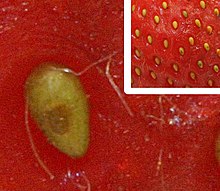
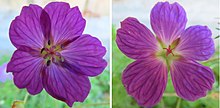
Geranium incanum Цветки актиноморфны , имеют пять осей симметрии, в отличие от двух осей симметрии зигоморфных цветков большинства видов родственного рода Pelargonium .

Вея папоротника с заостренными листочками
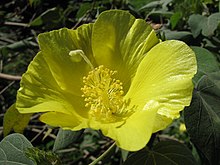
Адельфные тычинки цветка Gossypium tomentosum

ватсонии Цветок открыт, одна тычинка загнута вверх, чтобы показать приросшее к лепестку прикрепление.

Схема плода кокоса. Белок . имеет обозначение Alb (эндосперм )
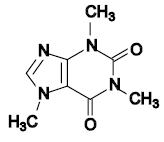

Лист ротмании с обширным анастомозным жилкованием.

Андрогинный цветок Sandersonia aurantiaca разрезан продольно, чтобы увидеть андроцей , состоящий из пыльника , окружающего зеленый центральный пестик.


Вид Neea , семейство Nyctaginaceae , представляет собой пример антокарпа : чашечка и столбик остаются вокруг созревающих плодов.

Бесцветные цветки дубов, таких как Quercus robur , будучи анемофильными , не нуждаются в том, чтобы привлекать внимание животных-опылителей.

Верхушечная почка побега Populus (тополя)

На первый взгляд отдельные орехи Ochrosia borbonica на самом деле представляют собой апокарпные плодолистики , по два от каждого цветка.
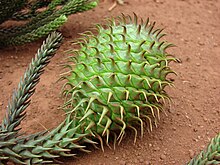
Апофизы на кончиках чешуек шишек Araucaria cunninghamii представляют собой шипы.

Волоски на листьях Meniocus linifolius (ранее Alyssum linifolium ) звездчатые и прижаты к поверхности листа.

Паукообразные листья неопознанного Gazania вида
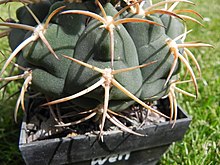

Семена вида Blighia (ackee), одно целое и одно в продольном разрезе, с бледными прилежами.


Анатомия ости и щетинок вида австралийской травы Rytidosperma longifolium.

Пазушные почки листа
Б
[ редактировать ]- баккат
- Плод выглядит как ягода, которая может быть настоящей ягодой, а может и не быть. [22]
- палочковидный
- Палочковидный; длиннее, чем ширины. Сравните цилиндрические .
- колючка
- Острие, обращенное назад, как у рыболовного крючка .
- колючий
- Зазубрины направлены в одном направлении.
- усач
- Наличие колючих волос ( усиков ).
- лаять
- ткани на стеблях и корнях древесных Защитный внешний слой деревьев и кустарников; включает все живые и неживые ткани, находящиеся вне камбия .
- базальный
- Расположен или прикреплен к основанию или близко к нему (растения или диаграммы филогенетического дерева ).
- фиксированный
- Что-то прикрепленное к его основанию, например, пыльник, прикрепленный к нити . Сравните спинно-фиксированные .
- базипетальный
- Развиваются последовательно от верхушки к основанию (т. е. от самых молодых к основанию), например, цветков в соцветии . Также переход от листьев к корням, например, молекулярных сигналов в растениях.
- батифилл
- Специализированный лист, образующийся у основания растения, обычно когда растение еще незрелое, и служит для прикрепления растения к субстрату; особенно заметен у папоротника Teratophyllum . Контрастный акрофилл .
- клюв
- Выступающий, заостренный концевой выступ, особенно плодолистика или плода .
- ягода
- Разновидность нераскрывающихся плодов с семенами , погруженными в мякоть, например помидор .
- с-
- Префикс, означающий «два», например, двубороздчатый , имеющий две бороздки или бороздки.
- раз в два года
- Растение, которое завершает свой жизненный цикл (т. е. прорастает, размножается и умирает) в течение двух лет или вегетационного периода. Двулетние растения обычно образуют прикорневую розетку листьев в первый год, а затем цветут и плодоносят на второй год.
- раздвоенный
- Раздвоенный; разрезать пополам примерно на половину длины. Сравните трехраздельный .
- двулистный
- ( сложного листа ) Имеющий ровно два листочка , обычно в симметричной паре, например, лист Colophospermum mopane . Сравним ямчато- лопастные листья , например, у большинства видов Bauhinia .
- раздвоенный
- Веретеновидная форма с защемлением посередине.
- двугубый
- Наличие двух губ, например, форма лепестка у многих неправильных цветов.
- двусторонний
- 1. Наличие двух различимых сторон, например, две стороны дорзивентрального листа.
- 2. Расположены на противоположных сторонах, например листья на стебле ; Сравните двусторонние и противоположные .
- 3. Двусторонне-симметричные, как у листа с симметричным очертанием.
- двугнездный
- Наличие двух гнезд , например, в пыльниках или завязях .
- биномиальный
- Использование названий, состоящих из двух слов, для образования научного названия (или сочетания) в латинской форме. Например, где первое — это название рода , к которому принадлежит вид , а второе — видовой эпитет, данный этому виду, чтобы отличить его от других представителей того же рода.
- биномиальная номенклатура
- Система номенклатуры, в которой научное название вида ( а не таксона любого другого ранга) представляет собой комбинацию двух названий, первое из которых является родовым названием . Второе название в ботанике упоминается как видовой эпитет . Обратите внимание, что два имени вместе (а не только второе имя) составляют название вида.
- двуперистый
- Двойноперистые ; например, сложный отдельными листочками . лист с перисто разделенными
- двуперисторассеченный
- Лист перисто-рассеченный . с глубоко рассеченными сегментами
- бисексуальный
- Имеющие как мужские, так и женские репродуктивные органы; обычно цветки как с тычинками , так и с плодолистиками ; синоним гермафродита , синоэтического и моноклинного . Обоеполые цветки встречаются только на однодомных растениях. См. также андрогинную , одноцветную и репродуктивную морфологию растений .
- битегмический
- (семяпочки ) Покрыта двумя покровами s. Контраст унитегмический .
- двучленный
- Тернате , где каждое деление разделено на три.
- двустворчатый моллюск
- Имеющие два клапана или навесные детали. Контрастный трехстворчатый клапан .
- лезвие
- Пластинка или или уплощенная часть листа , исключая черешок черешок .
- цвести
- Мелкий белый или голубоватый восковой порошок, образующийся на частях растений, обычно на стеблях, листьях и плодах. Он легко удаляется втиранием.
- хорошо
- Ствол . дерева, обычно часть под самой нижней веткой Сравните навес .
- бострихоидный
- Расположен на конической поверхности (как раковина улитки); используется для описания соцветий , в которых почки расположены почти спирально на внешней стороне длинного, сужающегося, конического стержня .
- прицветник
- Видоизмененный лист, связанный с цветком или соцветием и отличающийся по форме, размеру или цвету от других листьев (и без пазушной почки ).
- брактеат
- Имеющий прицветники s.
- прицветник
- Небольшой прицветник , расположенный поодиночке или парами на цветоножке или чашечке ; синоним прицветника .
- прицветник
- Имеют прицветники (прицветники).
- прицветник
- Наличие множества или эффектных прицветников . [23]
- прицветник
- См . прицветник .
- ветка
- Небольшой филиал .
- скоротечный
- Растение, которое лишь на короткое время теряет все свои листья перед тем, как вырастить новые, поэтому оно остается безлистным лишь на короткое время, например, примерно две недели.
- щетина
- Прямые, жесткие волосы (гладкие или с мелкими зубцами); верхняя часть ости ( когда последняя согнута и имеет нижнюю, более толстую и обычно скрученную часть, называемую столбиком ) .
- брохидодромный
- Перистое жилкование листа , при котором вторичные жилки не заканчиваются на краю листа , а соединяются в ряд выступающих дуг .
- брошюра
Ширина одного просвета сети пыльцевого зерна и половина ширины окружающих мури (стенок), следовательно, гетероброхата и гомоброхата , где просветы имеют разные или одинаковые размеры соответственно.
- мохообразный
- Неофициально — любое растение, представляющее собой мох , роголистник или печеночник . Формально эти растения относят к трем отдельным отделам: роголистникам ( Anthocerophyta ), печеночникам ( Marchantiophyta ) и мхам ( Bryophyta ).
- лампочка
- Толстый запасающий орган, обычно подземный, состоящий из стебля и оснований листьев (внутренние мясистые).
- луковица
- Луковица , возникающая из другой луковицы. См . буклет .
- луковица
- Небольшая листопадная луковица или клубень , образующаяся в пазухе листа или ушной раковины ; средство вегетативного размножения.
- лампочка
- Луковица , возникающая из другой луковицы; лампочка .
- терроризировать
- 1. Иметь округлую или пузырчатую форму; арочные или сводчатые.
- 2. (листа) Наличие изогнутой ткани листа между каждой боковой жилкой, т. е. жилки кажутся вдавленными на поверхности листа.
- кап
- Деформация или сучок ветвей или ствола дерева, иногда встречающийся в деревообработке. [24]
- картавить
- 1. Колючий фрукт .
- 2. Шероховатый или колючий побег, состоящий из семени или плода и связанных с ними частей цветка или прицветников .
- опорный корень
- Корень , растущий из надземного стебля или ствола и обеспечивающий опору, например, обычно у Ficus macrophylla .

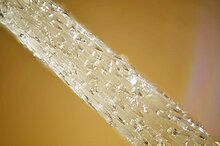
Шипы . встречаются на колючках некоторых видов кактусов, как показано здесь в увеличенном виде


Двулистные . сложные листья дерева мопане Colophospermum mopane предполагают общее название «дерево-бабочка»

Поперечное сечение стручка Arabidopsis thaliana , показывающее, что он двудольный , состоит из двух плодолистиков , морфологически представляет собой стручок, а не стручок.


Строение двучленного сложного листа

Этот африканский баобаб, Adansonia digitata , имеет огромный ствол под относительно скромным пологом , типичным для этого вида.

Большие красочные бугенвиллии прицветники часто . путают с ее лепестками

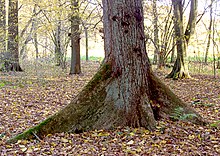
Опорный корень зрелого вяза
С
[ редактировать ]- худощавый
- Раннее опадание, например чашелистики маков, которые опадают, когда лепесток начинает раскрываться. Сравните стойких и беглых .
- дерн
- Хохлатая или дерновая, например, форма роста некоторых трав.
- калькарат
- обладающий шпорой .
- известковый
- Тип почвы или тип породы с лишайниковым субстратом, богатый карбонатом кальция или в значительной степени состоящий из него .
- кальцеолатный
- По форме напоминает тапочки. [25]
- исчисления
- Растение, произрастающее на известковой почве. Также кальцифил , кальцифит . Антоним : кальцифуг . [25]
- мозолистый
- Закаленный; утолщенный; бессердечный.
- мозоль
1. Выступающая масса ткани
- 2. Недифференцированный тканевый разрастание, образующееся в ответ на ранение; можно выращивать in vitro .
- 3. У орхидей - мясистые выросты губки , которые могут иметь различную форму от сосочков до пластинок.
- 4. У трав - затвердевшее отросток от основания цветка ( образующийся из сустава рахиллы и/или основания цветковой пластинки ), который может удлиняться, а может и не удлиняться и часто покрыт волосками или щетинками.
- чашечноцветковый
- прикреплены лепестки и тычинки К чашечке .
- каликофилл
- Листовидная структура, образованная из чашелистика или доли чашечки , которая увеличивается, обычно во много раз, до или после цветения , особенно когда большинство других чашелистиков или долей чашечки сохраняют свой первоначальный размер. Более экстремальные, чем нарастающая чашечка, каликофиллы встречаются у Rubiaceae . Сравните семафилл и птерофилл .
- подсчитывать
- Наличие эпикаликса .
- чашечка
- 1. Чашевидная структура, образованная из прицветников , напоминающая внешнюю чашечку .
- 2. У некоторых сложноцветных — круг прицветников под оберткой .
- калиптра
- Капюшон или крышка. См . оперкулум .
- чашечка
Собирательный термин для чашелистиков одного цветка; внешняя мутовка цветка, обычно зеленая. Сравните Короллу .
- трубка чашечки
- Трубка, образованная слиянием чашелистиков ( чашечки ), по крайней мере, у основания.
- камбий
- Слой ткани, обеспечивающий частично недифференцированные клетки для роста растений.
- колокольчатый
- Колоколообразный.
- камптодромный
- Перистое жилкование, при котором вторичные жилки изгибаются к краям, в некоторых случаях становятся почти параллельными им и не соединяются повторно с другими жилками, образуя петли.
- кампилотропный
- Когда семяпочка ориентирована поперечно (т. е. ее ось перпендикулярна ножке) и с изогнутым зародышевым мешком . Сравните амфитропные , анатропные и ортотропные .
- канализировать
- Направленный; имеющий продольную канавку.
- канесцентный
- Цвет приближается к белому, как у листа, покрытого белым пухом или шерстью.
- навес
- Ветви и листва дерева; корона . Также относится к защитному верхнему ярусу леса. Сравните багажник .
- капиллярный
- 1. Трубка, пора или канал с узким внутренним поперечным сечением.
- 2. Стройный; похожий на волосы.
- случаться
- 1. (соцветия ) Имеющий шишковидную головку, цветки без стеблей, собранные в плотную гроздь.
- 2. (рылья ) Как булавочная головка.
- глава
- Плотное скопление сидячих или почти сидячих цветков или соцветий , например, цветочная головка семейства маргариток семейства Asteraceae . См . псевдантиум .
- капсула
- Сухие плоды, образованные из двух или более соединенных плодолистиков , при созревании раскрываются (обычно раскалываются на части или раскрываются на вершине зубцами или порами).
- кардуоидный
- У Asteraceae столбик с кольцом широких волосков , расположенных на стержне столбика под ветвями столбика.
- Карина
- См . Киль .
- Каринальный канал
- Продольная полость в стеблях Equisetum , совпадающая и вымерших Equisetopsida с гребнем на поверхности стебля.
- плотоядный
- Телесного цвета, особенно при нанесении на некоторые цветы.
- карнозный, плотоядный
- Мясистая или мясистая текстура, особенно при нанесении на некоторые ткани или органы. Контраст кожистого и рогового .
- Кароподий
- Род цветковых растений семейства Зонтичные . Родной ареал: от Турции до Ирана. Не путать с карпоподием.
- плодолистик
- Основной женский репродуктивный орган покрытосеменных растений , состоящий либо из одного спорофилла , либо из одного гнезда сложной завязи , со столбиком и рыльцем . Гинецей — собирательный термин для обозначения всех плодолистиков одного цветка .
- карпеллярный
- Что касается плодолистиков или связанных с ними структур или выростов плодолистиков, например стаминодии, прикрепленные к плодолистикам у Nymphaeaceae, их часто называли плодолистиками . Текущее и прошлое использование терминов «запястные прикрепления», «паракарпели» и «стаминодии » запутано и варьируется среди авторов.
- карпоподий
- На семянках (Cypselae) удлинение основания гинецея , которое выглядит отчетливым; зона отрыва , где семянка отделяется от сосуда .
- 2. Род Carpopodium семейства Brassicaceae ; не путать с Кароподием .
- хрящевой
- Твердый и жесткий; хрящевой. Сравните роговой и кожистый .
- мясца
- Небольшой кусочек плотеподобной ткани, обычно комковатой или бородавчатой, растущий на семеннике возле ворот . Контраст Арил .
- зерновка
- Сухой, нераскрывающийся , односемянный плод , у которого семенная кожура плотно срослась с стенкой плода, как, например, у большинства трав.
- Каспарская полоса
- Непрерывная полоса суберина в радиальных первичных клеточных стенках эндодермы в стеблях и корнях сосудистых растений, которая образует проницаемый барьер для пассивной диффузии внешней воды и растворенных веществ в сосудистую ткань.
- кассовый
- В форме капюшона, шлема или чепчика; обычно относится к цветочной анатомии, например, у цветов Aconitum , Satyrium и т. д.
- катастрофический
- Цвет каштановый, красновато-коричневый. [26]
- случайный инопланетянин
- Экзотическое растение, которое появляется без видимой помощи человека, но не образует устойчивой популяции или которое сохраняется только за счет повторных новых интродукций. Сравните инопланетянина .
- катафилл
- Любая структура растения, морфологически представляющая собой лист , но выполняющая в лучшем случае случайную или временную фотосинтетическую функцию. Они либо теряются, когда их основная функция завершена, либо включаются в структуры, где, будучи мертвыми, они служат защитной или поддерживающей цели.
- цепочка
- В форме цепочки; образованы из частей или клеток, соединенных друг с другом как бы в цепочку, например, некоторые диатомовые водоросли , водоросли и цианобактерии , такие как Anabaena . См. также конкатенация .
- серёжка
- Колос , основном мелкие цветки однополые и и без заметного околоцветника , например у ив , тополей , дубов , обычно висячий, у которого в казуаринов . Отдельные цветки часто имеют чешуйчатые прицветники и обычно опыляются ветром . Сережки обычно сбрасываются как единое целое.
- хвостатый
- Наличие узкого, похожего на хвост придатка или кончика, например капельного наконечника . Контрастируют остроконечные , остроконечные и мукронированные .
- каудекс
Стебель ; растения, деревянистого особенно также используется для обозначения подвоя или, в частности, структуры базального стебля или запасающего органа, из которого возникает новый рост. Сравните лигнотубер .
- хвостовидный
- Стеблевидные или каудексоподобные ; иногда используется для обозначения « пачикаул », что означает «толстый стебель».
- они будут расти
- обладающий хорошо развитым стеблем надземным , похожим на стеблевой . Антоним : бесстебельный (без видимой основы).
- цветная капуста
Цветы или плоды, растущие прямо на ветвях или стволе дерева. [27]
- стебель
- Переносится на воздушном стебле или стебле , как и в случае с листьями, цветами или плодами (применительно к двум последним органам обычно имеется в виду более старые стебли).
- каулиросулят
- Растет на конце стебля или стебля , как и листья или прицветники.
- клетка
- 1. Основная микроскопическая единица структуры растения, обычно состоящая из отделений вязкой жидкости, окруженных клеточной стенкой .
- 2. Полость пыльника или завязи .
- сенантовый
- (околоцветника , ) Не имеет ни тычинок ни пестика , т.е. цветок без андроцея и гинецея .
- центрифицированный
- Орган с двумя разветвлениями, прикрепленный центром, например волос или пыльник .
- шероховатый
- Имеющие восковой вид, цвет или текстуру, например, цветы многих видов Ceropegia и восковые плоды некоторых видов Myrica .
- придирчивый
- Кивает, падает головой вниз или лицом вниз; наклоненный, ссутулившись или наклонившись вперед. кивать и сутулиться Применяется ко многим видам с привычкой , например, ко многим Narcissus и Dierama видам . Многие виды растений носят видовой эпитет « цернуа ».
- дерматоз
- Альтернативное написание слова caespitose , что означает пучковый или дерновый, например, форма роста некоторых трав.
- камера
- Полость яичника .
- направленный
- Опущен под поверхность, образуя округлый канал.
- мелистый
- Имеет бумажную текстуру.
- хазмогамный
- Из цветков, опыляющихся при околоцветнике раскрытом . Сравните клейстогамные .
- хазмофит
- Растение, приспособленное к произрастанию в расщелинах или впадинах, например, на скалах. Сравните кремнофиты . [28] [29]
- химера
- Особь, состоящая из двух или более генетически различных тканей, чаще всего в результате трансплантации , а иногда и в результате мутаций, возникающих во время деления клеток или переноса клеток во время развития семян.
- хироптерофильный
- Опыляется летучими мышами .
- хлорофилл
- Любой из множества различных химических пигментов в хлоропластах , которые необходимы для фотосинтеза .
- хлоропласт
- Органелла растительной клетки , содержащая хлорофилл .
- хлороз
- Аномальное отсутствие или бледность цвета обычно зеленого органа.
- реснички
Очень маленькие волоски или волосоподобные выступы, более или менее приуроченные к краям органа, как у ресниц; в подвижных клетках имеются мельчайшие, похожие на волоски выступы, которые способствуют подвижности .
- черный
- Пепельного цвета, сероватый, обычно из-за покрытия короткими волосками; несколько темнее канесцентного .
- круг
- Спирально закрученные кончиком внутрь, например, кольцевая вернация развивающихся листьев большинства папоротников.
- цирроз печени
- (листа) заканчивается усиком На верхушке .
- перистые
- См . усик .
- кладода
- ветвь Фотосинтетическая . или стебель , часто листовидная и обычно с листьями, которые либо отсутствуют, либо сильно редуцированы Сравните филлоды .
- сорт
- Основная категория для ранжирования таксонов между отделом и порядком .
- клатрат
- По форме напоминает сетку или решетку; пронизанная отверстиями, как клетка.
- булавовидный
- Клубообразный.
- ключица
- У Apocynaceae — увеличенное рыльце барабанной формы , боковые и нижняя поверхность которого являются рецептивными зонами. Согласуется с пыльником или нет.
- коготь
- 1. Узкая стебельчатая базальная часть лепестка , чашелистика или прицветника .
- 2. У Melaleuca — объединенная часть пучка тычинок .
- клейстогамный
- Цветы, которые самоопыляются и никогда не раскрываются полностью, или которые самоопыляются до раскрытия. Сравните хазмогамных .
- альпинист
- Растение, растущее более или менее прямо , опираясь на другую конструкцию или обвивая ее для поддержки, или цепляясь усиками .
- восхождение
- Смотрите альпинист .
- клин
Непрерывное морфологическое изменение формы внутри одного вида, а иногда и между двумя видами.
- клонировать
- Растение, полученное в результате бесполого вегетативного размножения родительского растения, причем оба растения имеют идентичный генетический состав.
- сливающийся
- Части растения сливаются или срастаются вместе, образуя единое целое.
- улитковообразный
- Вогнутая и ложкообразная.
- улитка
- Свернутый, как раковина улитки.
- монастырь
- Организованная колония водорослей , действующая как единый организм.
- ценоцит
- Одна клетка с несколькими ядрами , образовавшаяся, когда деление ядра не сопровождалось цитокинезом .
- колеоптиль
- Один тип оболочки в строении однодольных семян. Колеоптиль представляет собой защитную оболочку или колпачок ( пилеус ), обычно более или менее заостренный, который покрывает однодольное перо , когда оно выходит из почвы. Обычно он становится зеленым и участвует в фотосинтезе до тех пор, пока его функция не будет заменена основным ростом рассады. Сравните это с колеоризой , которая остается под землей до тех пор, пока не вытесняется по мере появления корней.
- колеориза
- Один тип оболочки в строении однодольных семян. Колеориза соединяет колеоптиль с корешком и защищает корешок однодольного растения во время прорастания. В отличие от колеоптиля колеориза связана с корнем и при прорастании не выходит из почвы. Контрастный колеоптиль .
- колленхима
- Специализированная ткань, состоящая из живых клеток с неравномерно утолщенными целлюлозными и пектиновыми клеточными стенками , выполняющая опорную функцию в таких органах, как листья и молодые стебли, состоящие из первичных тканей растения.
- коллекционер
- Многоклеточные железистые волоски, которые обычно выделяют слизистое вещество и расположены на чашелистиках , прилистниках или черешках или на близлежащих частях стебля ; Обычно встречается на растениях отряда Gentianales .
- колумелла
- У цветковых растений центральная ось шишки или плода , например у Каллитриса .
- столбец
- 1. Структура, простирающаяся над завязью и включающая столбик и тычинки , также известную как гиностегий , например у орхидей и молочаев .
- 2. У трав нижняя, более толстая и обычно закрученная часть ости , отличная от тонкой верхней части или щетинки.
- столбчатый
- По форме напоминает колонну.
- есть
- 1. Пучок волосков из семени или канатика на одном или обоих концах некоторых семян, например у Sстрофантуса , Асклепиаса или Альстонии .
- 2. Стерильные прицветники , например, у Curcuma , Ananas или Eucomis .
- 3. Стерильные цветки , например у мускари и леопольдии , на верхушке некоторых соцветий .
- 4. Пучок волосков у основания некоторых цветков, например, у Pfaffia gnaphalioides .
- 5. Пучок волосков на верхушке или основании некоторых колосков .
- 6. Пазушной пучок волосков в соцветиях у некоторых Poaceae , например у Eragrostis comata .
- коммерческое название
- Название часто не имеет ботанического значения и не регулируется ICNCP . Этот термин обычно применяется к таким названиям, как названия товарных знаков, имена, на которые распространяются права селекционеров, патенты и рекламные названия, которые часто используются для увеличения продаж растения.
- спайка
- Шов или лицевая сторона, на которой склеиваются два плодолистика . См. также трещина и шов .
- сообщество
- Экологическая совокупность растений, которые обычно встречаются вместе.
- сложный
- Состоит из нескольких частей, например лист, состоящий из нескольких листочков , гинецей, состоящий из нескольких плодолистиков , или соцветие, состоящее из множества более мелких соцветий.
- сложная пальмовая ветвь
- исходят Листочки из центральной точки (обычно на верхушке черешка ) , как растопыренные пальцы, исходящие от ладони. Сравните пальмат .
- сжатый
- Уплощены в длину либо с боков (из стороны в сторону), либо сверху (спереди назад).
- объединять
- Соединены в цепочку. См. также конкатенация и катенат .
- одноцветный
- Иметь одинаковый цвет повсюду; однородно окрашены.
- соучастник
- Расположены таким образом, что две стороны плоской поверхности согнуты по средней линии и обращены друг к другу. См. также ptyxis , aestivation и vernation .
- конус
- Тип плодов , обычно древесных , от яйцевидных до шаровидных , включая чешуйки , прицветники или прицветники, расположенные вокруг центральной оси, например, у голосеменных , особенно у хвойных и казуарины .
- соцветие
- Редко используемый термин, описывающий существенные различия между общей структурой соцветия и структурой его отдельных ветвей, например, многоцветковая головка бутылочной щетки у представителей рода Callistemon .
- родственный
- Слит с другим органом (или органами) того же типа, например, галепетальной с лепестками трубки венчика . Сравните аднат .
- соединительный
- Часть пыльника , соединяющая клетки пыльника.
- попустительство
- Соприкосновение или сближение.
- сородичей
- Принадлежность к одному и тому же виду .
- смежный
- Соприкасаясь, соприкасаясь, но не соединяясь.
- искажать
- (из чашелистика или лепестка ) Тип черепичной эстивации , при которой одна сторона каждого сегмента перекрывает один из соседних сегментов, а другая сторона перекрывается другим соседним сегментом. См . свертку .
- искаженный
- Вывернут из обычной формы.
- сворачивать
- 1. Относится к расположению цветочных или лиственных органов в бутоне , когда каждый орган или сегмент имеет один край, перекрывающий соседний орган или сегмент; форма черепичной композиции. См . искажение .
- 2. ( листьев ) Вид вернации , при которой один лист сворачивается внутрь другого.
- 3. Вид вернации двух листьев в узле , при котором одна половина каждого листа обнажена, а другая половина завернута внутрь другого листа.
- коркуль
- растения Зародыш , перышко или перышко плюс корешок .
- сердцевидный
- Сердцевидная, с самой нижней выемкой; основания листа , как выемчатая часть сердца. Контраст некордантный .
- кожистый
- Кожистый; жесткий и жесткий, но гибкий. Сравните роговой .
- клубнелуковица
Мясистое, вздутое основание стебля , обычно находящееся под землей и выполняющее функции хранения запасов пищи, с почками голыми или покрытыми очень тонкими чешуйками ; разновидность подвоя .
- Кормель
- Небольшая клубнелуковица (или клубнелуковица), образующаяся у основания растущей клубнелуковицы. [30]
- роговой
- Роговой по текстуре; жесткий и твердый, но несколько жесткий. Сравните кожистые .
- венчик
- Собирательное лепестков цветка . название Сравните чашечку .
- корона
- 1. У цветковых растений - кольцо образований, которые могут объединяться в трубку, исходящие из венчика или околоцветника цветка и стоящие между долями околоцветника и тычинками . Труба нарцисса – это корона.
- 2. У трав - затвердевшее кольцо ткани, прикрывающее чешуйку . у некоторых видов
- кора головного мозга
Область ткани, расположенная между поверхностными клетками и сосудистым цилиндром . [31]
- кортикальный
- Растет на коре или на древесине со снятой корой. Сравните лигникоидный .
- щиток
Соцветие с ветвями , растущими в разных точках, но достигающими примерно одинаковой высоты, что придает цветочной грозди вид с плоской верхушкой.
- Коста
- Ребро .
- реберный партнер
- Имеет выраженную жилку (среднюю жилку), в отличие от типичного пальчатого или веерного листа, но с радиальным расположением листочков , как у пальчатого листа.
- семядоля
- Первичный лист или листья зародыша растения, которые при прорастании развиваются в семенной лист или первый набор листьев.
- краспедодромный
- Перистое жилкование , при котором вторичные жилки оканчиваются по краю s, часто зубцами.
- кратерообразный
- В форме блюдца или неглубокой чашки; полусферическая или более мелкая.
- кремнофит
- Растение, приспособленное к росту на скалах или расщелинах, особенно висящих на них. Сравните хазмофитов . [28] [29]
- городчатый
- Имеющие тупые или закругленные зубы; зубчатый .
- зубчатый
- Мелко зубчатый.
- хрустящий
- Мелко закрученные, как края листьев и лепестков.
- ячейка Кристарка
- Склереид , который содержит друзу и имеет лигнин, отложенный эксцентрично на клеточной стенке , образуя чашеобразную форму или в поперечном сечении - ∪-образную форму.
- корона
- Смотрите навес .
- крест
- Произвести скрещивание чего-либо; акт гибридизации.
- крестообразный
- Крестообразный.
- ракообразный
- Твердый, тонкий и хрупкий.
- покрытый коркой
- Образует плотно прилегающий поверхностный слой или корку.
- криптогама
- Любое из «низших растений», образующих споры и не имеющих тычинок , завязей или семян ; буквально, растения, половые репродуктивные органы которых не заметны. В эту группу обычно входят папоротники , мохообразные и водоросли , а иногда и грибы (включая лихенизированные грибы). Сравните фанерогам .
- кукушка
- Капюшон или капюшон, обычно относится к форме листьев или лепестков, например Pelargonium cucullatum . Аналогично производные термины включают cuculliform и cuccularis .
- стебель
- У трав, осоки, камыша и некоторых других однодольных — воздушный стебель , несущий соцветие , простирающийся строго от основания растения до самого нижнего оберточного прицветника (или основания соцветия).
- культиген
- Растение, происхождение или селекция которого обусловлены прежде всего целенаправленной деятельностью человека.
- сорт
- Термин, происходящий от «культурного сорта», обозначающий совокупность культивируемых растений, четко отличающихся одним или несколькими признаками (морфологическими, физиологическими, цитологическими, химическими или другими). При воспроизведении (половым или бесполым путем) совокупность сохраняет свои отличительные признаки. Сорт может возникнуть в культуре или быть завезен из дикой природы. Это вариант, представляющий садоводческий интерес или ценность. Названия сортов пишутся в одинарных кавычках, например «Blue Carpet» или «Alba». Все новые названия, установленные после 1 января 1959 года, должны быть на общеупотребительном языке (то есть не на латыни), но имена, созданные на латыни до этой даты, сохраняются в латинской форме.
- Эпитет сорта
- Определяющая часть названия, обозначающая сорт . Сорта обозначаются причудливыми (см.) эпитетами, присоединяемыми либо к научному названию, либо к общему названию таксона, к которому они принадлежат; они не выделяются курсивом, а заключаются в одинарные кавычки, например, Rubus nitidoides «Merton Early». «Мертон Эрли» — эпитет сорта.
- клиновидный
- Клиновидной формы, с прямыми сторонами, сходящимися у основания.
- чашка
- Чашеобразная структура, состоящая из сросшихся прицветников , такая как чашечка желудя . См . Калибий .
- купольный
- По форме напоминает купулу .
- куполообразный
- Несущие купулы .
- купуловидный
- Почти полусферическое, по форме напоминающее купол или купол.
- острие
- Твердый заостренный кончик, более жесткий и грозный, чем мукро , поэтому заостренный .
- острие
- На кончике имеется острие , как у некоторых листьев.
- кутикула
- Гидроизоляционный слой, покрывающий поверхностей растений эпидермис надземных и состоящий из полимеров кутина и/или кутана и восков.
- резка
- Верхушка побега , . , корень или лист срезанная с растения и используемая для бесполого вегетативного размножения
- чашка
Соцветие цветков , из однополых окруженное оберточными прицветниками , особенно цветки молочай .
- циатофилл
- У Euphorbia - прицветниковая структура, на которой расположена обертка , обычно, но не всегда, состоящая из двух частей. Иногда они могут быть ярко окрашены и их можно спутать с лепестками .
- цилиндрический
- Палочковидные, длина в два-три раза больше ширины. Сравните палочковидные .
- цинароид
- См . Кардуоид .
- цим
Тип соцветия , у которого главная ось и все боковые ветви оканчиваются цветком ( каждая боковая может быть многократно разветвленной).
- цимозный
- Наличие цимеса или цимеса.
- ципсела
- Сухие односемянные нераскрывающиеся плоды , образующиеся из нижней завязи .
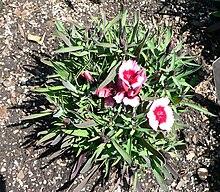
Dianthus chinensis имеет травянистый рост.


Структура цветка орхидеи рода Praecoxanthus с каллуса . маркировкой

Бородатый каллус цветка травы вида Chrysopogon filipes

Сканирующая электронная микрофотография карпоподия у основания семянковидного плода Зизюра майана , Asteraceae.

Спящие почки листьев лиственных деревьев обычно защищены черепитчатыми катафиллами , которые опадают при прорастании почек.


Каудекс растет преимущественно Dioscorea slotipes над поверхностью почвы. Многие виды, образующие каудисы, выращивают их под землей.
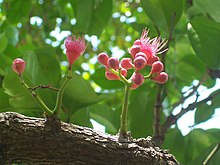
Цветы, растущие из ветки Syzygium moorei , пример цветной капусты.

Некоторые представители рода Espeletia характер роста демонстрируют стеблевидный .

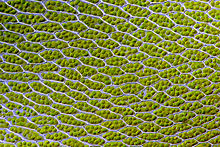
Хлоропласты в клетках листьев мха Bryum capillare

Не все хлоропласты имеют простую форму. Хлоропласты спирогиры имеют спиральную форму внутри трубчатых клеток нитей водорослей.
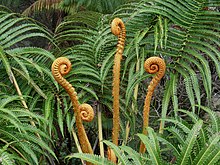

Так называемые «мясистые листья» кактусов, например, у Opuntia tomentosa , на самом деле представляют собой кладоды . (ветви) Настоящие листья — это шипы , растущие на кладодиях, которые на этой молодой кладоде еще мясистые.

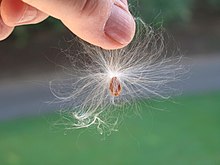

Куркума псевдомонтана с красными комы прицветниками

Цветки Pfaffia gnaphalioides с прикорневыми комовыми волосками .

Кома на вершине Muscari Armeniacum со стерильными цветками.
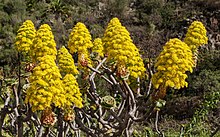
Конусообразное сложное соцветие Aeonium arboreum представляет собой сложную метелку, состоящую из мелких метелок, некоторые из которых, в свою очередь, сложные.

Калифорнийский конский каштан ( Aesculus Californica ) имеет сложный пальчатой лист, листочки расходятся от центральной точки.


Casuarina equisetifolia мужские и женские цветки шишки и

Гамолепестный цветок Watsonia раскололся между двумя лепестками, показывая сросшееся образование трубки венчика ; сравните сросшиеся основания тычинок с соответствующими лепестками

Клубнелуковица . , одна целая в тунике туники , одна частично очищенная, чтобы показать катафиллы , и одна разделенная, чтобы показать внутреннюю структуру
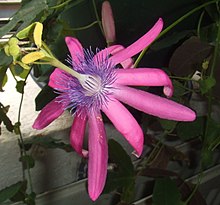
Венчик представляет этого цветка пассифлоры собой кольцо из пурпурных нитей между лепестками и тычинками .

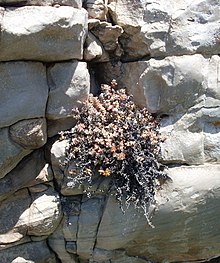

Nymphoides crenata имеет городчатые края листьев.

Mimetes cucullatus , названный так из-за куполообразной, куполообразной формы белых цветков.

Муррайя метельчатая имеет листья с клиновидным (клиновидным) основанием.


Заостренные листья Diplacus bigelovii var. куспидат
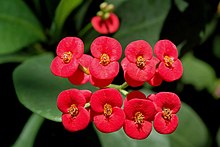
Euphorbia milii выращивается в коммерческих целях из-за эстетического внешнего вида ее ярко окрашенных, похожих на прицветники структур, называемых , циатофиллами которые расположены под соцветием .
Д
[ редактировать ]- лиственный
- Расслаиваются и опадают сезонно, как кора , листья или лепестки . Контраст стойкий .
- отклонить
- На кончике изгибается вниз, а затем вверх. Часто квалифицированный, например, склоняющийся к восходящему.
- разлагать
- Разделен более чем на один уровень, например, в двуперистых листьях, в которых листочки того, что в противном случае было бы перистым листом, сами перисто разделены.
- украшать
- 1. (внутр. v.) Сбрасывать внешнюю кору дерева, обычно сезонно, как часть естественного цикла роста.
- 2. (tr. v.) Снятие кожуры, корки, коры или других поверхностных тканей с растения или собранного материала, например, при извлечении клетчатки из собранных листьев агавы .
- лежачий
- Имеет ветви, растущие горизонтально вдоль земли, но загнутые на концах.
- они бегут вниз
- Вытягивается вниз за пределы точки прикрепления , например, когда основание листа или жабры гриба вытянуты вниз вдоль стебля в виде приподнятой линии или узкого крыла.
- перекладина
- Синоним перекрестного ; использование decussant сомнительно и происходит редко, вероятно, по ошибке. Формально правильное использование — перекрестное .
- перекрещивать
- Напротив , последовательные пары расположены под прямым углом к последней; обычно применяется к расположению листьев .
- определенный
- Постоянного числа, например, в два раза больше тычинок , чем лепестков или чашелистиков (или меньше), или соцветие, оканчивающееся цветком , или прерванный цветочный бутон , обычно цимозное соцветие. Контраст неопределенный .
- изогнутый
- Наклонился вниз. Контраст повышен .
- раскрывающийся
- Взлом по достижении зрелости для высвобождения содержимого; относится, например, к раскрытию плодов для высвобождения семян , пыльников для высвобождения пыльцы и спорангиев для высвобождения спор . Контраст нераскрытый .
- дельтовидная мышца
- По форме напоминает заглавную греческую букву Δ , то есть более или менее равносторонний треугольник.
- Дендроид
- Древовидный ; ветвящийся как дерево.
- зубчатый
- Зубчатые , особенно по листа краю .
- зубчатый
- Мелкозубчатая ; уменьшительная форма зубчатого .
- пустынный
- Обитающий в пустыне.
- определенный
- Ограничен, как правило, в росте. Контраст неопределенный .
- диадельфный
- Относится к классу адельфических структур, в которых тычинки или аналогичные органы соединены в две адельфии вместо одной.
- диаспора
- Любая репродуктивная часть растения, приспособленная для расселения и образования новых растений; может быть рассеянным, например, семенем , или другими частями, например, специализированными бутонами , ветвями, соцветиями или плодами.
- дихазий
- Цимозное правильными соцветие со всеми ветвями ниже верхушечного цветка, расположенными супротивными парами. Сравните монохазиум и плейохазиум .
- двухламидный
- Околоцветник разделен на отдельные чашечку и венчик . Сравните гомохламидных .
- дихотомический
- Разветвление на две равные ветви. Это может быть результатом равного деления кончика роста или может быть симподиальным , при котором кончик роста прерывается и заменяется. Обычно относится к способу роста ветвей, как у Aloidendron dichotomum , но также и к другим органам, таким как рисунок жилкования на листьях, шипы различных видов Carissa (которые морфологически являются ветвями), а также слоевища или гифы различных водорослей и водорослей. грибы.
- двудольные
Цветковое растение, зародыш которого имеет две или более семядоли (семенные листья). Контраст однодольных .
- тип
- С сегментами, расходящимися из общего центра, как пальцы руки. См. также пальчатые и пальчатые . См. также Форма листа .
- пальцевидный
- По форме напоминает палец.
- диморфный
- Встречается в двух различных формах (по форме и/или размеру), например, в виде тычинок , листьев или листьев. См. также мономорфные (имеющие одну форму) и полиморфные (имеющие множество форм).
- раздельнополый
- (сосудистых растений) Наличие мужских и женских репродуктивных структур, которые развиваются только у разных особей, а не у одной и той же особи. Контраст однодомный .
- двудомный
- ( мохообразных гаметофита ) Наличие мужских и женских репродуктивных структур, которые развиваются только у разных особей, а не у одной и той же особи. Контраст однообразный .
- диплоидный
- двух полных наборов хромосом Наличие в ядре клетки спорофита , т. е. по одному набору от каждой родительской гаметы . Это часто выражается символически как 2n , где n = количество хромосом в гаплоидной гамете.
- диплостемонный
- расположены Тычинки в два оборота : внешний оборот чередуется с лепестками, а внутренний оборот расположен напротив лепестков. Сравните обдиплостемонный и гаплостемонный .
- диск
Пластинка или кольцо структур, происходящих от цветоложа и встречающихся между мутовками частей цветка. У некоторых групп, особенно Sapindales , нектарник имеет форму выступающего диска. У маргариток центральная часть головки представляет собой диск, поэтому цветы, растущие там, называются дисковыми цветками или соцветиями .
- дисковидный
- Напоминает диск или пластину, имеющую толщину, параллельные грани и закругленный край. Также используется для описания цветочной головки Asteraceae , где нет лучевых цветков, а есть только дисковые цветки.
- бесцветный
- ( листья ) Имеющие верхнюю и нижнюю поверхности разного цвета.
- дизъюнктный
- Встречаются в широко разделенных географических областях, четко разделенных; применяется к прерывистому ареалу, в котором одна или несколько популяций отделены от других потенциально скрещивающихся популяций на достаточном расстоянии, чтобы исключить поток генов между ними.
- disk floret
- A floret occurring most typically in the disk of the capitulum of flowers in the family Asteraceae, and to some extent in other plants that bear a flowering head with a disk, such as Scabiosa.
- dissected
- Deeply divided; cut into many segments.
- dissepiment
- A partition or septum in a plant part, usually referring to septa between the loculi of capsules or of other fruits with multiple partitions.
- distal
- Remote from the point of origin or attachment; the free end. Contrast proximal.
- distichous
- Arranged in two opposite rows (and hence in the same plane).
- distinct
- Separate or free; not united.
- distyly
- The condition in which the flowers of a species occur in two forms that differ only by the length of the style and stamens, and flowers of only one of these forms appear on any one plant. Compare heterostyly.
- diurnal
- Of the day; occurring or opening in the daytime.
- divaricate
- Wide-spreading.
- divergent
- Spreading in different directions, generally upward.
- division
- A taxonomic rank below kingdom in the standard taxonomic hierarchy. "Division" is generally used only for plants, and is the approximate botanical equivalent of the term phylum, which is used for animals and other kingdoms.
- domatia
Any hollow structure formed by a plant that is inhabited by animals such as ants or mites.
- dorsal
- From Latin dorsum, a ridge or the back of an animal. Partly because the term originally referred to animals rather than plants, usage in botany is arbitrary according to context and source. In general "dorsal" refers to "the rear or back or upper surface", but in botanical usage such concepts are not always clearly defined and may be contradictory. For example:
- facing away from the axis (abaxial) in a lateral organ of an erect plant
- facing away from the substrate in any part of an erect plant, for example the upper surface of a more or less horizontal leaf (adaxial) or the upper part of the crown of the plant
- facing away from the substrate in a prostrate or climbing plant or floating leaves such as those of Nymphaea.
- dorsifixed
- Attached at or by the back, e.g. anthers on a filament.
- dorsiventral
- Having structurally and visibly different upper and lower surfaces, e.g. some leaves. Compare bilateral and isobilateral.
- drip tip
- A long, narrow, acuminate, caudate, or cuspidate extension at the tip of a leaf or leaflet. Commonly an adaptation to rainy conditions, as it promotes shedding of water by its dripping from the narrow tip. The term drip tip is not anatomically descriptive in the way that acuminate or cuspidate are, for example; rather, it is a description of the functional shape that aids dripping, regardless of the specific geometry of the shape itself.
- drupe
- A type of succulent fruit formed from one carpel; the single seed is enclosed by a stony layer of the fruit wall, e.g. in peaches and olives. Also called a kernel.
- drupelet
- A small drupe formed from one of the carpels in an apocarpous flower. Drupelets usually form a compound fruit, as in Rubus, but they may become widely separated, as in Ochna.
- druse
- A globular mass of calcium oxalate crystals, usually with the crystals radiating from an organic core.

Сезонная здоровая декортикация Eucalyptus grandis. внешней коры

Машина для декорирования, собирающая волокна с листьев.



Зубчатые листья Ziziphus mauritiana

Astragalus austriacus считается диадельфным, потому что у него есть одна тычинка, не прикрепленная к основной адельфии (пучку).


Бесцветные листья Brachylaena discolor различаются по цвету верхней и нижней поверхности.

Дисковые цветки раскрываются в головке культурного Helianthus . Они открываются постепенно от края к центру диска.

Dissepiment developing in tissue of carpels where they meet to form locules in the capsule of the ovary of Lilium
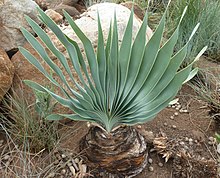
Boophone disticha has conspicuously distichous leaves.

Domatia at the bases of the thorns of Vachellia drepanolobium, the whistling thorn, with visible access holes


E
[edit]- -eae
- A suffix added to the stem of a generic name to form the name of a tribe, e.g. Aster → Astereae.
- ebracteate
- Lacking bracts; synonymous with ebracteolate.
- ecological amplitude
- The range of environmental conditions in which an organism can survive.
- edaphic
- Of or influenced by the soil.
- eglandular
Not having glands.
- elaiosome
- An external structure attached to the seed of many species of plants. Elaiosomes generally look fleshy and in some species they are rich in oils or other nutritious materials. Their functions vary and are not always obvious; commonly they attract ants or other animals that aid in dispersal, but they may also repel other animals from eating the seed.[32]
- elephophily
- A form of pollination whereby pollen or spores are distributed by the feet of elephants, as in Rafflesia arnoldii.
- ellipsoid
- A three-dimensional shape that is elliptical in all sections through the long axis.
- elliptical
Planar, shaped like a flattened circle, symmetrical about both the long and the short axis, tapering equally both to the tip and the base; oval.
- emarginate
- Typically in reference to leaf margins: notched or recessed at some part of the edge, such as the apex; the recess usually is broad and shallow. The location of a leaf's emargination(s) might be one or more of apical, lateral or basal
- embryo
- The young plant contained by a seed prior to germination.
- emergent
- A plant taller than the surrounding vegetation or, among aquatic plant species, one that bears flowers and commonly leaves above the surface of the water. Aquatic examples include water lilies, reeds, and papyrus. Some pondweeds such as Stuckenia are not emergent until they flower, at which time only their flowers appear above the water surface.
- enation
- Leaf-like outgrowth from a surface.[33]
- enantiostyly
- The condition in which the gynoecium protrudes laterally, to the right (dextrostyly) or to the left (sinistrostyly) of the androecium, e.g. Senna.
- endemic
- Having a natural distribution restricted to a particular geographic region. Compare native.
- endocarp
- The innermost layer of the wall of a fruit; in a drupe, the stony layer surrounding the seed.
- endodermis
- The innermost layer of the cortex of vascular plant roots, also present in the stems of pteridophytes. The radial walls are impregnated with suberin to form a permeability barrier known as the Casparian strip.
- endosperm
- 1. (angiosperms) A nutritive tissue surrounding the embryo of the seed, usually triploid, originating from the fusion of both polar nuclei with one gamete after the fertilization of the egg.
- 2. (gymnosperms) The prothallus within the embryo sac.
- endospory
- The production of spores that germinate into a reduced multicellular gametophyte contained within the spore wall. Contrast exospory.
- ensiform
- Shaped like the blade of a sword.
- entire
- 1. Not divided.
- 2. (of a margin) Smooth and not lobed or toothed (though possibly wavy or scalloped). See also entire in Glossary of leaf morphology
- entomophily
- A form of pollination whereby pollen or spores are distributed by insects.
- epecophyte
- Species of recent appearance, usually numerous and constant in the country, but confined to artificial habitats, such as meadows and ruderal vegetation and are dependent on humans for existence.[34]
- ephemeral
- Short-lived. See also caducous.
- epicalyx
- An involucre resembling an outer calyx, e.g. as in Hibiscus.
- epicarp
- The outer layer of the wall of a fruit, i.e. the "skin".
- epicormic
- Used to refer to buds, shoots, or flowers developing from the old wood of trees, especially after injury or fire.
- epicotyl
- The part of the plant axis or stem between the cotyledonary node and the first foliage leaves.
- epicuticular wax
- A layer of crystalline or amorphous wax deposited on the surface of the cuticle.
- epidermis
- An organ's outermost layer of cells, usually only one cell thick.
- epigynous
- Borne on the ovary; describes floral parts when attached above the level of the ovary and arising from tissue fused to the ovary wall. Compare hypogynous and perigynous.
- epilithic
- Growing on stone. Compare lithophytic, a plant growing on stone.
- epipetalous
- Of stamens that are attached to the petals.
- epipetric
- Growing on rock or stone, lithophytic, epilithic.
- epiphloedal
- Growing on the surface of bark. Contrast endophloedal (growing inside, not on, the bark) and epilithic (growing on rock, not bark).
- epiphyte
- A plant, alga or fungus that grows on another plant without deriving nourishment from it but using it for support.
- epiphytic
- Of an epiphyte; living on the surface of a plant. Compare epilithic, lithophytic.
- episepalous
- Of stamens that are attached to the sepals.
- epitepalous
- Of stamens that are attached to the tepals.
- epithet
- The adjectival component in a binomial scientific name, usually more specifically called a specific epithet; the final word or combination of words in a name of more than one word (other than a term denoting rank) that denominates an individual taxon. The simplest and commonest example is the second word in a two-word name of a species, such as "mirabilis" in Welwitschia mirabilis.
- epizoochory
- A type of seed dispersal that occurs when seeds or fruits physically adhere to the outside of vertebrate animal bodies.
- epruinose
- Not pruinose.
- equitant
- (of a leaf) Folded lengthwise and clasping another leaf.
- erect
- Upright, more or less perpendicular to the ground or point of attachment. Compare patent (spreading) and erecto-patent, between erect and patent.
- ericoid
- Having leaves like those of the European heaths (Erica); small and sharply pointed.
- erose
- (of a margin) Irregular as though nibbled or worn away.
- ethelochoric
- Deliberate introduction by seedlings, seeds or plants in a new habitat by humans.
- etiolation
- Weak growth due to lack of light, resulting in elongated stems and yellowish color.[35]
- even-pinnate
- Having an even number of leaflets in a compound leaf; synonymous with paripinnate.
- evergreen
- Not deciduous; having leaves all year.
- ex
- In nomenclature, indicating that the preceding author proposed the name but did not legitimately publish it, and that the succeeding author referred to the first author when legitimately publishing the name. See Author citation (botany).
- exalbuminous
- In seeds of a given species, having no endosperm, i.e. no albumen, e.g. in Fabaceae and Combretaceae.
- exocarp
- The outer layer of the pericarp, often the skin of fleshy fruits.
- exospory
- The production of spores that germinate into free-living multicellular gametophytes. Contrast endospory.
- exotesta
- The outer layer of the testa (seed coat). It is derived from the outer integument of the ovule.
- exotic
- Not native; introduced from another region or country.
- exserted
- Projected beyond, e.g. stamens beyond the corolla tube.
- exstipulate
- Lacking stipules.
- extrastaminal
- Outside the stamens or androecium, usually referring to the location of a nectary disk.
- extrorse
- (of anther locules) Opening toward the outside of the flower. Contrast introrse and latrorse.

Plants of the genus Corydalis bear seeds with attached elaiosomes, which have various functions, commonly attracting ants. On some Corydalis species, elaiosomes that attract ants also repel mice.[32]

Ficus lyrata is an example of a doubly-emarginate leaf with lateral and apical emargination; it also might be seen as a basally emarginate.

Petals of Heracleum sphondylium are variously emarginate at their tips. Flowers in the middle of the inflorescence have slightly emarginate petals, whereas flowers at the periphery are so deeply emarginate as to be almost cleft in two.
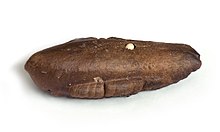


Iris pseudacorus has clearly ensiform leaves: narrow, straight-edged, sword-shaped.



Tillandsia recurvata growing as a harmless, non-parasitic epiphloedal epiphyte on a tree trunk that is also infested with an epiphloedal foliose lichen

Seeds or fruits are dispersed by epizoochory when they stick to the fur of animals.

The bases of equitant leaves enclose later leaves on the stem.

Sections of exalbuminous seeds
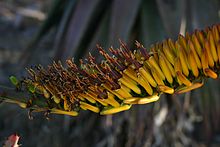
Aloe marlothii flowers with stamens and stigmata of mature flowers exserted from the mouths of the floral tubes
F
[edit]- F1 hybrid
- A single cross; a plant breeding term for the result of a repeatable cross between two pure bred lines.
- F2 hybrid
- A plant breeding term for the result of a plant arising from a cross between two F1 hybrids; may also refer to self-pollination in a population of F1 hybrids.
- fabiform
- Shaped like a kidney bean.
- facultative
- Able to perform a particular life function, or to live generally, in more than one way.[36] Compare obligate.
- falcate
- Curved like the blade of a scythe.
- family
- A taxonomic group of one or more genera with features, ancestry, or both in common. It is the term for the principal rank between order and genus.
- farina
- Powdery, pale yellow, crystalline secretion consisting of flavonoids in Primula and other species.
- farinaceous
- Powderiness that is mealy.
- fascicle
A cluster of flowers, leaves, needles, vascular tissue, etc., e.g. a tuft of leaves all arising from the same node.
- fasciculate
- Branching in clusters, e.g. a bundle of sticks or needles; having fascicles.
- fastigiate
- 1. In Plant morphology, the habit of a plant that consists in part, of a bundle of erect, more or less parallel branches or stems, particularly if they form or taper to a peak or point. (Latin fastigiatus,meaning "having a peak".
- 2. In palynology, the form of a pollen grain that has a fastigium, a pointed apex over a hollow between the layers of the pollen outer wall.
- faucal
- Pertaining to the fauces; located in the throat of a calyx or corolla.
- fauces
- The throat of a calyx or corolla; the conspicuously widened portion between the mouth and the apex of the tube. In Boraginaceae, the site of distinctive appendages.
- faveolate
- Honeycombed; having regular, angled pits. Compare foveolate.
- felted
- Having interlocked hairs to the extent of being matted.[28]
- female flower
- See pistillate flower.
- fenestrate
- Having translucent or transparent areas that let light through; this variously affects the behavior of animal visitors or permits photosynthesis in many arid-region plants that grow only to the soil surface. Also refers loosely to perforations, for which perforate is the more precise term.
- ferruginous
- Ruddy or rust-colored.
- fertile
- Capable of producing fruit; of flowers when they produce seed, or of anthers containing pollen.
- fertilization
- The union of male and female gametes during sexual reproduction.
- fiber
- 1. A fiber cell.
- 2. Any flexible, strong, stringy, and very elongate structure.
- fiber cell
- A type of cell that is found in sclerenchyma; it is much elongated, and dies soon after an extensive modification of its cell wall. The cell wall is usually thickly lignified but is sometimes gelatinous.
- filament
- 1. The stalk of a stamen.
- 2. Any very narrow, thread-like structure that is one or a few cells thick.
- filamentous
- Consisting of filaments or fibers; hairlike.
- filiform
- Thread-like, e.g. stamen filaments or leaf shapes.
- fimbria
Slender, hair-like projection; fringe.
- fimbriate
- Fringed, e.g. where the ends of a petal are split into two or more divisions.[37] Having fimbriae.
- fissure
- A split or crack, often referring to fissured bark; a line or opening of dehiscence.
- fistule
- A tube-shaped cavity.
- fistulose
- Hollow; usually applied to a tube-shaped cavity, as in a reed.
- flabellate
- Fan-shaped, e.g. a flabellate (fan-shaped) leaf.
- flaccid
- Limp; tending to wilt. Compare turgid.
- flexistyly
- Depending on the degree of maturation of the stamens, the style moves up or down (cataflexistyle or (ana-)hyperflexisyle).
- flexuous
- flexuose
- Bent alternately in different directions; zigzag.
- floccose
- Having a soft and wooly covering of hairs.
- flora
- 1. All the plants growing in a certain region or country.
- 2. An enumeration of them, generally with a guide to their identification (e.g. the Flora of North America, Flora of China, Flora of Victoria, Flora of New South Wales, and so on). In this case, flora is written with a capital F.
- floral envelope
- See perianth.
- floral leaves
- The upper leaves at the base of the flowering branches.
- floral diagram
- A graphical means to describe flower structure, usually a schematic cross-section through a young flower.
- floral formula
- A description of flower structure using numbers, letters, and various symbols.
- floral tube
- An imprecise term sometimes used as a synonym of hypanthium, corolla tube, or calyx tube.
- floret
- A small flower, usually referring to the individual true flowers clustered within an inflorescence, particularly those of the Poaceae grasses and the pseudanthia of family Asteraceae.
- flower
- The sexual reproductive structure of the angiosperms, typically with a gynoecium, androecium, perianth, and an axis.
- foliate
- Preceded by a number to signify having a certain number of leaflets, e.g. 3-foliate means "having three leaflets".
- foliicolous
- A growth habit of certain lichens, algae, and fungi that prefer to grow on the leaves of vascular plants.
- follicle
- A dry fruit formed from one carpel splitting along a single suture to which the seeds are attached, e.g. from the pod of a legume.[38]
- foliole
- A small, leaf-like appendage on the front or back.[of what?]
- foliose
- Leaf-like; flattened like a leaf.
- forb
- Any non-woody flowering plant that is not a grass, sedge, or rush.
- forest
- Vegetation dominated by trees with single trunks, including closely arranged trees with or without an understory of shrubs and herbs.
- forma (in common usage, form)
- A taxonomic category subordinate to species and within the taxonomic hierarchy, below variety (varietas), and usually differentiated by a minor character.
- foveolate
- Having regular tiny pits. Compare faveolate.
- free
- Not united with other organs of the same type; not attached at one end.
- free central
- (of placentation) Ovules attached to a free-standing column in the center of a unilocular ovary.
- frond
- A leaf of a fern, cycad, or palm.
- frutescent
- Shrub-like (fruticose) or becoming shrub-like.
- fruticose
- Shrubby; having the branching character of a shrub.
- fruit
- A seed-bearing structure, present in all angiosperms, formed from the mature ovary and sometimes associated floral parts upon fertilization.
- fugacious
- Disappearing, falling off, or withering. Compare persistent and caducous.
- funicle (funiculus)
- The stalk of an ovule.
- funnelform
- Having a form gradually widening from the base to the apex; funnel-shaped.
- furcate
- Forked, usually applied to a terminal division; with two long lobes.
- fused
- Joined together.
- fusiform
- Rod-shaped and narrowing gradually from the middle toward each end; spindle-shaped.

Astragalus falcatus has conspicuously falcate pods; not many falcate anatomical structures are so markedly curved.

Rhigozum obovatum bears its leaves in well-defined fascicles.


Favolaschia calocera, the orange pore fungus, has conspicuously faveolate fruiting bodies.

Emerging leaves of Oldenburgia grandis are heavily felted.

Fenestrate leaves of Darlingtonia californica
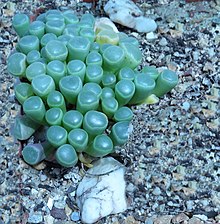
In the wild, the leaves of Fenestraria commonly are covered in soil, except for the transparent fenestration; this permits photosynthesis while reducing damage from exposure to intrense sunlight and herbivores.

Digitalis ferruginea owes its specific name to its ferruginous (rust-colored) flowers.

Calochortus fimbriatus has fimbriate flowers.


The pseudanthium of Zinnia elegans is typical of many Asteraceae in that it includes two types of florets, ray florets and disk florets.


Foveolate seeds of Physochlaina physaloides
G
[edit]- galbulus
- In gymnosperms, a fleshy cone (megastrobilus); chiefly relates to cones borne by junipers and cypresses, which are often mistakenly called berries.
- galea
- An overhanging, helmet-shaped, structure that protects the reproductive parts from precipitation, wind or unwanted visitors.
- gall
- Abnormal outgrowth on external plant tissues, caused by various parasites, from viruses, fungi and bacteria, to other plants, insects and mites.
- gamete
- A cell or nucleus that fuses with another of the opposite sex during sexual reproduction.
- gametophore
- Specialized structures on the gametophytes of some bryophyte species, for example many species in the order Marchantiales; in such species the gametes are produced on the gametophores.
- gametophyte
- The haploid multicellular phase in the alternation of generations of plants and algae that bears gametes. In bryophytes the gametophyte is the dominant vegetative phase; in ferns and their allies it is a small free-living plant known as the prothallus; in gymnosperms and angiosperms the gametophytes are reduced to microscopic structures dependent on the sporophyte, male gametophytes contained in pollen grains and females contained within the ovules.
- gamopetalous
- with joined or fused petals
- gamophyllous
- a single perianth-whorl of united segments. Compare symphyllous (synonym), apophyllous, and polyphyllous.
- gemma
- an asexual reproductive structure found in liverworts and mosses.
- gene pool
- The complete range of genetic variation found within a population.
- genus
A group of one or more species with features or ancestry (or both) in common. Genus is the principal category of taxa intermediate in rank between family and species in the standard nomenclatural hierarchy.
- generic name
- The name of a taxonomic genus, such as Acacia and Eucalyptus.
- genotype
- The genetic make-up of an individual.
- geophilous
- Growing or rooting in the ground.
- germination
- 1. of seeds, describing the complex sequence of physiological and structural changes that occur from resting to growth stage.
- 2. of a pollen grain; production of a pollen tube when contacting a stigma receptive to it.
- 3. of a spore of fungi/bacterium; change of state – from resting to vegetative.
- gibbous (gibbose)
- (of part of an organ) Swollen, usually with a pouch-like enlargement at the base.
- glabrescent
- Becoming glabrous, almost glabrous; glabrate.
- glabrous
- Lacking surface ornamentation such as hairs, scales or bristles; smooth.
- gland
- A secretory structure within or on the surface of a plant.
- glandular hair
- A hair tipped with a gland.
- glaucous
- Describing the external surface of a plant part that has a whitish covering, in some cases with a blueish cast. Often applied to plants with a wooly or arachnoid surface, but properly referring to pruinose surfaces, meaning those with a waxy bloom. The surfaces of the young leaves of many eucalypts provide good examples, and so do some xerophytes.
- globose
Roughly spherical. See also subglobose.
- globulose
- Approximately spherical.
- glochid
- A tiny barbed hair or bristle, e.g. the fine defensive hairs in cactus species such as Opuntia.
- glumes
- bracts subtending the floret(s) of a sedge, or similar plant; in grasses forming the lowermost organs of a spikelet (there are usually 2 but 1 is sometimes reduced; or rarely, both are absent).
- glutinous
- Sticky.
- graft
- 1. The artificial union of plant parts.
- 2. A plant shoot suitable for grafting; loosely, a scion, sucker, or branch.
- graft chimaera (sometimes graft hybrid)
- A taxon whose members consist of tissue from two or more different plants in intimate association originated by grafting. The addition sign "+" is used to indicate a graft-chimaera either as a part of a formula (e.g. Crataegus monogyna + Mespilus germanica) or in front of an abbreviated name (e.g. + Crataegomespilus 'Dardari'). The nomenclature of graft hybrids is governed by the International Code of Nomenclature for Cultivated Plants.
- graminaceous
Of or relating to grass.
- graminoid
- An herbaceous plant with a grass-like morphology.
- granular
- (of a surface) Covered with small rounded protuberances.
- grass
- A plant of the family Poaceae.
- grassland
- Low vegetation dominated by grasses.
- groundcover
- 1. Dense vegetation that covers the ground.
- 2. A term applied to describe a plant that covers the soil surface so densely that it smothers all beneath it.
- group
- A formal category equivalent to or below the rank of genus which distinguishes
- an assemblage of two or more cultivars within a species or hybrid;
- plants derived from a hybrid in which one or more of the parent species is not known or is of uncertain origin; or,
- a range of cultivated plants of a species or hybrid which may exhibit variation but share one or more characters, which makes it worth distinguishing them as a unit.
- guard cell
- Each of two cells surrounding the stoma which control gas exchange between the apoplast of the plant and the external environment.
- guttate
- Having droplet-shaped spots. Compare punctate and maculate.
- guttation
- The secretion of liquid water from uninjured plant parts. See hydathode.
- guttulate
- Having or appearing to be spotted with oil droplets; of spores, having oil droplets inside.
- gymnosperm
- A seed-bearing plant with unenclosed ovules borne on the surface of a sporophyll. Gymnosperms are among the oldest clades of vascular plants, and today are represented by approximately 1,000 extant species worldwide, including, among others, conifers, Ginkgo, Gnetum and cycads. Compare angiosperm.
- gynaecium
- Alternative term for gynoecium, but with partly different etymology.
- gynobasic
- Of a style, arising near the base of the gynoecium, e.g. between the lobes of the ovary.
- gynodioecious
- Of a species, with some plants bearing only bisexual flowers and others bearing only female flowers.
- gynomonoecious
- Of a species, with bisexual flowers and female flowers on the same plant.
- gynoecium
- The collective term for the female reproductive parts of a flower or for the carpels of a flower, whether united or free. Contrast androecium. Abbreviation: G. For instance, G indicates a superior ovary; G(5) indicates having five fused carpels.
- gynophore
- A stalk supporting the gynoecium and situated above the level of insertion of the other floral parts.
- gynostegium
- A compound organ in milkweeds (Asclepiadaceae) and orchids formed by fusion of the filaments of the stamens with the style. Also known as the column.


Gametophores (red male antheridia and brown female archegonia) borne on a gametophyte of a Chara species of green algae

Longitudinal section of immature male pine cone, showing male gametophytes (pollen grains) developing between the cone scales

Glandular hairs on the stem of Geranium dissectum

The leaves, buds, and young stalks of Eucalyptus macrocarpa are glaucous, covered with a thick waxy pruinosity.


Glumes of a grass species with a fairly large inflorescence
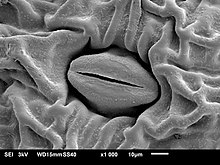
Scanning electron micrograph of a stoma on the leaf of Haemanthus. The two lip-shaped cells on either side of the pore are the guard cells.


Examples of gymnosperms
LEFT1-Welwitschia mirabilis
2-Cycas revoluta
3-Taxus baccata
4-Ginkgo biloba
RIGHT
1-Cupressus sempervirens
2-Sequoiadendron giganteum
3-Agathis dammara
4-Araucaria heterophylla
H
[edit]- habit
- The general external appearance of a plant, including size, shape, texture, and orientation.
- habitat
- The place where a plant lives; the environmental conditions of its home.
- hair
- A single elongated cell or row of cells borne on the surface of an organ.
- half-inferior ovary
- An ovary partly below and partly above the level of attachment of the other floral parts. Compare inferior ovary and superior ovary.
- halonate
- Having a transparent coating, or being of a spore's outer layer.
- halophyte
- A plant adapted to living in highly saline habitats; a plant that accumulates high concentrations of salt in its tissues.
- hand-pollination
- The controlled act of pollination that excludes the possibility of open-pollination.
- haploid
- Having one set of chromosomes, e.g. the complement of chromosomes in each of the cells of the gametophyte, the nucleus of a gamete, and the spores. This is expressed symbolically as n, where n = the gametic number of chromosomes. Compare diploid, triploid, and tetraploid.
- haplostemonous
- Having a single series of stamens equal in number to the proper number of petals, and alternating with them. Compare diplostemonous and obdiplostemonous.
- harmomegathy
- process by which pollen grains in arid environments close off their apertures to avoid losing water
- hastate
- Triangular in outline, the basal lobes pointing outward, so that the base appears truncate; may refer only to the base of a leaf with such lobes. Compare sagittate, which refers to basal lobes pointing backward.
- haustorium
- In parasitic plants, a structure developed for penetrating the host's tissues.
- head
- See capitulum, a pseudanthium.
- heathland
- Vegetation dominated by small shrubs which usually have ericoid leaves.
- helicoid
- Coiled; of a cymose inflorescence, when the branching is repeatedly on the same side (the apex is often recurved). Compare scorpioid.
- heliophilous
- Requiring or tolerating strong, direct sunlight.
- hemerochory
- A plant that has been transported voluntarily or involuntarily by humans in a territory which it could not have colonized by its own natural mechanisms of dissemination, or at least much more slowly.[34]
- hemi-legume
- A legume fruit in which the seed or seeds and one valve of the pod are dispersed as a unit. The valve catches the wind and blows away with the seeds, as in Acacia tenuifolia and Peltogyne paniculata.
- herb
- Any vascular plant that does not develop a woody stem at any point during its life cycle, e.g. a daffodil.
- herbaceous
- Not woody; usually green and soft in texture.
- herbarium
A collection of preserved, usually pressed and dried, plant material used for identification and comparison; also a building in which such collections are stored.
- hermaphrodite
- A synonym of bisexual.
- hesperidium
- A form of berry that occurs most familiarly in the genus Citrus. The fruit tends to be large for a berry, ranging from not much more than a centimeter in small fruited genera such as Murraya, to 15 cm or more in some varieties of Citrus. The outer rind typically is thick and tough with many oil glands, while the carpels within are packed with juicy fibers.
- heteroblastic
- Having parts, especially leaves, that are distinctly different between the juvenile and adult stages.
- heteromorphic
- Having two or more distinct morphologies (e.g. of different size and shape). Compare isomorphic.
- heterospory
- The production of spores of two different sizes (small and large) by the sporophytes of land plants. Compare homospory.
- heterostyly
- The condition of a species having flowers with different style and stamen lengths, but with all the flowers of any one plant being identical. See distyly.
- hilum
- The scar on a seed coat where it separates from its stalk (funicle).
- hip
- The fruit of a rose plant.
- hippocrepiform
- Horseshoe-shaped.
- hirsute
- Bearing coarse, rough, longish hairs. See indumentum.
- hispid
- Bearing long, erect, rigid hairs or bristles, harsh to touch.
- hoary
- Covered with a greyish to whitish layer of very short, closely interwoven hairs, giving a frosted appearance.
- holotype
- A type chosen by the author of a name. Compare lectotype.
- homochlamydeous
- Having a perianth which is not divided into a separate calyx and corolla. Contrast dichlamydeous.
- homospory
- The production of spores of only one size by the sporophytes of land plants. Compare heterospory.
- hort.
Of gardens, an author citation used in two ways:
1. as a name misapplied by gardeners- 2. as an invalid name derived from horticultural writings of confused authorship.
- husk
- Protective outer covering of certain seeds, for example, the leafy outer covering of an ear of maize (corn), the leathery covering of the walnut, or the spiky covering of the chestnut.
- hyaline
- Translucent; usually delicately membranous and colorless.
- hybrid
- Plant produced by the crossing of parents belonging to two different named groups, e.g. genera, species, varieties, subspecies, forma and so on; i.e. the progeny resulting within and between two different plants. An F1 hybrid is the primary product of such a cross. An F2 hybrid is a plant arising from a cross between two F1 hybrids (or from the self-pollination of an F1 hybrid).
- hybrid formula
- The names of the parents of a hybrid joined by a multiplication sign, e.g. Cytisus ardonoi × C. purgans.
- hydrophily
- Form of pollination whereby pollen is distributed by the flow of waters.
- hypanthium
- Tube or cup-like structure in a flower that includes the bases of sepals, petals, and stamens, and may or may not be connected (adnate) to the ovary.
- hyper-resupinate
- In botany, describing leaves or flowers that are in the usual position but are borne on a petiole or pedicel that is twisted 360 degrees. The term is used to describe organs, such as orchid flowers, that are usually resupinate. Compare resupinate.
- hypocarpium
- Enlarged fleshy structure that forms below the fruit from the receptacle or hypanthium.
- hypocotyl
- Of an embryo or seedling, the part of the plant axis below the cotyledon and node, but above the root. It marks the transition from root to stem development.
- hypocrateriform
- Salver-shaped. Synonym of salverform. From Greek kratḗrion: a vessel.
- hypogynous
- Borne below the ovary; used to describe floral parts inserted below the ovary's level of insertion. Compare epigynous and perigynous.
- hysteranthous
- Type of growth in which new leaves appear after flowering. Also spelled histeranthous. Compare proteranthous and synanthous.

Epidermal hairs on plant leaves

Multicellular hairs on the edge of a sepal of Veronica sublobata
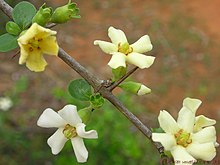

Markedly hastate leaf of Salvia canariensis

The swollen haustorium of Viscum capense renders the end of the branch stunted compared to the lower part of the branch.

The fruit of Poncirus is a typical hesperidium.

Heteroblastic growth is common in Eucalyptus species with leaves that are isobilateral in the mature tree; they generally start life with dorsiventral leaves. Some of these saplings are in the transient stage in which they have both forms of leaves, dorsiventral on lower branches, and isobilateral above.


A hypocarpium forms below the fruits of Sassafras albidum.

Flowers, fruit and propagule of a Rhizophora "mangle" or mangrove. The apparent root of the propagule is in fact meristematic tissue developing from the hypocotyl. The new plant develops largely from this tissue, especially if it has successfully penetrated into mud in which the new plant can establish itself.
I
[edit]- idioblast
- A cell, especially of a leaf, differing markedly from surrounding cells. They often synthesise specialized products such as crystals.
- illegitimate name (nomen illeg.)
- A name not abiding by the rules of the botanical Codes, e.g. later homonyms, cultivars that have been Latinised after 1 Jan 1959; cultivar names with more than 10 syllables or 30 letters; cultivar names that use confusing names of other plants, e.g. Camellia 'Rose'.
- imbricate
- From the Latin for "tiled". Overlapping each other; of perianth parts, edges overlapping in the bud (the convoluted arrangement is a special form of imbrication). Dormant buds of many deciduous species are imbricately covered with protective cataphylls called bud scales. Compare with subimbricates meaning lightly overlapping
- imparipinnate
- A pinnate leaf with an odd number of pinnae (terminated by a single leaflet). Compare paripinnate.
- in
- In nomenclature, where the preceding author published the name in an article or book, authored or edited by the succeeding author.
- -inae
- The suffix added to the stem of a generic name to form the name of a subtribe: for instance, Corydalinae from Corydalis + -inae.
- inbreeding
- The production of offspring between closely related parents leading to a high degree of similarity; self-fertilization is the most intense form of inbreeding.
- incertae sedis
- Of unknown taxonomic affinity; relationships obscure.
- incised
- Cut deeply and (usually) unevenly (a condition intermediate between toothed and lobed).
- included
- Enclosed, not protruding, e.g. stamens within the corolla.
- incomplete flower
- A flower which lacks one or more of its usual parts, such as carpels, sepals, petals, pistils, or stamens.
- incurved
- Bent or curved inward; of leaf margins, when curved toward the adaxial side.
- ined.
- An abbreviation of Latin inedita, an unpublished work. Used to indicate that a botanical name appeared only in a manuscript that was not published, so the name is invalid.
- indefinite
- variable in number, and as a rule numerous, e.g. more than twice as many stamens as petals or sepals, but no particular standard number of stamens. In another usage it is a synonym for the preferable term indeterminate, meaning the condition in which an inflorescence is not terminated by a flower, but continues growing until limited by physiological factors. Compare numerous. Contrast definite.
- indehiscent
- Not opening in any definite manner at maturity; usually referring to fruit. Contrast dehiscent.
- indeterminate
- usually referring to a stem or inflorescence in which there is no particular terminal bud or meristem that stops growth and ends the extension of the stem, which continues until physiological factors stop the growth. Racemes of some Xanthorrhoeaceae, such as many Aloes, and of many Iridaceae, such as Watsonias, are indeterminate. Contrast determinate.
- indigenous
- Native to the area, not introduced, and not necessarily confined to the region discussed or present throughout it (hardly distinct from ‘native' but usually applied to a smaller area). For example, the Cootamundra Wattle is native to Australia but indigenous to the Cootamundra region of southern New South Wales. Compare endemic.
- indumentum
- Collective term for a surface covering of any kind of trichomes, e.g. hairs, scales.
- induplicate
- Folded upward, or folded with the two adaxial surfaces together.
- indusium
- 1. Membrane covering the sori of some ferns.[39]
- 2. Cup enclosing the stigma in Goodeniaceae.[39]
- inferior ovary
- An ovary at least partly below the level of attachment of other floral parts. Compare superior ovary and half-inferior ovary.
- inflated
- Swollen, like a bladder.
- inflexed
- Bent sharply upward or forward. Compare deflexed.
- inflorescence
- several flowers closely grouped together to form an efficient structured unit; the grouping or arrangement of flowers on a plant.
- infraspecific
- denotes taxonomic ranks below species level, for example subspecies.
- infrageneric
- denoting taxonomic ranks below the genus level, for example, subgenera, sections, and series.
- infructescence
- the grouping or arrangement of fruits on a plant.
- infundibular (infundibuliform)
- funnel-shaped, for example in the corolla of a flower.
- inrolled
- rolled inward.
- insectivorous
- catching, and drawing nutriment from, insects.
- insertion, point of
- The point at which one organ or structure (such as a leaf) is joined to the structure which bears it (such as a stem).
- inserted
- growing out from
- integument
- in general, any covering, but especially the covering of an ovule.
- intercalary
- (e.g. of growth) occurring between the apex and the base of an organ
- intercalary meristem
- a meristem located between the apex and the base of an organ
- interjugary glands
- in pinnate leaves, glands occurring along the leaf rachis between the pinnae (occurring below the single, and often slightly larger, gland at or just below the insertion of the pinnae). Compare jugary.
- internode
- The portion of a stem between two nodes.
- interpetiolar
- (of stipules) Between the petioles of opposite leaves, e.g in Rubiaceae.
- intramarginal
- inside but close to the margin. For example, an intramarginal vein is one that parallels, and is very close to, the leaf margin.
- intrastaminal
- inside the stamens or androecium, usually referring to the location of a nectary disk.
- introrse
- of anther locules, with opening toward the center of flower (at least in bud). Compare extrorse and latrorse.
- invalid
- Use of names not validly published according to the Code, i.e. they are not strictly 'names' in the sense of the International Code of Botanical Nomenclature.
- involucre
- A structure surrounding or supporting, usually a head of flowers. In Asteraceae, it is the group of phyllaries (bracts) surrounding the inflorescence before opening, then supporting the cup-like receptacle on which the head of flowers sits. In Euphorbiaceae it is the cuplike structure that holds the nectar glands, nectar, and head of flowers, and sits above the bract-like cyathophyll structure. Involucres occur in Marchantiophyta, Cycads, fungi, and many other groups.
- involute
- Rolled inward, for example when the margins of a leaf are rolled toward the adaxial (usually upper) surface. Compare revolute.
- iridescent
- Having a reflective colored sheen produced by structural coloration, as in the speculum of the mirror orchid Ophrys speculum.
- irregular
- Not able to be divided into two equal halves through any vertical plane. See also asymmetrical. Compare zygomorphic, actinomorphic, and regular.
- isobifacial
- (of flat structures, especially leaves) Having both surfaces similar, usually referring to cell types or to the number and distribution of stomata.
- isomerous
- Having an equal number of parts in the whorls.
- isomorphic
- with all features morphologically similar, i.e. of similar size and shape. Compare heteromorphic.
- isotomic
- Having branches of equal diameter. Compare anisotomic.
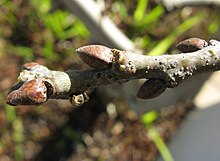

Petals of Mespilus germanica are imbricate before the flower opens.

Doubly imparipinnate compound leaf of Melia azedarach

Deeply incised leaves of Pelargonium graveolens

Indefinite stamens of Hypericum

Indehiscent pods of Libidibia ferrea; unlike most Fabaceae species, the plant depends on the pods being crushed by large ungulates to disperse the seeds.


The leaves of Syagrus palms are 'induplicately folded, in contrast to many other palm genera with reduplicate leaves.

Stamens of Calotropis gigantea are inserted at the base of the corolla.

The intramarginal veins near the margins of this leaf are outlined in white.

Two of these three green Asteraceae involucres encase unopened flower heads, and the third supports the open colorful head of emerging flowers. The imbricate phyllaries around the heads of this Malacothrix coulteri suggest the keeled scales of a snake, giving the plant its common name: "snake's head".

This Begonia leaf shows unusual iridescence for a plant.
J
[edit]- joint
- A node or junction of two parts; articulation.
- jugary
- associated with a jugum or something yoke-like; see for example jugary gland.
- jugary gland
- A gland occurring on the rachis of a pinnate or bipinnate leaf on a jugum, the junction or attachment of pairs of pinnae or pinnules, as in some Acacia species. Compare interjugary.
- jugate
- yoke-like; describing a structure of paired items joined together as in a jugum or something yoke-like, such as some leaves and fruit.
- jugum
- applied to various yoke-like organs, usually in the sense of their being paired, such as a pair of pinnae on a rachis.
- juvenile leaves
- Leaves formed on a young plant, typically differing from the adult leaves in form.

Vachellia karroo bipinnate leaf
A. Rachilla
B. Pinnule
C. Jugary glands
D. Juga (plural of jugum)
E. Base of petiole
F. Petiolary gland
G. Rachis

Jugate leaf of Bauhinia glabra

Jugate fruit of Tabernaemontana elegans

K
[edit]- keel
A prominent longitudinal ridge like the keel of a boat, e.g. the structure of the corolla formed by the fusion of the lower edge of the two abaxial anterior petals of flowers in the Fabaceae.
- kernel
- See drupe.
- kettle trap
- another term for the kettle-like pitchers of any of the carnivorous pitcher plants, in which they trap their prey.
- key innovation
- A novel phenotypic trait that allows subsequent evolutionary radiation and success of a taxonomic group.
- kidney shape
- A term describing a kidney-shaped object such as a bean or a leaf; more formally, oblately cordate, or crescent-shaped with the ends rounded.
- kingdom
- the highest generally employed category of the taxonomic hierarchy, above that of division (phylum). The Plant Kingdom includes vascular plants, bryophytes and green algae and is also known as the clade Viridiplantae.
- Klausenfrucht
- Klausen or Klausenfrucht (german) is a special type of fruits in Lamiaceae and Boraginaceae. A dry, dehiscent fruit formed from a superior ovary with axil or basal placentation, with an adherent calyx, from more than one carpel and usually breaking apart into 1-seeded units by separating each carpel by false septa. One unit is a half carpel, mostly there are four units, seeds. English terms are eremocarp, schizocarp, mericarp or nutlets.
- knee
- abrupt bend in a root or stem, commonly at a node; a cypress knee, or pneumatophore, is a type of bend or knob in the root of some plants, especially conifers such as some of the Taxodioideae, that shows as a projection of the root above ground level or mud level.

One form of the kettle traps of a pitcher plant

Kidney-shaped leaf of Cucurbita maxima

Typical knee at a node in a grass stem

Unusually dense stand of cypress knees around the parent tree
L
[edit]- labellum
- lip; one of three or five petals which is (usually) different from the others, e.g. in Orchidaceae, Zingiberaceae, Cannaceae and Stylidiaceae.
- labiate
- lipped; where a corolla is divided into two parts, called an upper and lower lip, the two resembling an open mouth with lips.
- lacerate
- jagged, as if torn.
- laciniate
- Of lobes – with ends irregularly divided into deeply divided, narrow, pointed segments; Of margins – deeply divided into pointed segments in an irregular manner.
- lacuna
- An empty space, hole, cavity, pit, depression, or discontinuity.
- lamella
Thin, plate-like layer.
Composed of an assemblage of many layers.
- lamina
- the blade of a leaf or the expanded upper part of a petal, sepal or bract.
- lanate
- covered in or composed of wooly hairs.
- lanceolate
- longer than broad, narrowly ovate, broadest in the lower half and tapering to the tip, like a lance or spear head; (sometimes, and incorrectly, used to mean narrowly elliptic).
- lanuginose
- covered in long hairs that cross and/or interweave with each other. More commonly the term lanate is used.[40]
- lateral
- attached to the side of an organ, e.g. leaves or branches on a stem. For more detail see dorsal.
- latex
- a milky fluid that exudes from such plants such as spurges, figs and dandelions.
- laticiferous
- latex-bearing, producing a milky juice.
- latrorse
- a type of anther dehiscence in which the anthers open laterally toward adjacent anthers. Compare introrse and extrorse.
- lauroid
- resembling Laurus, the laurel genus, particularly its leaves.
- lax
- loose, not compact.
- leaf
- an outgrowth of a stem, usually flat and green; its main function is food manufacture by photosynthesis. Abbreviation: lvs.
- leaf gap
- a parenchymatous area in the stele above (distal to) a leaf trace.
- leaf scar
- A healing layer forming on a stem where a leaf has fallen off.
- leaf trace
- A vascular bundle connecting the stele to a leaf.
- leaflets
- The ultimate segments of a compound leaf.
- legume
- 1. a fruit characteristic of the family Fabaceae, formed from one carpel and either dehiscent along both sides, or indehiscent.
- 2. a crop species in the family Fabaceae.
- 3. a plant of the family Fabaceae.
- lemma
- the lower of 2 bracts enclosing a grass flower.
- lenticel
- Typically lenticular (lens-shaped) porous tissue in bark with large intercellular spaces that allows direct exchange of gases between the internal tissues and atmosphere through the bark.
- lenticellate
- Having lenticels
- lenticular
- 1. lens-shaped.
- 2. covered in lenticels.
- lepidote
- covered with small scales.
- leprose
- powdery
- liana
- a woody climbing plant, rooted in the ground (liane is also used).
- liane
- a woody climbing plant, rooted in the ground. See also liana.
- ligneous
- having hard lignified tissues or woody parts, woody
- lignum
- Dead wood, typically in the context of a substrate for lichens.
- lignicolous
- Growing on wood tissue after bark as fallen or been stripped off (compare to corticolous).
- lignotuber
- a woody swelling of the stem below or just above the ground; contains adventitious buds from which new shoots can develop, e.g. after fire.
- ligulate
- 1. bearing a ligule.
- 2. strap-shaped.
- ligule
- 1. A small membranous appendage on the top of the sheath of grass leaves.
- 2. A minute adaxial appendage near the base of a leaf, e.g. in Selaginella.
- 3. An extended, strap-like corolla in some daisy florets.
- linea, line, British line, Paris line
- Various pre-metric units somewhat larger than 2 mm, used in botany into the 20th century. See Line (unit) and Paris line.
- linear
- Very narrow in relation to its length, with the sides mostly parallel. See Leaf shape.
- lingulate
- tongue-shaped.
- lip
- A labellum.
- lithophytic
- A plant growing on rocks; an epilithic plant.
- lobe
- Part of a leaf (or other organ), often rounded and formed by incisions to about halfway to the midrib.
- lobulate
- Having, consisting of or relating to a lobe or lobes.
- loculicidal
- (of a fruit) Dehiscing through the centers of loculi. Compare septicidal.
- locule
- A chamber or cavity containing seeds within an ovary, pollen within an anther or spores in a sporangium.
- lodicule
- One of two or three minute organs at the base of the ovary of a grass flower, representing parts of a strongly reduced perianth.
- lomentum or loment
- A pod-like indehiscent fruit that develops constrictions between the segments and at maturity breaks into one-seeded segments instead of splitting open.
- longicidal
- (of anthers) Opening lengthwise by longitudinal slits. Compare poricidal.
- lunate
- Crescent-shaped.
- lumen
- The cavity bounded by a plant cell wall.
- lyrate
- Lyre-shaped; deeply lobed, with a large terminal lobe and smaller lateral ones.

Labiate flowers of Prunella vulgaris

Laciniate, deeply incised, leaves of Pelargonium crispum

Most Euphorbias are laticiferous and instantly exude latex when even mildly punctured.
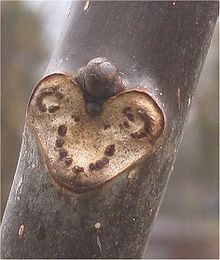
A leaf scar on Juglans regia, showing the layer of corky protective tissue that remained after the leaf separated along the abscission zone. It also shows the leaf traces of the vascular bundles that broke off when the abscission zone failed. The axillary bud associated with the leaf shows just above the scar.
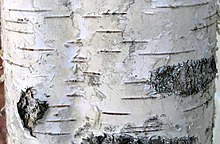
The dark horizontal lines on silver birch bark are lenticels.
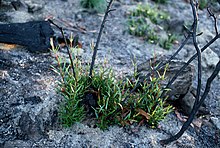
Lignotubers of Lambertia formosa growing sprouts after a bush fire

Ligule between the leaf sheath and leaf of a grass
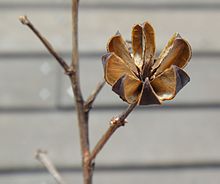
Loculicidal dehiscence of a fruit capsule. The locule walls split at the back, and the valves separate, bearing the septa on their centers.

M
[edit]- maculate
- Spotted; marked with spots.
- male flower
- See staminate flower.
- mallee
- A growth habit in which several woody stems arise separately from a lignotuber; a plant with such a growth habit, e.g. many Eucalyptus species; vegetation characterized by such plants.
- mangrove
- Any shrub or small tree growing in salt or brackish water, usually characterized by pneumatophores; any tropical coastal vegetation characterized by such species.
- margin
- The edge of a structure, as in the edge of a leaf blade.
- marginal
- Occurring at or very close to a margin.
- marsh
- A waterlogged area or swamp.
- mast
- Edible fruit and nuts produced by woody species of plants (e.g. acorns and beechmast) which is consumed on the ground by wildlife species and some domestic animals.
- mealy
- Covered with coarse, floury powder.
- medulla
- pith. See also medullary rays in wood.
- megasporangium
- the larger of two kinds of sporangium produced by heterosporous plants, producing large spores that contain the female gametophytes. Compare microsporangium.
- megaspore
- the larger of two kinds of spores produced by a heterosporous plant, giving rise to the female gametophyte. Compare microspore.
- megasporophyll
- in hetersoporous plants, a modified leaf bearing one or more megasporangia. Compare microsporophyll.
- megastrobilus
- the larger of two kinds of cones or strobili produced by gymnosperms, being female and producing the seeds. Compare microstrobilus.
- membranous
- thin, translucent and flexible, seldom green.
- mericarp
- one segment of a fruit (a schizocarp) that splits at maturity into units derived from the individual carpels, or a carpel, usually 1-seeded, released by the break-up at maturity of a fruit formed from 2 or more joined carpels.
- meristem
- Any actively dividing plant tissue.
- mesic
- Moist, avoiding both extremes of drought and wet; pertaining to conditions of moderate moisture or water supply; applied to organisms (vegetation) occupying moist habitats.
- mesocarp
- The fleshy portion of the wall of a succulent fruit inside the skin and outside the stony layer (if any), surrounding the seed(s); sarcocarp.
- mesomorphic
- Soft and with little fibrous tissue, but not succulent.
- mesophyll
- 1. The parenchyma tissues between the upper and lower epidermis. They vary in function, but usually include the photosynthetic tissue of a leaf.
- 2. In ecology, the blade of a leaf or leaflet that has a surface area 4500–18225 mm2; a plant, or vegetation, that has mesophyll (sized) leaves.
- mesophyllous
- (of vegetation) Of moist habitats and having mostly large and soft leaves.
- mesophyte
- A plant thriving under intermediate environmental conditions of moderate moisture and temperature, without major seasonal fluctuations.
- micropyle
- Opening at apex of ovule.
- microsporangium
- The smaller of two kinds of sporangium produced by a heterosporous plant, producing microspores that contain the male gametophyte. Compare megasporangium.
- microspore
- The smaller of two kinds of spores produced by a heterosporous plant. Compare megaspore.
- microsporophyll
- In heterosporous plants, a modified leaf bearing one or more microsporangia. Compare megasporophyll.
- microstrobilus
- The smaller of two kinds of cones or strobilus produced by gymnosperms, being male and producing the pollen. Compare megastrobilus.
- midrib
The central and usually most prominent vein of a leaf or leaf-like organ.
- midvein
- See midrib.
- monad
- A single individual that is free from other individuals, not united with them into a group. The term is usually used for pollen to distinguish single grains from tetrads or polyads.
- monadelphous
- A term describing stamen filaments that are fused for the greater part of their length, forming a tube around the style.
- moniliform
- Resembling a string of beads.
- monocarpic
- Flowering and setting seed only once before dying. See also semelparous.
- monochasium
- A cymose inflorescence with the branches arising singly. Compare dichasium and pleiochasium.
- monocot
- An abbreviation of monocotyledon.
- monocotyledon
- A flowering plant whose embryo contains one cotyledon (seed-leaf). Compare dicotyledon.
- monoecious
- (of vascular plants) Hermaphroditic, with all flowers bisexual, or with male and female reproductive structures in separate flowers but on the same plant, or of an inflorescence that has unisexual flowers of both sexes. Contrast dioecious.
- monoicous
- (of bryophyte gametophytes) Hermaphroditic or bisexual, where both male and female reproductive structures develop on the same individual. Contrast dioicous.
- monograph
- Of a group of plants, a comprehensive treatise presenting an analysis and synthesis of taxonomic knowledge of that taxon; the fullest account possible (at the time) of a family, tribe or genus. It is generally worldwide in scope and evaluates all taxonomic treatments of that taxon including studies of its evolutionary relationships with other related taxa, and cytological, genetic, morphological, palaeobotanical and ecological studies. The term is often incorrectly applied to any systematic work devoted to a single taxon. Compare revision.
- monomorphic
- Of one type, rather than several. See also dimorphic (two types) and polymorphic (many types).
- monophyllous
- Having a single leaf.
- monopodial
- A mode of stem growth and branching in which the main axis is formed by a single dominant meristem. Contrast sympodial.
- monostromatic
- Being a single cell thick, as in the alga Monostroma.
- monothecous
- having a sole compartment or cell. Compare Dithecous.
- monotypic
- Containing only one taxon of the next lower rank, e.g. a family with only one genus, or a genus that includes only a single species.
- morphology
- The shape or form of an organism or part thereof.
- mucro
A sharp, short point, generally at the tip of a leaf or the tip of the midrib of a compound leaf.[28]
- mucronate
- Terminating in a mucro.
- multiple fruit
- A cluster of fruits produced from more than one flower and appearing as a single fruit, often on a swollen axis, as with many species of the family Moraceae. Compare aggregate fruit.
- muricate
- Covered with short, hard protuberances.
- mutation
- In times before the nature of genetic encoding was understood, mutation was regarded as an abrupt, and sometimes heritable, variation from the norm of a population; for example a plant might unexpectedly produce "double" flowers, a novel color, or a habit of growth uncharacteristic of the species or variety. Advances in genetics and molecular biology in the mid-twentieth century, showed that biological mutations comprise and reflect changes in the nucleic acid molecules that encode the genome of an organism or virus. The nucleic acid affected could be DNA in the chromosomes, or it could be extrachromosomal DNA (typically DNA in the mitochondria or chloroplasts). In RNA viruses a mutation would be a change to the genetic information that the RNA encodes.
- mycelium
- The "vegetative" (nonreproductive) part of a fungus, mostly composed of aggregations of hyphae. It functions in substrate decomposition and absorption of nutrients.
- mycorrhiza
One of several types of symbiotic association between a fungus and the roots of a plant.
- mycotroph
A plant that obtains most or all of its carbon, water, and nutrients by associating with a fungus.

Maculate leaves

Eucalyptus socialis, showing its mallee habit, a single tree with several trunks growing from an underground lignotuber

Mast from beeches on the forest floor

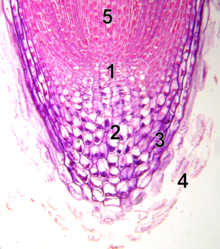
Apical meristem in root tip:
1: Meristem2: Columella
showing statocytes with statoliths
3: Lateral part of the tip
4: Dead cells
5: Elongation zone

Mesophyll as seen in the cross section of a dicotyledonous leaf
A-Lower epidermisB-Lower palisade mesophyll
C-Upper epidermis
D-Upper palisade mesophyll
E- Spongy mesophyll
F-Leaf vein

Longitudinal section of Pinus ovule
A=GametophyteB=Egg cell
C=Micropyle
D=Integument
E=Megasporangium

Strobilus of a Selaginella
A-MegasporeB-Microsporangium
C-Megasporangium
D-Microspore
E-Sporophyll

Moniliform pods on Vachellia nilotica
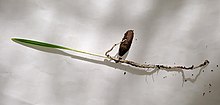


Fungal mycelium grown in culture dish

N
[edit]- native
- Naturally occurring in an area, but not necessarily confined to it. Compare endemic.
- natural hybrid
- A hybrid taxon produced by chance in the wild.
- naturalised
- Describing a plant, introduced from another region, that grows and reproduces readily in competition with the natural flora.
- nectar
- A usually sweet, nutrient-rich fluid produced by the flowers of many plants and collected by bees and other pollinators.
- nectary
A specialized gland that secretes nectar.
- neophyte
- A plant that has recently been introduced to a geographic area. Contrast archaeophyte.
- nerve
- Another name for a vein.
- node
- The part of a stem from which leaves or branches arise.
- nomen conservandum
- (Latin) A conserved name, usually a name that became so much better known than the correct name, that a substitution was made.
- nomen illegitimum
- A name that is either superfluous at its time of publication because the taxon to which it was applied already has a name, or the name has already been applied to another plant (a homonym).
- nomen invalidum
- A name that is not validly published, and technically is therefore not a botanical name. Abbreviation: nom. inval. See valid publication.
- nomen nudum
- A name not published in accordance with the International Code of Nomenclature for algae, fungi, and plants, usually without a diagnosis or description of the entity to which it applies, and without reference to either; such a name should not be used.
- nomenclature
- The naming of things; often restricted to the correct use of scientific names in taxonomy; a system that sets out provisions for the formation and use of names.
- noxious
- Of plants, containing harmful or unwholesome qualities. Applied in conjunction with 'weed' to specifically describe a plant which legislation deems harmful to the environment. Each state and territory in Australia has specific legislation governing noxious weeds.
- nucellus
- The tissue of the ovule of a seed plant that surrounds the female gametophyte. It is enclosed by integuments and is not of epidermal origin.
- numerous
- Stamens are described as numerous when there are more than twice as many as sepals or petals, especially when there is no set number of them. Compare indefinite.
- nut
- A hard, dry, indehiscent fruit containing only one seed.
- nutlet
- 1. A small nut.
- 2. One of the lobes or sections of the mature ovary of some members of the Boraginaceae, Verbenaceae, and Lamiaceae.

Hoya carnosa secretes so much nectar that it falls in drops if no pollinators remove it.

The small green petals of Helleborus argutifolius act as floral nectaries. The sepals function as petals.

Some Senna species have extrafloral nectaries that attract ants to defend them from pests.

Plant stem nodes and internodes
O
[edit]- ob-
- A prefix meaning "inversely"; usually the same shape as that described by the word stem, but attached by the narrower end. See obcordate, oblanceolate and obovate.
- obconic
- (of a fruit, hypanthium, pistil, or calyx) Shaped like an inverted cone, attached at the apex.
- obcordate
- (of a leaf blade) Broad and notched at the tip; heart-shaped but attached at the pointed end.
- obdiplostemonous
- Having stamens arranged in two whorls, and having twice as many stamens as petals, with the outer whorl being opposite the petals. Compare diplostemonous and haplostemonous.
- oblanceolate
- Having a lanceolate shape but broadest in the upper third.
- oblate
- Having a spherical shape but flattened at the poles.
- obligate
- (of parasites) Unable to survive without a host. Contrast facultative.
- oblique
- Slanting; of a leaf or stem, larger on one side of the midrib than the other, in other words asymmetrical.
- obloid
- Having a three-dimensional oblong shape, e.g. a fruit.
- oblong
- Having a length a few times greater than the width, with sides almost parallel and ends rounded.
- obovate
- (of a leaf) Having a length about 1.5 times the width, and widest above the center.
- obsolete
- Not evident, or at most rudimentary or vestigial.
- obtrapeziform
- trapeziform, but attached by the narrower trapezoidal base (e.g. of a leaf)
- obtuse
- Blunt or rounded; having converging edges that form an angle of more than 90°. Compare acute.
- ocrea
A sheath formed from two stipules encircling the node in members of the Polygonaceae.
- odd-pinnate
Having an odd number of leaflets in a compound pinnate leaf, such that there is only one terminal leaflet.
- oft.
- An abbreviation of "often". Compare usu. and s.t..
- -oideae
- A suffix added to the stem of a generic name to form the name of a subfamily, e.g. Fumaria → Fumarioideae.
- olim
- Formerly, e.g. "olim B", formerly in the Berlin herbarium (Herbarium Berolinense).
- ontogeny
- The sequence of developmental stages through which an organism passes as it grows.
- operculum (calyptra)
- A lid or cover that becomes detached at maturity, e.g. in Eucalyptus, a cap covering the bud and formed by the fusion or cohesion of perianth parts.
- opposite
- 1. Describing leaves or flowers borne at the same level but on directly opposite sides of their common axis.
- 2. Describing the occurrence of something on the same radius as something else, e.g. anthers opposite sepals. Compare alternate.
- opus utique oppressum
Listed after the botanical name of a plant, or the name of a publication, this indicates that a publication is listed in the International Code of Nomenclature for algae, fungi, and plants as a suppressed work. Botanical names of the specified rank in the publication are considered not validly published (article 34).
- orbicular
- Flat and more or less circular.
- order
- A group of one or more families sharing common features, ancestry, or both.
- ortet
- The original single parent plant from which a clone ultimately derives.
- orthotropous
- Describes an ovule that is erect, with the micropyle directed away from the placenta; atropous. Compare amphitropous, anatropous, and campylotropous.
- oval
- See elliptical.
- ovary
- The basal portion of a carpel or group of fused carpels, enclosing the ovules.
- ovate
- Shaped like a section through the "long axis" of an egg and attached by the wider end.
- ovoid
- Egg-shaped, with wider portion at base; 3-dimensional object, ovate in all sections through long-axis.
- ovule
- Loosely, the seed before fertilization; a structure in a seed plant within which one or more megaspores are formed (after fertilization it develops into a seed).



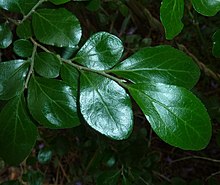
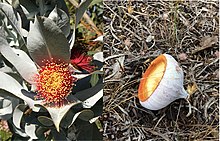
Open flower of Eucalyptus macrocarpa, next to a shed operculum

Opposite arrangement (phyllotaxis) of leaves

Orbicular leaves of Dombeya rotundifolia
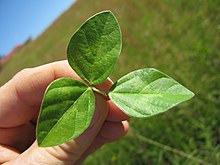
P
[edit]- pachycaul
- with a disproportionately thick trunk
- pachycladous
- with disproportionately thick stems
- palate
- An expanded lower lip of a flower that nearly or entirely blocks the opening of a flower tube, as in a snapdragon flower.[41]
- palea
1. The upper of two bracts enclosing a grass flower, major contributors to chaff in harvested grain.
- 2. Chaffy scales on the receptacles of many Asteraceae.
- 3. Chaffy scales on the stipe of many ferns.
- paleate
- Bearing paleae or chaffy scales, as in description of the receptacle of a capitulum of a plant in the Asteraceae.
- paleaceous
- Chaff-like in texture.
- palmate
- 1. leaf with veins radiating out from a central point (usually at the top of a petiole), resembling spread out fingers pointing away from the palm.
- 2. A compound palmate leaf has leaflets that radiate from a central point (usually at the top of a petiole).
- palmatifid
- Deeply divided into several lobes arising from more or less the same level.
- palmatisect
- Intermediate between palmate and palmatifid, i.e. the segments are not fully separated at the base; often more or less digitate.
- pandurate
- shaped like the body of a fiddle (mainly, of plant leaves)
- panicle
A compound raceme; an indeterminate inflorescence in which the flowers are borne on branches of the main axis or on further branches of these.
- papilionate
- Butterfly-like; having a corolla like that of a pea.
- papilla
A small, elongated protuberance on the surface of an organ, usually an extension of one epidermal cell.
- pappus
- In daisy florets, a tuft or ring of hairs or scales borne above the ovary and outside the corolla (representing the reduced calyx); a tuft of hairs on a fruit.
- paracarpel
- Ill-defined term, variously interpreted and applied to: organs attached to carpels; staminodes close to the gynoecium; and to a pistillode in a staminate flower
- paraperigonium
An anomalous secondary outgrowth of the perianthal meristem with ramifying vasculature. See also perigonium, perianth, and corona.[42]
- parasite
- An organism living on or in a different organism, from which it derives nourishment. Some plant species are parasitic. Compare saprophyte and epiphyte.
- parenchyma
- A versatile ground tissue composed of living primary cells which performs a wide variety of structural and biochemical functions in plants.
- parietal
- Attached to the marginal walls of a structure, e.g. ovules attached to placentas on the wall of the ovary. See placentation.
- paripinnate
- Having an even number of leaflets (or pinnae), i.e. terminated by a pair of pinnae as opposed to a single pinna. Compare imparipinnate.
- parthenocarpy
- The development or production of fruit without fertilization. Compare stenospermocarpy.
- patent
Spreading; standing at 45–50° to the axis. See also erecto-patent.
- patulous
- See patent.
- pauciflor
- Having few flowers per inflorescence. Compare pluriflor and uniflor.
- pectinate
- Pinnately divided with narrow segments closely set like the teeth of a comb.
- pedate
- Having a terminal lobe or leaflet, and on either side of it an axis curving outward and backward, bearing lobes or leaflets on the outer side of the curve.
- pedicel
The stalk of a flower; may also be applied to the stalk of a capitulum in the Asteraceae.
- peduncle
The stalk of an inflorescence.
- peltate
- Shield-like, with the stalk attached to the lower surface and not to the margin.
- pellucid
- Transmitting light; for example, said of tiny gland dots in the leaves of e.g. Myrtaceae and Rutaceae that are visible when held in front of a light.
- pendulous
- Hanging, for example an ovule attached to a placenta on the top of the ovary. Compare suspended.
- penicillate
- Tufted like an artist's brush; with long hairs toward one end.
- penninervation
With pinnately arranged veins.
- pentamerous
- In five parts, particularly with respect to flowers, five parts in each whorl. See also trimerous and tetramerous.
- pepo
- A type of berry formed from an inferior ovary and containing many seeds, usually large with a tough outer skin (e.g. a cucumber, pumpkin or watermelon).
- perennating
- Of an organ that survives vegetatively from season to season. A period of reduced activity between seasons is usual.
- perennial
- A plant whose life span extends over several years.
- perfect
- (of a flower) Bisexual; containing both male and female reproductive parts in the same inflorescence. Contrast imperfect.
- perfoliate
- With its base wrapped around the stem (so that the stem appears to pass through it), e.g. of leaves and bracts.
- perforate
- With many holes. Used to describe the texture of pollen exine, and also to indicate that tracheary elements have a perforation plate. See also fenestrate.
- perforation plate
- in a tracheary element, part of the cell wall that is perforated; present in vessel members but not in tracheids. Should not be confused with a pit.
- perianth
- The collective term for the calyx and corolla of a flower (generally used when the two are too similar to be easily distinguishable). Abbreviation: P; for instance, P 3+3 indicates the calyx and corolla each have 3 elements, i.e. 3 sepals + 3 petals.
- pericarp
- The wall of a fruit, developed from the ovary wall.
- periclinal
- Curved along parallel to a surface. Compare anticlinal.
- pericycle
- A cylinder of parenchyma or sclerenchyma cells that lies just inside the endodermis and is the outer most part of the stele of plants.
- perigonium
- In flowering plants, synonym of perianth.
- 2. In mosses, the leaves surrounding the antheridia, also called a splash-cup, e.g. in Polytrichum juniperinum.
- perigynium
- A sac from a modified tubular bract, or when fully closed an utricle, around the pistillate flower of sedges
- perigynous
- Borne around the ovary, i.e. of perianth segments and stamens arising from a cup-like or tubular extension of receptacle (free from the ovary but extending above its base). Compare epigynous and hypogynous.
- persistent
- Remaining attached to the plant beyond the usual time of falling, for instance sepals not falling after flowering, flower parts remaining through maturity of fruit. Compare deciduous and caducous.
- perule
1. The scales covering a leaf or flower bud, or a reduced scale-like leaf surrounding the bud. Buds lacking perulae are referred to as "naked".
- 2. In Camellias the final bracts and sepals become indistinguishable and are called perules.
- 3. A kind of sac formed by the adherent bases of the two lateral sepals in certain orchids.
- petal
- In a flower, one of the segments or divisions of the inner whorl of non-fertile parts surrounding the fertile organs, usually soft and conspicuously colored. Compare sepal, tepal.
- petalody
- The transformation of reproductive organs of flower into petals.
- petaloid
- Like a petal; soft in texture and colored conspicuously.
- petiolary (or petiolar)
- Associated with a petiole, as in petiolary glands.
- petiolate
- (of a leaf) Having a petiole. Contrast sessile.
- petiole
- The stalk of a leaf.
- petiolule
- The stalk of a leaflet.
- petricolous
- Rock-dwelling; living on or among rocks.
- phaneranthous
- Showy, as in showy flowers that advertise to pollinators, as opposed to aphananthous (unshowy)
- phanerogam
- Gymnosperms and angiosperms; plants producing stamens and gynoecia; literally plants with conspicuous sexual reproductive organs. Compare cryptogams.
- phenology
- The study of the timing of seasonal biological phenomena, such as flowering, leaf emergence, fruit ripening and leaf fall.
- phloem
- Specialized conducting tissue in vascular plants that transports sucrose from the leaves to other plant organs.
- photosynthesis
- Process by which energy from sunlight is used to convert carbon dioxide and water into simple sugars in cells containing chloroplasts. All plants, except certain parasites, can perform photosynthesis.
- phyllary
- Individual bract within an involucre or involucel.
- phyllid
- Leaf-like extension of the stem in Bryophytes
- phyllode
A leaf with the blade much reduced or absent, and in which the petiole and or rachis perform the functions of the whole leaf, e.g. many acacias. Compare cladode.
- phyllopodium
- (in ferns) A short outgrowth of the stem on which the frond is borne and which remains attached to the rhizome after the frond has been shed.
- phylloplane
- the surface of a leaf, considered as a habitat for organisms.
- phyllosphere
- The above-ground surface of plants as a habitat for epiphytic microorganisms.
- phylum
- A level of classification or taxonomic rank below kingdom and above class. Traditionally, in botany the term division has been used instead of phylum.
- phytomelan
A black, inert, organic material that forms a crust-like covering of some seeds, commonly found in Asparagales, Asteraceae, etc.
- pileate
- Having a cap, a pileus.
- pileus
- A cap or cap-shaped structure, such as the cap of mushrooms or the plumule of some monocotyledons.
- piliform
- Having the shape of a cap, a pileus.
- pilose
- covered with soft, weak, thin and clearly separated hairs, which are usually defined as long and sometimes ascending.
- pinna
A primary segment of a compound leaf.
- pinnate
- A compound leaf with leaflets arranged on each side of a common petiole or axis; also applied to how the lateral veins are arranged in relation to the main vein.
- pinnatifid
- Pinnately lobed.
- pinnatisect
- pinnately divided almost to midrib but segments still confluent.
- pinnule or pinnula
- Usage varies:
ultimate free division (or leaflets) of a compound leaf,
or
a pinnate subdivision of a multipinnate leaf. - pistil
- 1. a single carpel when the carpels are free.
- 2. a group of carpels when the carpels are united by the fusion of their walls.
- pistillate flower
- a flower containing one or more pistils but no fertile stamens. Sometimes called a female flower. Contrast with staminate flower
- pistillode
- A sterile or rudimentary pistil such as may appear in a staminate flower.
- pit
- In tracheary elements, a section of the cell wall where the secondary wall is missing, and the primary wall is present. Pits generally occur in pairs and link two cells.
- pith
- The central region of a stem, inside the vascular cylinder; the spongy parenchymatous central tissue in some stems and roots.
- placenta
- The tissue within an ovary to which the ovules are attached.
- placentation
- The arrangement of ovules inside ovary; for example axile, free-central, parietal, marginal, basal, or apical.
- Plant Breeders Rights (PBR)
- These rights, governed by Plant Breeder's Rights Acts give the plant breeder legal protection over the propagation of a cultivar, and the exclusive rights to produce and to sell it, including the right to license others to produce and sell plants and reproductive material of a registered, deliberately bred variety. Compare UPOV.
- Plant Variety Rights (PVR)
- Governed by the Plant Variety Rights the registration of new varieties is now governed by Plant Breeders Rights.
- plastochron
- The time between successive leaf initiation events.
- pleiochasium
- pl. pleiochasia. An inflorescence in which several buds come out at the same time. Compare monochasium and dichasium.
- plicate
- Pleated; folded back and forth longitudinally like a fan, such as the leaves of fan palm species. The concept often appears in specific names in forms such as Kumara plicatilis and Acacia plicata. Commonly such names are not correctly appropriate, but are applied to distichous structures rather than plicate.
- -plinerved
- (of leaves) A suffix indicating that the main nerves are lateral and arise from a point distinctly above the base of the leaf. Combined with a numerical prefix to form words like 3-plinerved, 5-plinerved, and so on. Such leaves are especially characteristic of the family Melastomataceae. See for example Dissotis.
- plumose
- Like a feather; with fine hairs branching from a main axis.
- plumule
- The part of an embryo that gives rise to the shoot system of a plant. Compare radicle.
- pluriflor
- Having many flowers per inflorescence. See also pauciflor and uniflor.
- pluriovulate
- Having many ovules as in placentae, carpels, or ovaries.
- pneumatophore
- A vertical appendage, aerial at low tide, on the roots of some plants. Pneumatophore functions are unclear, but possibly related to gas exchange, or to root anchoring. Pneumatophores typically occur on mangrove roots, but some versions occur on species of conifers, such as some in the Taxodioideae.
- pod
- 1. A legume, the fruit of a leguminous plant, a dry fruit of a single carpel, splitting along two sutures.
- 2. A siliqua and silicula, the fruit of Brassicaceae, a dry fruit composed of two carpels separated by a partition.
- podocarpium
- In four genera of the coniferous family Podocarpaceae (Acmopyle, Dacrycarpus, Falcatifolium, and Podocarpus), a group of fleshy fused bracts beneath the female cone, often brightly-colored, which swell to enclose the developing seeds above and attract fruit-eating animals.[43]
- pollen
- powdery mass shed from anthers (of angiosperms) or microsporangia (of gymnosperms); the microspores of seed plants; pollen-grains.
- pollen-mass
- pollen-grains cohering by a waxy texture or fine threads into a single body; pollinium, e.g. in orchids.
- pollen transmitting tissue
- the tissue in the style of a flower through which the pollen tubes grow.
- pollination
- The transfer of pollen from a male organ (such as an anther) to the receptive region of a female organ (such as a stigma).
- pollinium
- See pollen-mass.
- polygamodioecious
- Having bisexual and male flowers on some plants and bisexual and female flowers on others. Compare androdioecious, andromonoecious, dioecious, monoecious, polygamomonoecious, and polygamous.
- polygamomonoecious
- having male, female, and bisexual flowers on the same plant. Compare androdioecious, andromonoecious, polygamodioecious, and polygamous.
- polygamous
- having bisexual and unisexual flowers on the same plant.
- polymorphic
- Of several different kinds (in respect to shape and/or size), hence polymorphism. See also monomorphic (a single type) and dimorphic (two types)
- polyphyllous
- having many leaves or perianth segments. Compare symphyllous, gamophyllous, and apophyllous.
- polyploid
- with more than two of the basic sets of chromosomes in the nucleus; any sporophyte with cells containing three or more complete sets of chromosomes. Various combinations of words or numbers with '-ploid' indicate the number of haploid sets of chromosomes, e.g. triploid = 3 sets, tetraploid = 4 sets, pentaploid = 5 sets, hexaploid = 6 sets, and so on.
- polystemonous
- having numerous stamens; the number of stamens being at least twice the number of sepals or petals, but not strictly three or four times that number.
- pome
- A fruit that has developed partly from the ovary wall but mostly from the hypanthium (e.g. an apple).
- population
- 1. All individuals of one or more species within a prescribed area.
- 2. A group of organisms of one species, occupying a defined area and usually isolated to some degree from other similar groups.
- 3. In statistics, the whole group of items or individuals under investigation.
- poricidal
- Opening by pores, as with the capsule of a poppy or the anthers in several families of plants. Compare longicidal.
- posterior
- Positioned behind or toward the rear. Contrast anterior.
- prickle
A hard, pointed outgrowth from the surface of a plant (involving several layers of cells but not containing a vein); a sharp outgrowth from the bark, detachable without tearing wood. Compare thorn.
- primary vein
- The single vein or array of veins that is conspicuously larger than any others in a leaf. In pinnate venation, the single primary vein can generally be found in the middle of the leaf; in palmate venation, several such veins radiate from a point at or near the base of the leaf.
- procumbent
- Spreading along the ground but not rooting at the nodes; not as close to the ground as prostrate.
- propagule
- Any structure capable of generating a new plant; includes seeds, spores, bulbils, etc.
- pro parte
- In part. In nomenclature, used to denote that the preceding taxon includes more than one currently recognized entity, and that only one of those entities is being considered.
- prophyll
- A leaf formed at the base of a shoot, usually smaller than those formed later.
- prostrate
- Lying flat on the ground; commonly rooting at nodes that touch the soil surface.
- protandrous
- Having male sex organs which mature before the female ones, e.g. a flower shedding pollen before the stigma is receptive. Compare protogynous.
- proteranthous
- With new leaves appearing before flowers. See also hysteranthous and synanthous.
- prothallus
- A gametophyte plant, usually flattened and delicate, e.g. in ferns and fern allies.
- protogynous
- Having female sex organs which mature before the male ones, e.g. a flower shedding pollen after the stigma has ceased to be receptive. Compare protandrous.
- proximal
- Near the point of origin or attachment. Compare distal.
- pruinose
- Covered with a powdery, waxy material; having a bloom.
- pseudanthium
- A type of inflorescence occurring in the Asteraceae and Euphorbiaceae, in which multiple flowers are grouped together to form a flower-like structure, commonly called a head or capitulum.
- pseudo-
- A prefix meaning "false, not genuine", e.g. a pseudo-bulb is a thickened, bulb-like internode in orchids, but not an actual bulb.
- pseudobasifixed
- (of an anther) Connected to the filament of the stamen by connective tissue which extends in a tube around the filament tip. See also basifixed and dorsifixed.
- pseudostipule
- An enlarged, persistent axillary bud scale that resembles a stipule; common in Bignoniaceae.
- pseudoverticillate
- Having the appearance of being whorled (verticillate), without actually being so.
- puberulous
Covered with minute soft erect hairs.
- pubescent
- Downy; covered with short, soft hairs, especially erect hairs.
- pulverulent
- Having powdery or crumbly particles as if pulverized.
- pulvinate
- Having a pulvinus.
- pulvinus
- a swelling at either end of a petiole of a leaf or petiolule of a leaflet, e.g. in Fabaceae, that permits leaf movement.
- punctate
- (from Latin puncta= puncture or prick-mark) marked with an indefinite number of dots, or with similarly small items such as translucent glands or tiny hollows.
- punctiform
- Dot-like or in the shape of a prick-mark.
- pungent
- Having a sharp, hard point.
- pustule
- A blister-like swelling.
- pustulate
- Having pustules.
- pyramidal
- (of a growth habit) Conical or pyramid-shaped. Most familiar in some coniferous trees, especially species adapted to snowy climates
- pyrene
- The stone of a drupe, consisting of the seed surrounded by the hardened endocarp.
- pyriform
- Pear-shaped; a term for solid shapes that are roughly conical in shape, broadest one end and narrowest at the other. As a rule the distal third of their length is the broadest, and they are narrowest near the proximal end, the base, where the stalk, if any, attaches.
- pyrophile
- Plants which need fire for their reproduction.
- pyrophyte
- Plants which have adapted to tolerate fire.

The thick trunk of Brachychiton rupestris accumulates moisture as a means of survival of droughts, and presents a marked example of a pachycaul habit.

This Curio articulatus is pachycladous in that it has a disproportionately thick stem.
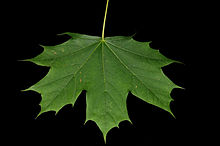
A maple (Acer platanoides) leaf has palmate venation, as its veins radiate out from a central point, like fingers from the palm of a hand.


Asclepias physocarpa shedding seeds, each with its silky pappus
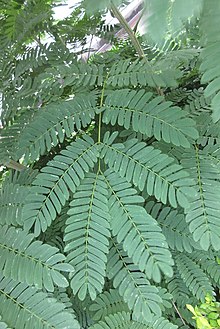
Doubly paripinnate leaves of Delonix regia


Stephania japonica is a vine with peltate leaves.
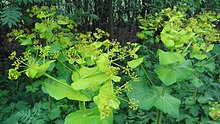
Perfoliate leaves of Smyrnium perfoliatum with stems passing through them

The leaves of Aponogeton madagascariensis are perforate.

The perigonium of a moss (red in this case), also called a splash-cup, surrounds the antheridia and aids in dispersal of sperm.

Liquidambar styraciflua bud emerging from its protective brown imbricate cataphyll scales, also known as perules


Petiolary glands on the petiole of a cherry leaf

Rock-splitting roots of the petricolous large-leaved rock fig, Ficus abutilifolia

The phaneranthous habit of the red flowering gum, Corymbia ficifolia, can attract pollinators such as the honey eater, Anthochaera chrysoptera, from a considerable distance.

Seedlings of Acacia fasciculifera bear leaves that illustrate the ancestral function of their phyllodes as petioles.


Glandular pilose hairs on the stem of Aquilegia grata


Simple pinnate leaf of Ekebergia capensis


Electron micrographs of sections of wood of a conifer (Picea abies) show pits in the tracheid walls.
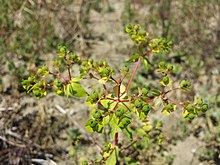


Longitudinal section of maize kernel (scale=1.4 mm):
A=pericarp, B=aleurone, C=stalk, D=endosperm, E=coleorhiza, F=radicle, G=hypocotyl, H=plumule, I=scutellum, J=coleoptile
A=pericarp, B=aleurone, C=stalk, D=endosperm, E=coleorhiza, F=radicle, G=hypocotyl, H=plumule, I=scutellum, J=coleoptile
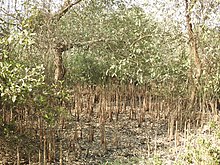
Pneumatophores on a species of mangrove

The sharp projections on the trunk of the knobthorn, Senegalia nigrescens, are prickles rather than thorns, botanically speaking.

Procumbent growth habit of Sagina procumbens, growing mainly along the soil surface, but without rooting

Carpobrotus and other prostrate plants growing on sand in Sicily, striking root and binding the soil as they grow

Floral stages of the protandrous species: Geranium incanum. The flower at first has intensely colored petals, and both androecium and gynoecium. After a day or so in bloom, it sheds the stamens and the color of the petals becomes somewhat paler.


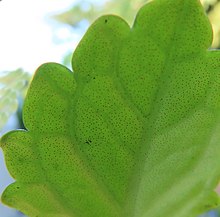
Punctiform glands on the undersurface of a Plectranthus leaf


Q
[edit]- quadrate
- More or less square.

R
[edit]- raceme
An indeterminate inflorescence in which the main axis produces a series of flowers on lateral stalks, the oldest at the base and the youngest at the top. Compare spike. Also racemiform or racemoid - having the form of a raceme.
- rachilla (rhachilla)
- 1. the axis of a grass spikelet, above the glumes; see spikelet.
- 2. the rachis of higher order in leaves that are compound more than once
- rachis
The axis of an inflorescence or a pinnate leaf; for example ferns; secondary rachis is the axis of a pinna in a bipinnate leaf distal to and including the lowermost pedicel attachment.
- radial
- With structures radiating from a central point as spokes on a wheel (e.g. the lateral spines of a cactus).
- radiate
- (of daisies, of a capitulum) With ray floret surrounding disc florets.
- radical
- Springing from the root; clustered at base of stem.
- radicle
- The part of an embryo giving rise to the root system of a plant. Compare plumule.
- rainforest
- A moist temperate or tropical forest dominated by broad-leaved trees that form a continuous canopy.
- ramet
- An individual member of a clone.
- ramicaul
- a single-leafed stem, as in Pleurothallis orchids.[44]
- ramify
- To divide or spread out into individual branches or branchlike parts.
- ray
- 1. zygomorphic (ligulate) flowers in a radiate flowerhead, that is, ray-florets/flowers, for example Asteraceae.
- 2. each of the branches of an umbel.
- receptacle
- the axis of a flower, in other words, floral axis; torus; for example in Asteraceae, the floral base or receptacle is the expanded tip of the peduncle on which the flowers are inserted.
- recumbent
- bent back toward or below the horizontal.
- recurved
- bent or curved backward or downward.
- reduplicate
- folded outward, or with the two abaxial surfaces together.
- reflexed
- bent sharply back or down.
- registered name
- a cultivar name accepted by the relevant International Cultivar Registration Authority.
- registration
- 1. the act of recording a new cultivar name with an International Cultivar Registration Authority.
- 2. recording a new cultivar name with a statutory authority like the Plant Breeder's Rights Office.
- 3. recording a trademark with a trade marks office.
- regular
- See actinomorphic.
- reniform
- Kidney-shaped.
- replum
- a framework-like placenta to which the seeds attach, and which remains after each valve drops away.
- resupinate
- Describing leaves or flowers that are in an inverted position because the petiole or pedicel, respectively, is twisted 180 degrees. compare: hyper-resupinate.
- reticulate
- forming a network (or reticulum), e.g. veins that join one another at more than one point.
- retrorse
- Bent backward or downward. Compare antrorse.
- retuse
- Having a blunt (obtuse) and slightly notched apex.
- revision
- an account of a particular plant group, like an abbreviated or simplified monograph. Sometimes confined to the plants of a particular region. Similar to a monograph in clearly distinguishing the taxa and providing a means for their identification. Compare monograph.
- revolute
- rolled under (downward or backward), for example when the edges of leaves are rolled under toward the midrib. Compare involute.
- rhachis
- See rachis.
- rhizodermis
- the root epidermis, the outermost primary cell layer of the root
- rhizome
- a perennial underground stem usually growing horizontally. See also stolon. Abbreviation: rhiz.
- rhizomatous
- (adj.) having above-ground stems that are derived from below-ground stems (rhizomes). Compare arhizomatous (arhizomatic).
- rhizosphere
- the below-ground surface of plants and adjacent soil as a habitat for microorganisms.
- rhytidome
- the dead region of the bark and root that lies outside the periderm.
- rhombic
- like a rhombus: an oblique figure with four equal sides. Compare trapeziform and trullate.
- rhomboid
- a four-sided figure with opposite sides parallel but with adjacent sides an unequal length (like an oblique rectangle); see also rhombic.
- rhomboidal
- a shape, for instance of a leaf, that is roughly diamond-shaped with length equal to width.
- rimose
- with many cracks, as in the surface of a crustose areolate lichen.
- root
- a unit of a plant's axial system which is usually underground, does not bear leaves, tends to grow downward, and is typically derived from the radicle of the embryo.
- root hairs
- outgrowths of the outermost layer of cells just behind the root tips, functioning as water-absorbing organs.
- root microbiome
- the dynamic community of microorganisms associated with plant roots.
- rootstock
- 1. the part of a budded or grafted plant which supplies the root system, also simply called a stock.
- 2. plants selected to produce a root system with some specific attribute, e.g. a virus-free rootstock.
- rosette
- when parts are not whorled or opposite but appear so, due to the contractions of internodes, e.g. the petals in a double rose or a basal cluster of leaves (usually close to the ground) in some plants.
- rostellate
- possessing a beak (rostellum). Synonym of rostrate.
- rostrate
- with a beak.
- rotate
- circular and flattened; for example a corolla with a very short tube and spreading lobes (for instance some Solanaceae).
- ruderal
- a plant that colonises or occupies disturbed waste ground. See also weed.
- rudiment
- In the structure of a plant, an item that is at best hardly functional, either because it is immature and has not yet completed its development (such as a leaf still incompletely formed inside a bud), or because its role in the organism's morphology cannot be completed and therefore is futile (such as the leaf rudiment at the tip of a phyllode, that will be shed while immature, because the leaf function will be taken over by the phyllode). Compare cataphyll and vestige.
- rudimentary
- Being of the nature of a rudiment; at most barely functional because incompletely developed; begun, but far from completed, either temporarily or permanently. Compare vestigial.
- rugose
- Wrinkled, either covered with wrinkles, or crumpled like a wrinkled leaf, either as a stiffening structure, or in response to disease or insect damage.
- rugulose
- Finely wrinkled.
- ruminate
- (usually applied to endosperm) Irregularly grooved or ridged; appearing chewed, e.g. the endosperm in certain members of Myristicaceae.
- runcinate
- Sharply pinnatifid or cleft, with the segments directed downward.
- runner
- See stolon.
- rupicolous
- Rupestral, saxicolous, growing on or among rocks. Compare epilithic and lithophytic.
- rush
- A plant of the family Juncaceae or, more loosely, applied to various monocotyledons.

Bulbinella latifolia racemes. The flowers are already open at the bottom; at the top, the axis is still growing and budding.

Rachis of Vachellia karroo bipinnate leaf, with components labelled as follows:
A. Rachilla (the diminutive of rachis)B. Pinnule
C. Jugary glands
D. Juga (plural of jugum)
E. Base of petiole
F. Petiolary gland
G. Rachis

Radicles emerging from germinating seeds
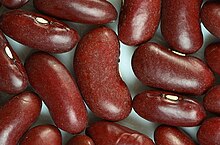
Reniform kidney bean seeds



Typical rhizome. This one is a specimen of Iris pseudacorus.
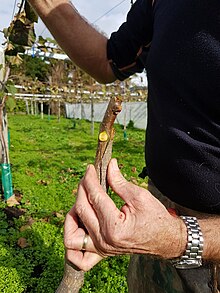




The runcinate lobes of a Taraxacum officinale leaf point downward, i.e. toward the stem.
S
[edit]- saccate
- Pouched or shaped like a sack.
- sagittate
- Shaped like the head of an arrow; narrow and pointed but gradually enlarged at the base into two straight lobes directed downward; may refer only to the base of a leaf with such lobes. Compare hastate.
- salverform
- Shaped like a salver - Trumpet-shaped; having a long, slender tube and a flat, abruptly expanded limb
- samara
- A dry, indehiscent fruit with its wall expanded into a wing, e.g. in the genus Acer.
- samphire
- A common name given to various edible coastal plants, such as Salicornia spp. (Amaranthaceae), Crithmum maritimum (Apiaceae) and Limbarda crithmoides (Asteraceae).
- sanguine
- (from Latin sanguineus) Blood-colored: crimson; the color of blood.
- saprophyte
A plant, or loosely speaking, a fungus or similar organism, deriving its nourishment from decaying organic matter such as dead wood or humus, and usually lacking chlorophyll. Compare parasite, saprotroph, and epiphyte.
- saprotroph
An organism deriving its nourishment from decaying organic matter. Contrast parasite and epiphyte.
- sarment
- A long, slender, prostrate stolon, commonly called a runner.
- sarmentose
- Reproducing by sarments; strawberry plants are the most familiar example.
- saxicolous
- Growing on stone, like some lichens.
- scabrid .
Rough to the touch, with short hard protrusions or hairs.
- scalariform
- Ladder-like in structure or appearance.
- scale
- 1. A reduced or rudimentary leaf, for example around a dormant bud.
- 2. A flattened epidermal outgrowth, such as those commonly found on the leaves and rhizomes of ferns.
- scandent
- Climbing, by whatever means. See also: scandent in Wiktionary.
- scape
Usages vary, e.g.: a leafless peduncle arising directly from the ground, or a stem-like flowering stalk of a plant with radical leaves.
- scapose
- Having the floral axis more or less erect with few or no leaves; consisting of a scape.
- scarious
- Dry and membranous.
- schizocarp
- A dry fruit formed from more than one carpel but breaking apart into individual carpels (mericarp) when ripe. For illustration, see mericarp
- scion
- The aerial part of a graft combination, induced by various means to unite with a compatible understock or rootstock.
- sclereid
- A cell with a thick, lignified, cell wall that is shorter than a fiber cell and dies soon after the thickening of its cell wall.
- sclerenchyma
- A strengthening or supporting tissue composed of sclereids or of a mixture of sclereids and fibers.
- sclerophyll
A plant with hard, stiff leaves; any structure stiffened with thick-walled cells.
- scorpioid
- (of a cymose inflorescence) Branching alternately on one side and then the other. Compare helicoid.
- scrobiculate
- Having very small pits.
- scrubland
- Dense vegetation dominated by shruba.
- scurf
- Minute, loose, membranous scales on the surface of some plant parts, such as leaves.
- secondary metabolite
- Chemicals produced by a plant that do not have a role in so-called primary functions such as growth, development, photosynthesis, reproduction, etc.
- secretory tissue
- The tissues concerned with the secretion of gums, resins, oils and other substances in plants.
- section (sectio)
- The category of supplementary taxa intermediate in rank between subgenus and series. It is a singular noun always written with a capital initial letter, in combination with the generic name.
- secund
- Having all the parts grouped on one side or turned to one side (applied especially to inflorescences).
- sedge
- A plant of the family Cyperaceae.
- seed
- A ripened ovule, consisting of a protective coat enclosing an embryo and food reserves; a propagating organ formed in the sexual reproductive cycle of gymnosperms and angiosperms (together, the seed plants).
- segment
- A part or subdivision of an organ, e.g. a petal is a segment of the corolla. A term sometimes used when the sepals and petals are indistinguishable.
- self-pollination
- (also selfing) The acceptance by stigmas of pollen from the same flower or from flowers on the same plant, which means they are self-compatible.
- semaphyll
- A structure such as a bract or sepal (if the remainder of the perianth is inconspicuous) which has become modified to attract pollinators.
- semelparity
- When a plant flowers once then dies.
- semiterete
- Rounded on one side but flat on the other. See also terete.
- senecioid
- See anthemoid.
- sensitive
- A descriptive term for stigmas that, in response to touch, close the two lobes of the stigma together, ending the receptivity of the stigma, at least for the time that the lobes are closed together. Mimulus is perhaps the best-known example.
- sensu
- In the sense of.
- sensu auct.
- (of a plant group or name) As cited by a named authority.
- sensu amplo
- (of a plant group or name) In a generous or ample sense.
- sensu lato
- (of a plant group) In a broad sense.
- sensu strictissimo
- (of a plant group) In the narrowest sense.
- sensu stricto
- (of a plant group) In a narrow sense.
- sepal
- In a flower, one of the segments or divisions of the outer whorl of non-fertile parts surrounding the fertile organs; usually green. Compare petal, tepal.
- septicidal
- (of a fruit) Dehiscing along the partitions between loculi. Compare loculicidal.
- septum
A partition, e.g. the membranous wall separating the two valves of the pod of Brassicaceae.
- seriate
- Arranged in rows.
- sericeous
- Silky with dense appressed hairs.
- series
- The category of supplementary taxa intermediate in rank between section and species. It is often used as a plural adjective, as in "Primula subgenus Primula sect. Primula series Acaules".
- serrate
- Toothed with asymmetrical teeth pointing forward; like the cutting edge of a saw.
- serrulate
- Finely serrate.
- sessile
- Attached without a stalk, e.g. of a leaf without a petiole or a stigma, when the style is absent.
- seta
A bristle or stiff hair (in Bryophytes, the stalk of the sporophyte). A terminal seta is an appendage to the tip of an organ, e.g. the primary rachis of a bipinnate leaf in Acacia.
- sheath
- A tubular or rolled part of an organ, e.g. the lower part of the leaf in most grasses.[45]
- sheathing
- When the rolled or tubular part of a plant contains another it is described as sheathing.[45]
- shoot
- The aerial part of a plant; a stem and all of its dependent parts (leaves, flowers, etc.).
- shrub
- A woody perennial plant without a single main trunk, branching freely, and generally smaller than a tree.
- sigmoid
- Shaped like the letter 'S'.
- silicula or silicle
- A fruit like a siliqua, but stouter, not more than twice as long as wide.
- silique
- siliqua
- A dry, dehiscent fruit (in contrast to a silicula, more than twice as long as wide) formed from a superior ovary of two carpels, with two parietal placentas and divided into two loculi by a 'false' septum.
- silky
- Densely covered with fine, soft, straight, appressed hairs, with a lustrous sheen and satiny to the touch.
- silviculture
- The science of forestry and the cultivation of woodlands for commercial purposes and wildlife conservation.
- simple
- Undivided or unsegmented, e.g. a leaf not divided into leaflets (note, however, that a simple leaf may still be entire, toothed or lobed) or an unbranched hair or inflorescence.
- sinuate
- Having deep, wave-like depressions along the margins, but more or less flat. Compare undulate.
- sinus
- A notch or depression between two lobes or teeth in the margin of an organ.
- solitary
- Single, of flowers that grow one plant per year, one in each axil, or widely separated on the plant; not grouped in an inflorescence.
- sorus
A cluster of sporangia. Sori typically occur in ferns, some Algae and some fungi. In many fern species the sorus is covered by a protective indusium.
- sp.
- An abbreviation of species (singular), often used when the genus is known but the species has not been determined, as in "Brassica sp." See spp..
- spp.
- An abbreviation of species (plural), often used to collectively refer to more than one species of the same genus, as in "Astragalus spp." See sp..
- spadix
- A spicate (spike-like) inflorescence with the flowers crowded densely, even solidly, around a stout, often succulent axis. Particularly typical of the family Araceae
- spathe
A large bract ensheathing an inflorescence. Traditionally any broad, flat blade.
- spathulate or spatulate
- Spoon-shaped; broad at the tip with a narrowed projection extending to the base.
- species
- A group, or populations of individuals, sharing common features and/or ancestry, generally the smallest group that can be readily and consistently recognized; often, a group of individuals capable of interbreeding and producing fertile offspring. The basic unit of classification, the category of taxa of the lowest principal rank in the nomenclatural hierarchy. Strict assignment to a species is not always possible, as it is subject to particular contexts, and the species concept under consideration.
- specific epithet
- Follows the name of the genus, and is the second word of a botanical binomial. The generic name and specific epithet together constitute the name of a species, i.e. the specific epithet is not the species name.
- speirochoric
- Unintentional introduction by seeds.[46] Compare agochoric.
- spica
Another name for a spike.
- spike
An unbranched, indeterminate inflorescence in which the flowers are without stalks. Compare raceme.
- spikelet
- A subunit of a spike inflorescence, especially in grasses, sedges, and some other monocotyledons, consisting of one to many flowers and associated bracts or glumes.
- spine
A stiff, sharp structure formed by the modification of a plant organ that contains vascular tissue, e.g. a lateral branch or a stipule; includes thorns.
- spinescent
- Ending in a spine; modified to form a spine.
- spiral
- Of arrangement, when plant parts are arranged in a succession of curves like the thread of a screw, or coiled in a cylindrical or conical manner.
- splash-cup (sporangia)
- A cup-like structure in fungi such as Nidulariaceae and in cryptogams such as some mosses. The cups function in spore dispersal, in which the energy of raindrops falling into the cup causes the water to splash outward carrying the spores.[47]
- sporangium (sporangia)
- A structure in which spores are formed and from which the mature spores are released
- sporangiophore
- An organ bearing sporangia, e.g. the cones of Equisetum.
- spore
- A haploid propagule, produced by meiosis in diploid cells of a sporophyte that can germinate to produce a multicellular gametophyte.
- sporocarp
- A fruiting body containing spores.
- sporophyll
- In pteridophytes, a modified leaf that bears a sporangium or sporangia.
- sporophyte
- The diploid multicellular phase in the alternation of generations of plants and algae that produces the spores. Compare gametophyte.
- sport
- A naturally occurring variant of a species, not usually present in a population or group of plants; a plant that has spontaneously mutated so that it differs from its parent plant.
- spreading
- Extending horizontally, e.g. in branches. Standing out at right angles to an axis, e.g. in leaves or hairs.
- spur
- 1. a short shoot.
- 2. a conical or tubular outgrowth from the base of a perianth segment, often containing nectar.
- squamule
Small scales.
- squamulose
- Covered with small scales (squamules).
- squarrose
- Having tips of leaves, stems, etc. radiating or projecting outward, e.g. in the moss Rhytidiadelphus squarrosus.
- s.t.
- An abbreviation for "sometimes". Compare usu. and oft..
- stalk
- The supporting structure of an organ, usually narrower in diameter than the organ itself.
- stamen
The male organ of a flower, consisting (usually) of a stalk called the filament and a pollen-bearing head called the anther.
- staminate flower
A flower with stamens but no pistil.
- staminode
- A sterile stamen, often rudimentary, sometimes petal-like. Commonly has a function in attracting pollinators that feed on the staminodes.
- staminophore
- A structure, around the apex of eucalypt, myrtaceae hypanthia, that supports the stamens.
- standard
- The large posterior petal of pea-flowers.
- standard specimen
- A representative specimen of a cultivar or other taxon which demonstrates how the name of that taxon should be used.
- stele
- The primary vascular system (including phloem, xylem, and ground tissue) of plant stems and roots.
- stellate
- Star-shaped.
- stem
- The plant axis, either aerial or subterranean, which bears nodes, leaves, branches, and flowers.
- stem-clasping
- See amplexicaul.
- stenospermocarpy
- The development or production of fruit that is seedless or has minute seeds because of the abortion of seed development. Compare parthenocarpy.
- sterile
- Infertile, as with a stamen that does not bear pollen or a flower that does not bear seed.
- stigma
- The pollen-receptive surface of a carpel or group of fused carpels, usually sticky; usually a point or small head at the summit of the style.
- stipe
- Generally a small stalk or stalk-like structure. The stalk of a frond of a fern; the stalk supporting the pileus of a mushroom; the stalk of a seaweed such as a kelp; the stalk-like support of a gynaecium or a carpel
- stipella
One of two small secondary stipules at the base of leaflets in some species.
- stipitate
- stalked; borne on a stipe; of an ovary, borne on a gynophore.
- stipulate
- Bearing stipules.
- stipule
- A small appendage at the bases of leaves in many dicotyledons.
- stock
- See rootstock.
- stolon
A slender, prostrate or trailing stem, producing roots and sometimes erect shoots at its nodes. See also rhizome.
- stoloniferous
- Having stolons.
- stoma
A pore or small hole in the surface of a leaf (or other aerial organ) allowing the exchange of gases between tissues and the atmosphere.
- stone cell
- a sclereid cell, such as the cells that form the tissue of nut shells and the stones of drupes.
- striate
- Striped with parallel, longitudinal lines or ridges.
- strigillose
- Minutely strigose.
- strigose
- Covered with appressed, straight, rigid, bristle-like hairs; the appressed equivalent of hispid.
- strobilus
A cone-like structure consisting of sporophylls (e.g. conifers and club mosses) or sporangiophores (e.g. in Equisetopsida) borne close together on an axis.
- style
- An elongated part of a carpel or a group of fused carpels between the ovary and the stigma.
- stylodium
- An elongate stigma that resembles a style; a false style, e.g. commonly found in the Poaceae and Asteraceae.
- stylopodium
- A swelling on top of the ovary, at the base of the styles commonly found in flowers of the Apiaceae.
- stylulus
- The elongated apex of a free carpel which functions like the style of a syncarpous ovary, allowing pollen tubes from its stigma to enter the locule of only that carpel.
- subacute
- Having a tapered but not sharply pointed form; moderately acute. See also acute.
- subcoriaceous
- Slightly leathery or coriaceous.
- subgenus
- A category of supplementary taxa intermediate between genus and section. The name of a subgenus is a singular noun, always has a capital initial letter and is used in combination with the generic name, e.g. Primula subgenus Primula.
- почти шаровидный
- Надутый, но менее сферический. См. также глобальный .
- суборбикулярный
- Очертания почти округлые, плоские и почти круглые. См. также округлую форму .
- субпетиальный
- (листа ) Имеет очень короткий черешок и может казаться сидячим .
- подчетырёхугольный
- Не совсем квадратный. Сравните четырехугольный .
- полукустарник
Небольшой кустарник , который может иметь частично травянистые стебли, но обычно представляет собой древесное растение высотой менее 1 метра (3,3 фута).
- подвид
- Таксономическая категория внутри вида , обычно используемая для географически изолированных или морфологически различных популяций одного и того же вида. Его таксономический ранг происходит между видом и разновидностью .
- стягивать
- Стоять ниже или близко к нему, как в прицветнике у основания цветка.
- шиловидный
- Узкие и постепенно сужающиеся к тонкой точке.
- сочный
- 1. Сочный или мясистый.
- 2. Растение с мясистым габитусом.
- лох
- Побег ; более или менее подземного происхождения прямостоячий побег , берущий начало из почки на корне или корневище , иногда на некотором расстоянии от стебля растения.
- суфрутекс
Полукустарник или полукустарник .
- бороздить
- бороздчатый; рифленый. Могут быть одиночными ( однобороздчатые ), двумя ( двубороздчатыми ) или многочисленными ( полисулькатными ).
- поверхностный
- На поверхности.
- верхний яичник
- Завязь расположена над уровнем прикрепления других частей цветка или над основанием гипантия . Сравните нижний яичник и полунижний яичник .
- приостановленный
- Из семязачатка , прикрепившегося немного ниже вершины завязи. Сравните подвесной .
- шов
- Соединение или шов соединения. См. трещину и спайку .
- меч
- Обширное, более или менее ровное покрытие поверхности, например, газонная трава. Сравните кочку .
- симпатрический
- Имеющие более или менее схожие или перекрывающиеся ареалы распространения.
- симподиальный
- Способ роста, при котором главная ось неоднократно прекращается и заменяется боковой ветвью. Примеры встречаются в семействе Combretaceae , включая роды Terminalia и Combretum . Сравните моноподиал .
- сикониум
- Полое соплодие, содержащее несколько плодов , например, у инжира .
- его-
Приставка, означающая «с, вместе».
- симметричный
- Способен делиться как минимум на две равные половины зеркального отображения (например, зигоморфный ) или иметь вращательную симметрию (например, регулярный или актиноморфный ). Сравните нерегулярные и асимметричные .
- симпатичный
- сросшиеся ( сросшиеся или сросшиеся) Лепестки , несвободные ( апопетальные ). См. также синтепалозные (со сросшимися листочками околоцветника ).
- симфилильный
- одиночный оборот околоцветника из соединенных долек. Сравните гамофилный ( синоним ), апофильный и полифильный .
- синангий
- Сросшаяся совокупность спорангиев , например, в трехгнездных спорангиях папоротника-венчика Psilotum .
- синантовый
- Тип роста, при котором новые листья и цветы появляются и отмирают одновременно. См. также истерантный и протерантный .
- синаптоспермия
- Распространение диаспор как единиц, каждое из которых несет более одного семени, например, когда каждая диаспора включает целое соцветие, как у Brunsvigia , или многосемянные плоды, как у Tribulus zeyheri. Эфемерная синаптоспермия — это термин, обозначающий ситуацию, когда диаспоры разделяются на единицы, содержащие меньшее количество семян или отдельные семена, как у большинства перекати-поле . Истинная синаптоспермия — это когда диаспора обычно остается целой до прорастания, как это обычно бывает у видов Grielum .
- синкарпный
- (гинецея ) Состоит из сросшихся плодолистиков s.
- синоним
- Устаревшее или «альтернативное» название того же таксона.
- единородный
- Синоним слова бисексуал .
- синтепалный
- Сросшиеся листочки околоцветника . См. также симпетальные (со сросшимися лепестками ).

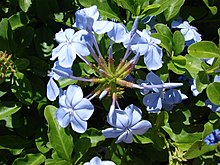
Salverform flowers of Plumbago auriculata

Trametes versicolor, the turkey tail fungus, is a saprotroph that consumes dead wood in forests. Its common name comes from the conspicuously patterned brackets, but the main body of the saprotroph consists of the largely invisible mycelium that penetrates the dead wood and digests it.


Micrograph of the scabrid undersurface of the leaf of Stipa pulcherrima.
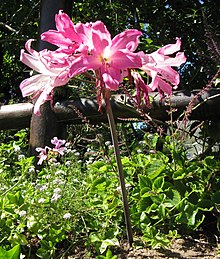
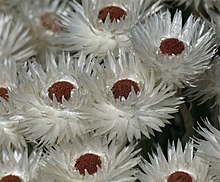
Involucral bracts of Syncarpha species are as scarious as tissue paper, but look like live petals for years, so they are known as "Everlastings" and valued for dried arrangements.

Isolated sclereid or stone cell in plant tissue
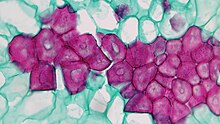
Sclereids in gritty particles of pear tissue

Sepals on Geranium thunbergii, five separated behind the petals of an open flower, and a connected set enclosing an unopened bud
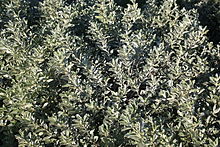


Silky foliage of the silvertree, Leucadendron argenteum

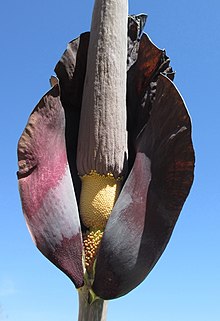
Spadix of Amorphophallus maximus within its spathe. The female flowers are around the bottom of the spadix, the male flowers above, and the sterile top part is the major source of pollinator attractants.


Drosera spatulata leaves are markedly spathulate.

The flowering spike of this Salvia nemorosa differs from a raceme in that the flowers are practically sessile.


Spinescent leaves of Salsola australis: stiff, narrowed, and with lobes ending in spiny points

Bird nest fungi, Nidulariaceae, bear examples of splash-cups with spores that are spread by raindrops.

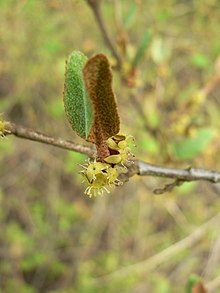
Staminate flowers of Shepherdia canadensis

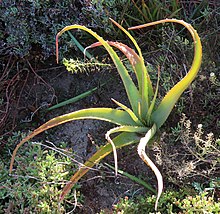

The large, succulent, acaulescent, linear, cuspidate mottled leaves of a Gasteria species and the small, succulent, cordate leaves of a Crassula species contrast with the linear, herbaceous leaves of a Hypoxis species.

Suckers around the trunk of Dypsis lutescens

Sulcate (specifically polysulcate) grooves along the stem of Scorzonera cana

Superior ovary ovary in an Aloe species. One flower is sectioned to display the pistil and hypanthium.

The suture along the concave curve of the pod of a Crotalaria incana, along which the seeds are attached, is where the single carpel has folded shut.

Т
[ редактировать ]- стержневой корень
- Основной нисходящий корень растения с единственной доминирующей корневой осью.
- тартарный
- Поверхность гладкая, толстая, шероховатая и крошащаяся.
- таксон
Группа или категория в системе биологической классификации.
- таксономия
- Изучение принципов и практики классификации.
- крышка
- Внутренний слой семенника ( семенная кожура). Развивается из покрова семязачатка внутреннего .
- усик
- Любой тонкий орган, модифицированный из стебля, листа, листочка или прилистника и используемый вьющимися растениями для цепляния за объект.
- околоцветник околоцветника
- Часть околоцветника , чашелистика или лепестка ; обычно применяют, когда все доли околоцветника внешне неразличимы.
- нагрузки
Круглый в сечении; более или менее цилиндрическая, без канавок и гребней.
- Терминал
- Расположен на кончике или вершине.
- тройной
- В группах по три человека; листьев, расположенных в мутовках по три; одного листа, листочки которого расположены группами по три.
- земной
- На земле или на земле; среды обитания, на суше, а не в воде ( водные ), на камнях ( литофитные ) или на других растениях ( эпифитные ).
- мозаика
- С трещинами или трещинами, расположенными в виде квадратов, придающими клетчатый вид. Обычно применяется к внешнему виду коры дерева.
- голова
- Семенная кожура.
- tetrad
- Группа из четырех человек; обычно используется для обозначения четырех пыльцевых зерен, которые остаются слитыми вместе на протяжении всего периода созревания (например, у Epacridaceae ). [48]
- четырехугольный
- Квадрат; имеющий четыре угла; четырехугольные, например, срезы стеблей травянистых яснотковых .
- четырехчленный
- В четырех частях, особенно о цветах; четыре части в каждом обороте. См. также трехчленный и пятичленный .
- тетраплоид
- Наличие четырех полных наборов хромосом в каждой клетке спорофита .
- тетраспора
- Бесполая спора красных водорослей . Он назван так потому, что каждый спорангий производит всего четыре споры. См . Rhodophyceae . [49]
- таламус
1. Синоним сосуда .
- 2. Диск соцветия представителей семейства Asteraceae .
- 3. Чашечка , использованная Карлом Линнеем .
- имеющие слоевищеподобное строение; в виде слоевища; слоевищный слой
- слоевище
Вегетативная структура, не дифференцированная на стебель и листья, как у лишайников , водорослей , слоевищ печеночников и некоторых сосудистых растений , например ряски.
- тека
- Один из двух синангиев , в которых у цветковых растений образуется пыльца. Он состоит из двух сросшихся спорангиев, известных как пыльцевые мешочки . Стенка между пыльцевыми мешками распадается до раскрытия, которое обычно представляет собой общую щель.
- шип
- Острый, жесткий кончик, обычно видоизмененный стержень , который невозможно отсоединить, не порвав прилегающую ткань; позвоночник. Сравните колючку .
- горло
- Раскрытие венчика или околоцветника .
- тирс
- Разветвленное соцветие, у которого главная ось неопределенная ( кистевидная ), а боковые ветви детерминированные ( цимозные ).
- войлочный
- Мгновенно войлочный.
- войлок
Плотный покров из коротких спутанных волосков. Войлочный волос часто используется как общий термин для обозначения волосяного покрова , но это не рекомендуется.
- зубчатый
- Наличие более или менее регулярно надрезанного края .
- тор
- См . розетку .
- передающая ткань
- См. ткань, передающая пыльцу .
- трапециевидный
- 1. Как трапеция (четырехсторонняя фигура с двумя параллельными сторонами неодинаковой длины).
- 2. Как трапеция (четырехсторонняя фигура, или четырехугольник , у которого ни одна пара сторон не равна); иногда ошибочно используется как синоним ромба .
- дерево
- Древесное растение, обычно с одним отчетливым стволом и обычно более 2–3 метров (6,6–9,8 футов) в высоту.
- триада
- Группа из трёх человек.
- треугольный
- Плоский и с 3-мя сторонами.
- племя
- Таксономическая группа, занимающая место между родом и семейством .
- трихома
- У ненитевидных растений — любой волосообразный отросток эпидермиса , например волосы или щетинки; иногда ограничиваются неразветвленными эпидермальными выростами.
- трихотомический
- 3-разветвленные или разветвленные на три. Сравните дихотомические .
- тройной
- Разделить на три части. См. также бифид .
- тройчатый
- Сложный лист из трёх листочков ; например, лист клевера .
- тройчатый
- См. тройчатый .
- треугольный
- Треугольная в поперечном сечении и тупоугольная. Сравните трехгранный .
- трехчленный
- В трех частях, особенно о цветах; имеющие по три части в каждом обороте. См. также четырехчленный и пятичленный .
- нервный
- Наличие трех нервов или вен .
- трилайнервед
- (листьев) Имеет три основных нерва, боковые нервы отходят от среднего нерва над основанием листа.
- трипорат
- (пыльцы) Имеющий три поры.
- трехгранный
- В поперечном сечении более или менее треугольный, но остроугольный (с 3 отчетливыми продольными гребнями). Сравните трехугольник .
- трехклапанный
- Разделен на три клапана . Также тривальвар . См. также двустворчатый моллюск .
- тривиальное имя
- Второе слово в двухсоставном научном названии организма. Сравните конкретный эпитет .
- трофилл
- Вегетативный лист или микрофилл , производящий питательные вещества , основной функцией которого является фотосинтез . Он не специализирован и не модифицирован для какой-либо другой функции. Сравните спорофилл .
- Труллат
- Яйцевидная форма каменщика , но угловатая, как мастерок ; обратно- воздушного змея . Сравните ромбические .
- обрезать
- Отрезать ровно; с резко поперечным концом.
- ствол
- Прямостоячий, большой и типично древесный главный ствол дерева.
- ферма
- Компактная гроздь цветов или плодов, возникающая из одного центра; проявляется у многих рододендронов .
- клубень
- Любой из многих типов специализированных вегетативных подземных запасающих органов. Они накапливают еду, воду или защищаются от гибели в результате пожара, засухи или других тяжелых времен. Клубни обычно хорошо отличаются от других органов растения; например, неофициально морковь обычно считают не клубнем, а просто набухшим корнем. В этом они отличаются от клубня батата, не имеющего особой корнеподобной функции. Точно так же клубнелуковицы обычно не считаются клубнями, хотя они представляют собой стебли, хранящиеся в подземных условиях. Клубни хранят пищу для растения, а также играют важную роль в вегетативном размножении . Обычно они бывают двух основных типов: стеблевые клубни образуются в результате набухания подземного стебля, растущего из корня, или из таких структур, как подземные столоны . стебля Стеблевые клубни обычно образуют размножающиеся почки в узлах , образуя сезонный многоплодный орган , например картофель . Основной другой класс — корнеклубень , называемый также тубероидом . От стеблевых клубней они отличаются такой особенностью, как то, что, как и любой нормальный корень, не образуют узлов.
- бугорок
- Небольшой бородавчатый вырост или выступ ткани.
- бугорчатый
- Покрыта бугорками . См . бородавчатый . [50]
- тубероид
- Альтернативное название подземного запасающего органа, образовавшегося в результате разбухания корня; встречается у многих орхидей .
- клубневый
- Напоминает клубень или дает клубни.
- трубчатый
- Имеющие форму трубки или цилиндра .
- хохлатый
- густо пучковый . На кончике
- туника
- Наружный покров некоторых луковиц и клубнелуковиц .
- оболочник
- ( луковиц ) Состоит из концентрических слоев.
- носовые раковины
- По форме напоминает волчок или свеклу .
- напыщенный
- Набухший от жидкости; раздутый; твердый. Сравните вялый .
- кочка
- Плотный пучок растительности, обычно хорошо отделенный от соседних кочек, например у некоторых трав. Сравните меч .
- двухранговый
- Имеющие листья, расположенные в два ряда в одной плоскости, на противоположных сторонах ветки. См . двустороннее .
- тип
- Предмет (обычно гербарный образец), к которому постоянно прикреплено название таксона, т.е. назначенный представитель названия растения. Важен при определении приоритета названий, имеющихся для конкретного таксона.
- Типовой род
- В номенклатуре - один род таксономическое семейство . , на котором основано
- Leucaena leucocephala Стержневой корень обнажен в результате выемки дороги
- Nerine Bowdenii , демонстрирующая отсутствие видимых чашелистиков и нижних завязей . Чашелистики включены в венчик в виде околоцветника листочков .
- Gymnosporia buxifolia имеет настоящие , шипы то есть видоизмененные ветви. У некоторых видов такие ветви укомплектованы почками и листьями.
- сладкого картофеля клубни Обнаженные показывают, что это корневые клубни. Морфологически они отличаются от стеблевых клубней картофеля, например, тем, что корневые клубни не имеют узлов , несущих почки. Однако корневые клубни некоторых видов растений могут давать придаточные почки для вегетативного размножения .
- Oxalis tuberosa , стеблевой клубень
- Клубнелуковицы Crocosmia растущими имеют типичную оболочку , образованную катафиллами, из узлов клубнелуковицы. На иллюстрации все еще живые катафиллы изображены в виде белой ткани, тогда как функциональная, твердая и устойчивая оболочка имеет коричневый цвет.
- Турбинные (волчковые) корни сахарной свеклы.
- Haworthia lockwoodii , листья которой становятся набухшими и зелеными после сезонных дождей, запасают воду на случай наступления засушливого периода.
- Кочки травы на горных склонах
В
[ редактировать ]- зонтик
- Соцветие кистевидное , в котором все отдельные цветоносы собираются в гроздь на верхушке цветоноса и имеют примерно одинаковую длину; у простого зонтика каждый стебель неразветвленный и несет только один цветок. Цимозный . зонтик внешне похож на обыкновенный зонтик, но его цветки раскрываются центробежно
- форма
- Округлое возвышение, например, в середине верхушки зонтика или гриба ; центральный выступ или выступ, например, масштабе конуса в .
- бонат
- Имеющий макушку с коническим или тупым выступом, возникающим на более плоской поверхности, как на верхушке гриба или в чешуе сосновой шишки .
- неровный
- Крюкообразный.
- развязывать
- Наличие крючка на вершине.
- полукустарник
- Невысокий кустарник , часто с цветущими ветвями, отмирающими зимой. Сравните полукустарник .
- подлесок
- леса Растительный мир, растущий под пологом .
- волнистый
- Волнистая и не плоская. Сравните выемчатую .
- унифлор
- Имеющий один цветок (одноцветковый). Сравните пауцифлор ( немного ) и плюрифлор ( много ).
- однокамерный
- Наличие одного гнезда или камеры, например, завязь семейств Proteaceae и Fabaceae .
- однорядный
- Расположены в один ряд или серию. Неразветвленный. Односерийный .
- однорядный
- Расположены в один ряд или серию. Неразветвленный. Односерийный .
- унисекс
- одного пола; несущие только мужские или только женские репродуктивные органы, раздельнополые , раздельнополые . См. Половое размножение у растений .
- унитегмический
- (семяпочки ) Покрыта одним интегументом . См. также битегмический , имеющий два покрова.
- урцеолятный
- По форме напоминает урну или кувшин , с вздутой серединой и суженным верхом. Примеры включают кувшины многих видов кувшинных растений родов Sarracenia и Nepenthes .
- использовать
- Аббревиатура обычно . Сравните st и часто. .
- маточка
- 1. Маленький мочевой пузырь; пузырь перепончатый , похожий на пузырь, из стенки яичника, тонкий околоплодник, при зрелости становится более или менее пузырчатым или раздувается, вмещая завязь или плод.
- 2. У осоки — плод, у которого плод рыхло заключен из видоизмененного трубчатого прицветника, см. перигиний .

Умбо в середине шляпки Cantharellula umbonata.

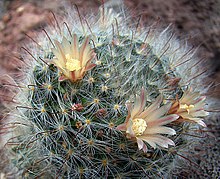

Кувшины вида Nepenthes ventricosa, как правило, имеют ярко выраженную локтевую форму .
V
[ редактировать ]- валлекулярный канал
- У семян Asteraceae смоляной канал, совпадающий с продольной бороздкой . Продольная полость в коре стеблей хвоща , совпадающая с бороздкой на поверхности стебля.
- ты охраняешь
- (чашелистиков и лепестков в бутоне) Смыкаются по краям, но не перекрываются.
- клапан
- Часть органа, которая фрагментируется или раскалывается, например, зубчатые части околоплодника в расколотой (раскрывшейся) капсуле или стручке при созревании.
- был
- Аббревиатура сортов .
- вариант
- Растение или группа растений, показывающая некоторую степень отличия от характеристик, связанных с конкретным таксоном .
- пестрый
- Неравномерно отмечены пятнами или пятнами другого цвета.
- сорта
Таксономический ранг ниже вида и между рангами подвида и формы .
- сосудистый
- Относительно проводящих тканей ( ксилемы и флоэмы ) сосудистых растений с.
- сосудистый пучок
- Пучок сосудистой ткани в первичных стеблях сосудистых растений , состоящий из специализированных проводящих клеток для транспорта воды ( ксилема ) и ассимилята ( флоэма ).
- судно
- Контейнер, используемый ботаниками для сбора полевых образцов.
- вена
Прядь сосудистой ткани, например, в листьях сосудистых растений .
- бутылка вина
- Маленькая вена ; конечное (видимое) разделение вены.
- крышка
- Губчатая ткань, покрывающая корни орхидей и воздушные некоторых других эпифитов .
- бархатистый
- Смотри бархатистый .
- бархатистый
- Густо покрыт тонкими, короткими, мягкими, стоячими волосками.
- жилкование
- Расположение жилок на листе.
- вентральный
- От латинского venter , что означает «живот». Противоположность спинному . Отчасти потому, что этот термин первоначально относился к животным, а не к растениям, его использование в ботанике произвольно в зависимости от контекста и источника. В целом «вентральный» относится к «брюху или нижней части», но в ботаническом использовании такие понятия не всегда четко определены и могут быть противоречивыми. Например:
- обращенный к оси ( адаксиальный ) в отношении бокового органа прямостоячего растения.
- лицом к субстрату в любой части прямостоячего растения, например нижней поверхности более или менее горизонтального листа ( абаксиального ).
- лицом к субстрату у стелющегося или вьющегося растения.
- вернация
- Расположение нераскрывшихся листьев в бутоне ; порядок раскрытия листьев из бутона.
- лакированный
- Имеющий блестящую или полированную поверхность, как будто покрытую лаком, и гладкую или гладкую текстуру. [51]
- вернониоид
- В семействе Asteraceae стиль с широкими волосками, расположенными на абаксиальных поверхностях ветвей столбика.
- бородавчатый
- По форме напоминает бородавку.
- бородавчатый
- Наличие бородавок.
- бородавчатый
- Мгновенная бородавка ; бородавчатые.
- универсальный
- ( пыльника ) Свободно раскачивается вокруг точки прикрепления к нити .
- мутовчатый
- Расположены в одном или нескольких мутовках , т. е. в нескольких одинаковых частях, расположенных в одной и той же точке оси , например, в листовом расположении. Сравните псевдовертицилляты (выглядящие мутовчатыми или мутовчатыми, но на самом деле это не так).
- вертициллез
- Тип псевдовертициллярного соцветия , типичный для яснотковых , у которого псевдомутовки образуются из пар противоположных цветочков .
- везикулярный
- (волос) Похож на пузырь; пузырчатый, с такими волосками.
- судно
- Капиллярная трубка, образованная рядом клеток с открытыми концами в проводящей воду ткани растения.
- рудиментарный
- Уменьшены по форме и функциям по сравнению с нормальным или наследственным состоянием.
- ворсинчатый
- Мелко ворсинчатая.
- ворсинчатый
- Обильно покрыты длинными, мягкими, прямыми волосками или покрыты ими; лохматый с мягкими волосками.
- лоза
- 1. скандирующие Растения , вьющиеся с помощью висячих или вьющихся стеблей или побегов .
- 2. Такой стебель или бегун. [28] [52]
- 3. Представитель рода Vitis .
- площадка
Палочковидные, ветвистые, особенно это касается прямостоячих, прямых стеблей. В микологии — шляпка с расходящимися ребрами или линиями.
- Зеленые растения
- Клада автотрофных организмов, включающая зеленые водоросли , Charophyta и наземные растения , все из которых имеют целлюлозу в клеточных стенках , хлоропласты , полученные в результате первичного эндосимбиоза с цианобактериями , которые содержат хлорофиллы a и b и лишены фикобилинов .
- скользкий
- Липкий; покрыты густым сиропообразным секретом.
- лента
Масляная трубка в плодах некоторых растений. [53]
- живородящий
- 1. Относится к семенам или плодам, которые прорастают до того, как опадают от материнского растения.
- 2. Развитие проростков на нецветковых органах, например на листьях.
- Микрофотография поперечного среза сосудистого пучка стебля типичного травянистого двудольного растения.А: Флоэма
Б: Камбий
C: Ксилема
D: Фиброзная оболочка сосудистого пучка. - Вертициллез Salvia yangii
- Вертициллярные листья и появляющиеся веточки разнотравья .
- Спаржа virgatus получила свое специфическое название virgatus из-за ветвистого вида ее виргатных побегов.
В
[ редактировать ]- сторожить
- Поверхность, покрытая небольшими круглыми выпуклостями, особенно на плодах, листьях, ветках и коре. См. туберкулезный .
- водная съемка
- Прямостоячий развивающийся , сильнорастущий или эпикормный побег, у основания кустарника или дерева, но отличающийся от присоски .
- сорняк
- 1. Любое растение, растущее там, где оно нежелательно; обычно ассоциируется с разрушенной средой обитания. См. также рудеральный .
- 2. Нежелательное растение, произрастающее среди сельскохозяйственных культур .
- 3. Натурализованный, экзотический или экологически «несбалансированный» аборигенный вид вне сельскохозяйственного или садового контекста, который в результате инвазии отрицательно влияет на выживание или регенерацию аборигенных видов в естественных или частично естественных растительных сообществах. . [54]
- дикий
- Происходит из известной дикой или чисто естественной среды обитания ( дикой природы ).
- завиток
- Кольцо органов, расположенных на одном уровне оси ( например, листья , прицветники или части цветка).
- крыло
- 1. Мембранное расширение плода или семени, способствующее распространению, например, на сосны . семенах
- 2. Тонкий выступ ткани, выходящий за пределы нормального контура структуры, например, на колонне некоторых орхидей , на стеблях, на черешках.
- 3. Один из двух боковых лепестков цветка подсемейства Faboideae семейства Fabaceae , расположенный между адаксиальным стандартным (баннерным) лепестком и двумя абаксиальными килевыми лепестками.
- древесный
- твердый и одревесневший ; не травянистый
- шерстистый
- мохнатый
- Очень густо покрыт длинными, более или менее спутанными или переплетенными волосками, напоминающими овечью шерсть .
- Уотершот с
- Крылатые семена Catalpa bignonioides почти полностью крылатые. Пучки на концах увеличивают аэродинамическое сопротивление , тем самым улучшая рассеивание ветра.
- Листья некоторых видов цитрусовых имеют крылатые черешки.
- Листья Senecio haworthii имеют необычайно густую шерстистую оболочку.
Х
[ редактировать ]- ксероморф
- Растение со структурными особенностями (например, твердыми или сочными листьями) или функциональными приспособлениями, предотвращающими потерю воды за счет испарения; обычно ассоциируется с засушливыми местами обитания, но не обязательно устойчив к засухе. Сравните ксерофит .
- ксерофит
- Растение, обычно живущее в засушливой среде обитания, обычно проявляющее ксероморфную или суккулентную адаптацию; растение, способное переносить длительные периоды засухи. Сравните ксероморфов .
- ксилема
- Специализированная водопроводящая ткань сосудистых растений .
С
[ редактировать ]- зонировать
- Имеют светлые и темные круглые полосы или кольца, обычно на листьях или цветах.
- зигоморфный
- Двусторонне симметричный; симметричен только относительно одной вертикальной плоскости; относится к цветам, у которых сегменты околоцветника в каждом мутовке различаются по размеру и форме. В отличие от актиноморфных и неправильных .
- зигота
- Оплодотворенная клетка, продукт слияния двух гамет .
- Зонатные отметины на листьях садовой разновидности Pelargonium zonale.
- Как и большинство представителей рода Pelargonium и в отличие от большинства представителей рода Geranium , Pelargonium quercifolium имеет цветки, двусторонне-симметричные . Соответственно, поскольку ярмо быка двусторонне симметрично, такие цветы называются зигоморфными , что буквально означает «ярмообразный».
См. также
[ редактировать ]- Цветочная формула - сокращения, используемые для описания частей цветка.
- Глоссарий биологии
- Глоссарий морфологии растений
- Глоссарий морфологии листьев
- Словарь терминов по лишайнику
- Глоссарий микологии
- Глоссарий научных названий
- Морфология растений
Ссылки
[ редактировать ]- ^ Новый Оксфордский словарь, версия 1, 2007 г. , стр. 2.
- ^ Jump up to: а б с Харрис и Харрис 2001 , с. 3.
- ^ Новый Оксфордский словарь, версия 1, 2007 г. , стр. 7.
- ^ Новый Оксфордский словарь, версия 1, 2007 г. , стр. 8.
- ^ Шрив и Виггинс 1964 , с. 738.
- ^ Шрив и Виггинс 1964 , с. 355.
- ^ Шрив и Виггинс 1964 , с. 351.
- ^ Новый Оксфордский словарь, версия 1, 2007 г. , стр. 16.
- ^ Турланд и др. 2018 , Статья 18 .
- ^ ИПНИ 2022 .
- ^ Jump up to: а б Харрис и Харрис 2001 , с. 4.
- ^ Харрис и Харрис 2001 , стр. 4–5.
- ^ Jump up to: а б с д и ж г час я Харрис и Харрис 2001 , с. 5.
- ^ Симс 1803 , [стр. 93] .
- ^ Харрис и Харрис 2001 , с. 6.
- ^ Капперс и Ниф 2012 , с. 95.
- ^ Пелл и Энджелл, 2016 , с. 15.
- ^ Пелл и Энджелл, 2016 , с. 16.
- ^ Пелл и Энджелл, 2016 , с. 17.
- ^ Пелл и Энджелл, 2016 , с. 20.
- ^ Пелл и Энджелл, 2016 , с. 24.
- ^ Пелл и Энджелл, 2016 , с. 27.
- ^ Пелл и Энджелл, 2016 , с. 35.
- ^ Пелл и Энджелл, 2016 , с. 39.
- ^ Jump up to: а б Пелл и Энджелл, 2016 , с. 41.
- ^ Пелл и Энджелл, 2016 , с. 46.
- ^ Пелл и Энджелл, 2016 , с. 47.
- ^ Jump up to: а б с д и Джексон 1928 год .
- ^ Jump up to: а б Егерь 1959г .
- ^ Пелл и Энджелл, 2016 , с. 58.
- ^ Бентдже 2010 , с. 33.
- ^ Jump up to: а б Ханзава, Битти и Холмс, 1985 .
- ^ Пелл и Энджелл, 2016 , с. 78.
- ^ Jump up to: а б Шульце и Цвельфер 2012 , с. 261.
- ^ Пелл и Энджелл, 2016 , с. 83.
- ^ Скопировано определение факультативного прилагательного по биологии из статьи в Викисловаре. Посмотрите историю этой страницы, чтобы узнать атрибуцию.
- ^ Скопировано определение фимбриатного биологического прилагательного из статьи в Викисловаре. Посмотрите историю этой страницы, чтобы узнать атрибуцию.
- ^ Рендл 1911 .
- ^ Jump up to: а б Кэролин и Тиндейл 1994 , с. 23.
- ^ Бентдже 2010 , с. 67.
- ^ «Глоссарий: П» . Иди в Ботанику . Фонд местных растений. Архивировано из оригинала 28 сентября 2023 года . Проверено 4 января 2024 г.
- ^ Мееров и др. 1999 .
- ^ Экенвальдер 2009 , стр. 648–661.
- ^ Пелл и Энджелл, 2016 , с. 169.
- ^ Jump up to: а б Бентдже 2010 , с. 107.
- ^ Куцевич, Мацкевич и Ррубек-Сокольник 2010 .
- ^ Броди 1951 .
- ^ Пляж 1914а .
- ^ Пляж 1914б .
- ^ «туберкулезный» . Словарь ботаники . Проверено 7 января 2024 г.
- ^ Харрис и Харрис 2001 , с. 132.
- ^ Новый Оксфордский словарь, версия 2, 2007 г. , стр. 3534.
- ^ Бентдже 2010 , с. 129.
- ^ Карр, GW, в Foreman & Walsh, 1993.
Библиография
[ редактировать ]- Аллаби, Майкл (2012). Словарь наук о растениях . Издательство Оксфордского университета . ISBN 978-0-19-960057-1 – через Google Книги (только предварительный просмотр) .
- Бич, Чендлер Б., изд. (1914а). « Тетрад ». Справочник нового студента . Чикаго: FE Compton and Co.
- Бич, Чендлер Б., изд. (1914б). « Тетраспора ». Справочник нового студента . Чикаго: FE Compton and Co.
- Бентье, Хенк (2010). Глоссарий растений Кью, иллюстрированный словарь терминов, связанных с растениями . Ричмонд, Лондон: Издательство Кью . ISBN 978-1-84246-422-9 .
- Броди, Гарольд Дж. (май 1951 г.). «Механизм распространения брызг у растений» . Канадский журнал ботаники . 29 (3). Оттава, Онтарио: Canadian Science Publishing : 224–234. дои : 10.1139/b51-022 .
- Капперс, Рене Т.Дж.; Ниф, Рейндер (2012). Справочник по палеоэкологии растений . Издательство Баркуис. ISBN 9789492444264 – через Google Книги (только предварительный просмотр) .
- Кэролин, Роджер С .; Тиндейл, Мэри Д. (1994). Флора региона Сиднея (4-е изд.). Чатсвуд, Новый Южный Уэльс: Рид. ISBN 0730104001 . ОСЛК 32821788 .
- Дон, Джордж (1831). Всеобщая история дихламидных растений... расположенных в соответствии с естественной системой . Том. 1. Лондон . Получено 15 декабря 2022 г. - из Библиотеки наследия биоразнообразия .
- Экенвальдер, Джеймс Э. (2009). Хвойные деревья мира: Полный справочник . Лондон: Тимбер Пресс . ISBN 978-0-88192-974-4 .
- Гиффорд, Эрнест М.; Фостер, Адрианс С. (1989). Морфология и эволюция сосудистых растений (3-е изд.). У. Х. Фриман . ISBN 978-0-7167-1946-5 .
- Ханзава, Фрэнсис М.; Битти, Эндрю Дж.; Холмс, Энн (ноябрь 1985 г.). «Двойная функция элайосомы Corydalis aurea (Fumariaceae): привлечение агентов распространения и отталкивание Peromyscus maniculatus , семенного хищника». Американский журнал ботаники . 72 (11). Сент-Луис, штат Миссури: Ботаническое общество Америки : 1707–1711. дои : 10.1002/j.1537-2197.1985.tb08442.x . JSTOR 2443727 .
- Харрис, Джеймс Г.; Харрис, Мелинда Вульф (2001). Терминология идентификации растений: иллюстрированный глоссарий (2-е изд.). Спринг-Лейк, Юта, США: Spring Lake Publishing. ISBN 0-9640221-6-8 .
- Хикки, Майкл; Кинг, Клайв (2000). Кембриджский иллюстрированный словарь ботанических терминов . Кембридж, Англия: Издательство Кембриджского университета . ISBN 978-0-521-79401-5 – через Google Книги .
- Хьюз, Колин (2017). «О проекте «Полевые гиды»» . Виртуальный полевой гербарий (herbaria-old.plants.ox.ac.uk) . Гербарии Оксфордского университета . Архивировано из оригинала 5 марта 2017 года . Проверено 4 марта 2017 г.
- * «Характеристика растений» . Виртуальный полевой гербарий (herbaria-old.plants.ox.ac.uk) . Архивировано из оригинала 5 марта 2017 года . Проверено 4 марта 2017 г. В Хьюзе (2017) .
- ИПНИ (2022). «Rosaceae Juss., Gen. Pl. [Jussieu] 334 (1789), ном. минусы» . Международный указатель названий растений (IPNI) . Королевский ботанический сад, Кью ; Гербарии и библиотеки Гарвардского университета ; Австралийский национальный ботанический сад . Проверено 24 декабря 2022 г.
- Джексон, Бенджамин Дейдон (1928). Словарь ботанических терминов с их происхождением и акцентом . Нью-Йорк: Hafner Publishing Co. Inc. Получено 15 декабря 2022 г. - из Библиотеки наследия биоразнообразия .
- Джагер, Эдмунд Кэрролл (1959). Справочник биологических названий и терминов . Спрингфилд, Иллинойс, США: Томас. ISBN 978-0-398-06179-1 – через Интернет-архив .
- Куцевич, Магдалена; Мацкевич, Катажина; Ррубек-Сокольник, Анна (2010). «Отдельные аспекты экологии семян вики крошечной [ Vicia hirsuta (L.) Grey SF]: генеративное размножение и влияние зрелости семян и хранения семян на прорастание семян» . Акта Агроботаника . 63 (1). Варшава: Польское ботаническое общество: 205–212. дои : 10.5586/aa.2010.023 .
- Леллингер, Дэвид Б. (2002). Современный многоязычный глоссарий по таксономической птеридологии (Pteridologia) (на английском, испанском, французском и португальском языках). Том. 3. Американского общества папоротников, Inc. ISBN 978-0-933500-02-0 . Получено 15 декабря 2022 г. - из Библиотеки наследия биоразнообразия .
- Мироу, Алан В .; Фэй, Майкл Ф .; Гай, Чарльз Л.; Ли, Цинь-Бао; Заман, Фарида К.; Чейз, Марк В. (сентябрь 1999 г.). «Систематика Amaryllidaceae, основанная на кладистическом анализе данных о последовательностях пластид». Американский журнал ботаники . 86 (9). Сент-Луис, штат Миссури: Ботаническое общество Америки : 1325–1345. дои : 10.2307/2656780 . JSTOR 2656780 . ПМИД 10487820 .
- Неотропикей (2017). «Словарь ботанических терминов» . www.kew.org . Королевский ботанический сад, Кью . Архивировано из оригинала 21 января 2017 года . Проверено 18 февраля 2017 г.
- Новый краткий Оксфордский словарь английского языка по историческим принципам (AM) . Том. 1 (6-е изд.). Оксфорд, Англия: Издательство Оксфордского университета . 2007. ISBN 978-0-19-920687-2 . Проверено 17 декабря 2022 г. - из Интернет-архива .
- Новый краткий Оксфордский словарь английского языка по историческим принципам (N – Z) . Том. 2 (6-е изд.). Оксфорд, Англия: Издательство Оксфордского университета . 2007. ISBN 978-0-19-920687-2 . Проверено 16 декабря 2022 г. - из Интернет-архива .
- НЙБГ (2019). «Глоссарий сосудистых растений» . Гербарий Уильяма и Линды Стир, Ботанический сад Нью-Йорка . Проверено 20 сентября 2019 г.
- Пелл, Сьюзен К.; Энджелл, Бобби (2016). Словарь ботаника: 1300 объясненных и иллюстрированных терминов . Портленд, Орегон, США: Timber Press . ISBN 978-1-604-69563-2 .
- Рендл, Альфред Бартон (1911). « Фрукты ». В Чисхолме, Хью (ред.). Британская энциклопедия . Том. 11 (11-е изд.). Издательство Кембриджского университета. стр. 257–258.
- Шульце, Эрнст-Детлеф; Цвёлфер, Хельмут, ред. (2012). Потенциалы и ограничения экосистемного анализа, исчезновения и натурализации видов растений . Шпрингер Берлин Гейдельберг . ISBN 9783642716300 . Проверено 16 декабря 2022 г. - через Google Книги (только предварительная версия) .
- Шрив, Форрест ; Виггинс, Ира Л. (1964). Растительность и флора пустыни Сонора . Том. 1. Стэнфорд, Калифорния, США: Издательство Стэнфордского университета . ISBN 9780804701631 . OCLC 710084 — через Интернет-архив .
- Симпсон, Майкл Г. (август 2011 г.). Систематика растений . Академическая пресса . ISBN 978-0-08-051404-8 – через Google Книги (только предварительный просмотр) .
- Симс, Джон (1803). Ботанический журнал Кертиса, или Показан цветник: в котором наиболее декоративные зарубежные растения, выращиваемые в открытом грунте, теплице и печи, точно представлены в их естественных цветах ... Том. 17. Лондон: Т. Кертис . Проверено 15 декабря 2022 г. - через Google Книги .
- Стерн, Уильям Т. (1983). Ботаническая латынь (3-е изд.). Ньютон-Эббот, Лондон и Норт-Помфрет, Вермонт, США: Дэвид и Чарльз . ISBN 0-7153-8548-8 . Проверено 15 декабря 2015 г. - из Интернет-архива .
- Терланд, Нью-Джерси; Виерсема, Дж. Х.; Барри, Франция; Гройтер, В.; Хоксворт, ДЛ; Херендин, PS; Кнапп, С.; Касбер, В.-Х.; Ли, Д.-З.; Мархольд, К.; Мэй, ТВ; Макнил, Дж.; Монро, AM; Прадо, Дж.; Цена, МДж; Смит, Г. Ф., ред. (2018). Международный кодекс номенклатуры водорослей, грибов и растений (Шэньчжэньский кодекс), принятый Девятнадцатым Международным ботаническим конгрессом в Шэньчжэне, Китай, июль 2017 г. Регнум Вегетабил. Том. 159. Гласхюттен, Германия : Ботанические книги Кельца. дои : 10.12705/Код.2018 . ISBN 978-3-946583-16-5 . OCLC 1043552267 . Проверено 21 декабря 2022 г.
Внешние ссылки
[ редактировать ]Найдите категорию:li:Растения в Викисловаре, бесплатном словаре.
- Глоссарий в APweb
- Глоссарий ботанических терминов ( на английском языке во Флоре и т. д. )
- Садовая паутина
- еФлорас
- Категориальный глоссарий проекта «Флора Северной Америки»
Королевский ботанический сад в Кью
[ редактировать ]Австралия и Новая Зеландия
[ редактировать ]- Сиднейский университет: Эфлора — глоссарий
- Флорабаза (Западная Австралия)
- Интернет-словарь «Флора Австралии»
- Флора Австралии Сокращения
- Флора Южной Австралии
- Ботаника «Слово дня» — с иллюстрациями уроженцев Новой Зеландии.
- Сеть охраны растений Новой Зеландии
Африка
[ редактировать ]- Герман, PPJ (2015). «Ботанический глоссарий» (PDF) . САНБИ . Архивировано из оригинала (PDF) 18 октября 2020 года . Проверено 21 мая 2020 г.
- Растения юга Африки ( Архивировано 17 октября 2016 г. в Wayback Machine )


























